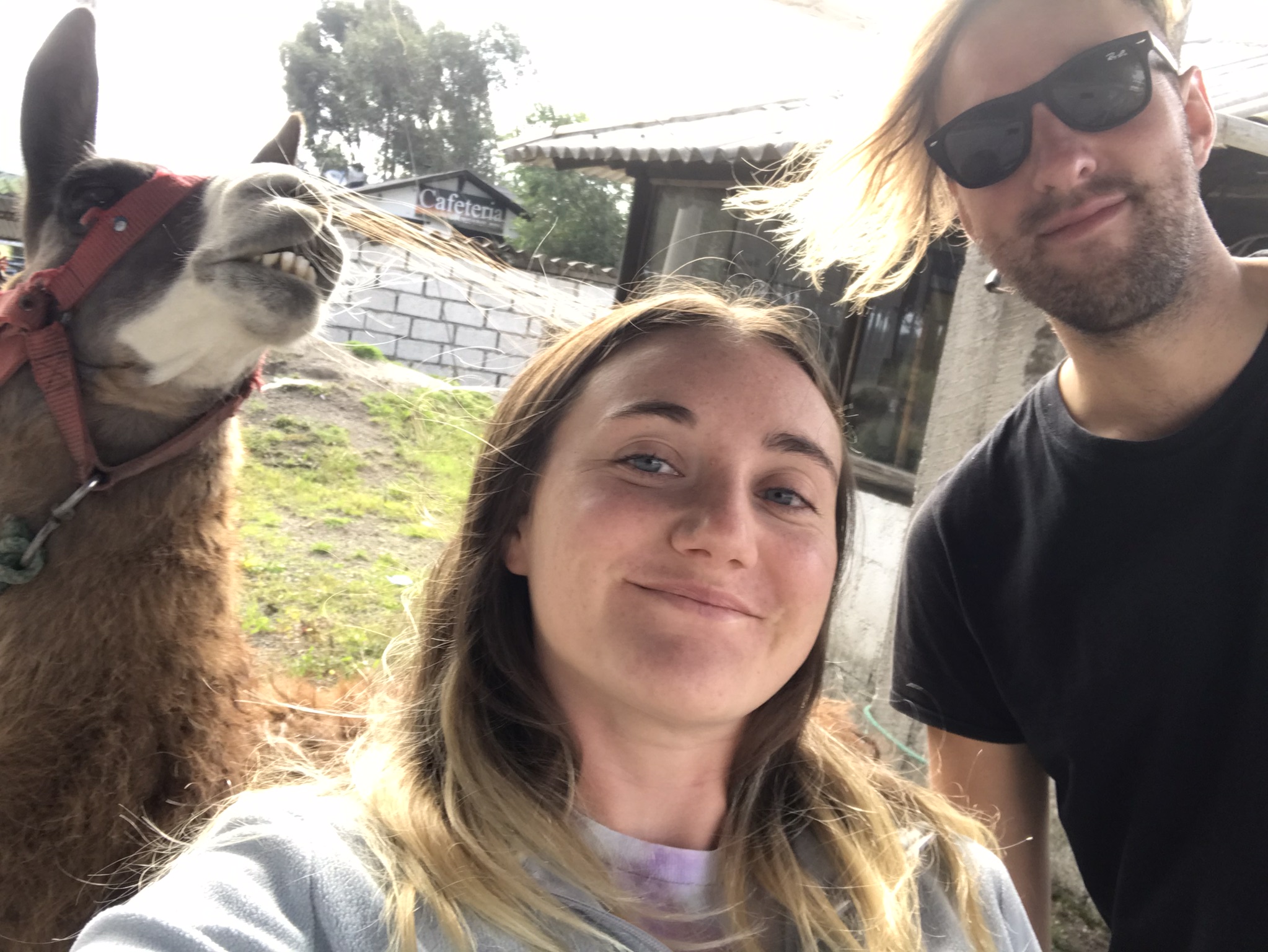Most travellers who have visited Pakistan will tell you that it is one of the most misunderstood countries in the world. It is home to a vast array of cultures and landscapes and some of the most friendly and hospitable people that we have ever encountered. We were blown away by what it had to offer, and we only really scratched the surface. Check out my Pakistan travel experiences below.
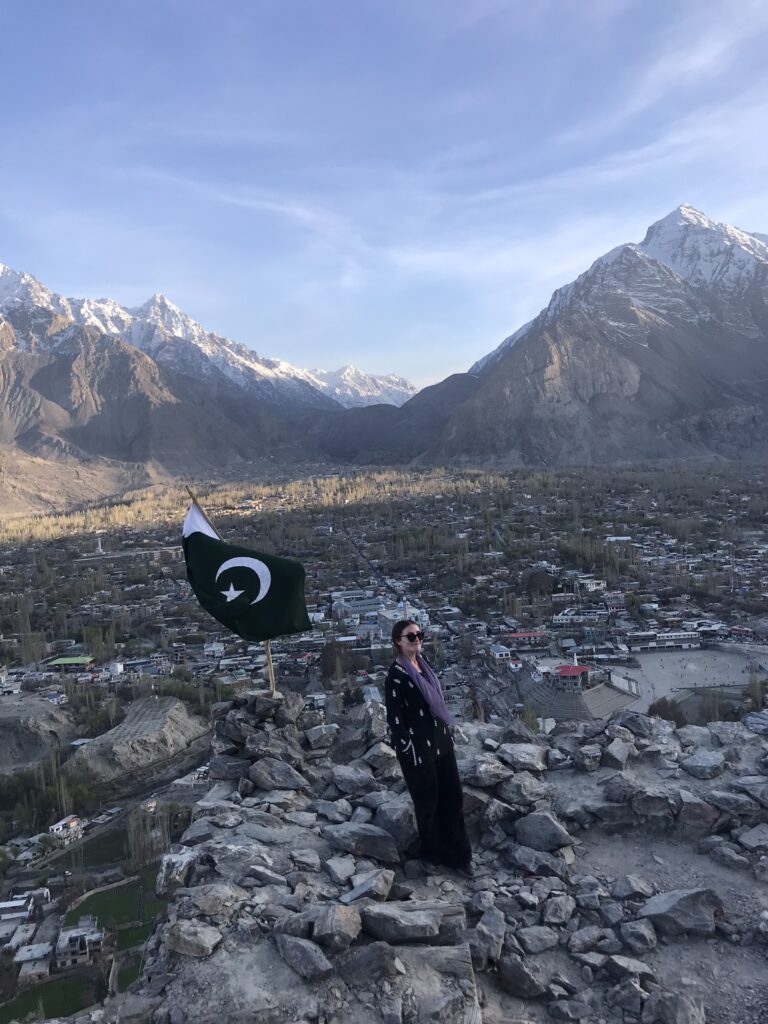
Lahore, Islamabad, Skardu, Gilgit, Karimabad
The modern nation of Pakistan was created as a result of the Partition of India in 1947, in which the territory of British India was separated along religious lines. Muhammad Ali Jinnah, known locally as Quaid-e-Azam (“great leader”), is considered the father of the nation in Pakistan. As the leader of the All-India Muslim League in the early 20th century, he was a major player in pushing for the partition of India and the creation of a separate Muslim state. He believed that if India remained as one large country, then Muslims would never be able to have a meaningful say in the government as a religious minority in a Hindu majority country. Sadly, like his Indian counterpart Mahatma Gandhi, Jinnah died shortly after independence and so never truly got to see his vision come to fruition. You can spot his likeness on all of the Pakistani rupee banknotes. I couldn’t stop thinking that he bore a slight resemblance to David Bowie.
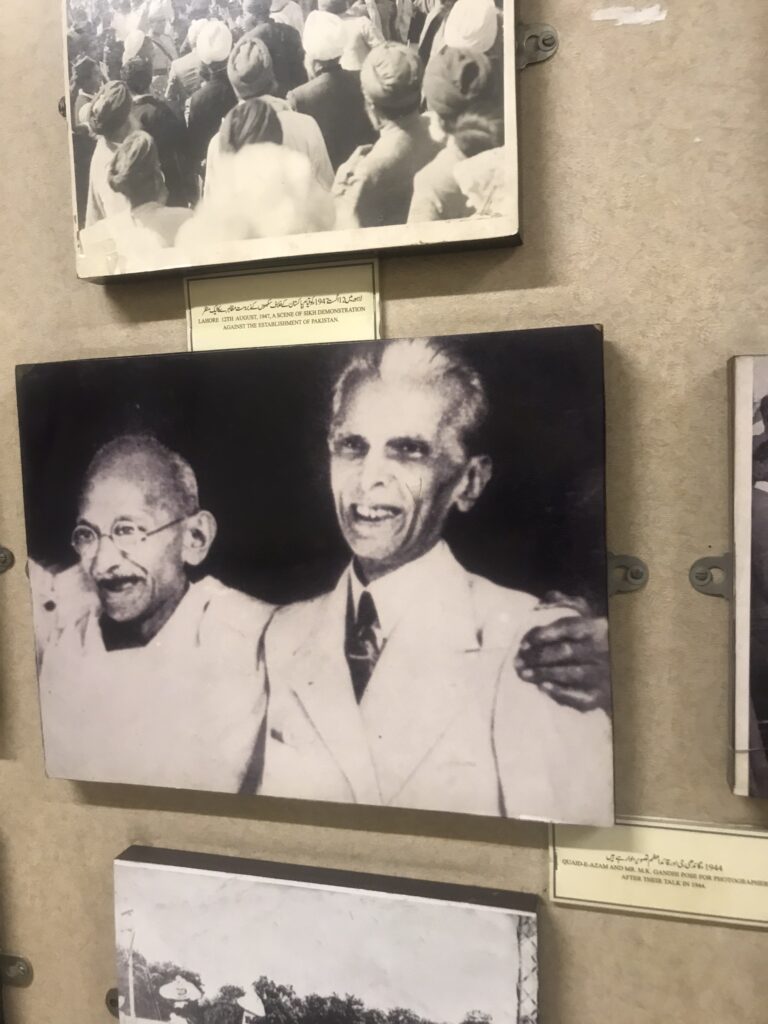
Jinnah holds the same reverence in Pakistan as Gandhi does in India
Because of their shared history, there are plenty of similarities between Indian and Pakistan. Both love cricket, both have similar cuisine, both were part of the British and Mughal empires and have plenty of remnants from those eras. Both Pakistan and India have a state called Punjab, and locals in both states even speak the same language – Punjabi.
Despite all this, it’s fair to say that Pakistan and India don’t exactly get along. This has been the case ever since the Partition, when rioting and religious violence lead to countless deaths on both sides. These days most of the problems tend to revolve around Kashmir, the beautiful mountainous region to the north of both countries. Because of some confusion at the time of the Partition, this region is claimed in full by both India and Pakistan (and also partly claimed by China).

The Pakistani part of Kashmir includes Gilgit-Baltistan, containing the Hunza Valley
In reality, Kashmir is split between India and Pakistan – the Indian section comprises the Indian states of Jammu & Kashmir and Ladakh, while the Pakistan side consists of the regions of Azad Kashmir and Gilgit-Baltistan. The border between India and Pakistan in Kashmir is known as the ‘line of control’, as neither side wants to acknowledge that it is a real border (in contrast, the border between Pakistan and China in Gilgit-Baltistan is a normal, functioning border). There is palpable ill feeling on both sides. Indian Bollywood movies still contain stereotypical depictions of Pakistani villains, fuelling hatred. Relations are frosty and can become heated, sometimes boiling over. Border skirmishes occur from time-to-time.
We entered Pakistan from India via the Wagah land border crossing between Amritsar and Lahore, which was closed a few weeks after we visited. Click here for my blog post about the experience. People in India were shocked when we said that we would be visiting Pakistan and told us that we would immediately be abducted by terrorists. We weren’t; however I can confirm that traveling in Pakistan is a very different experience to traveling in India.
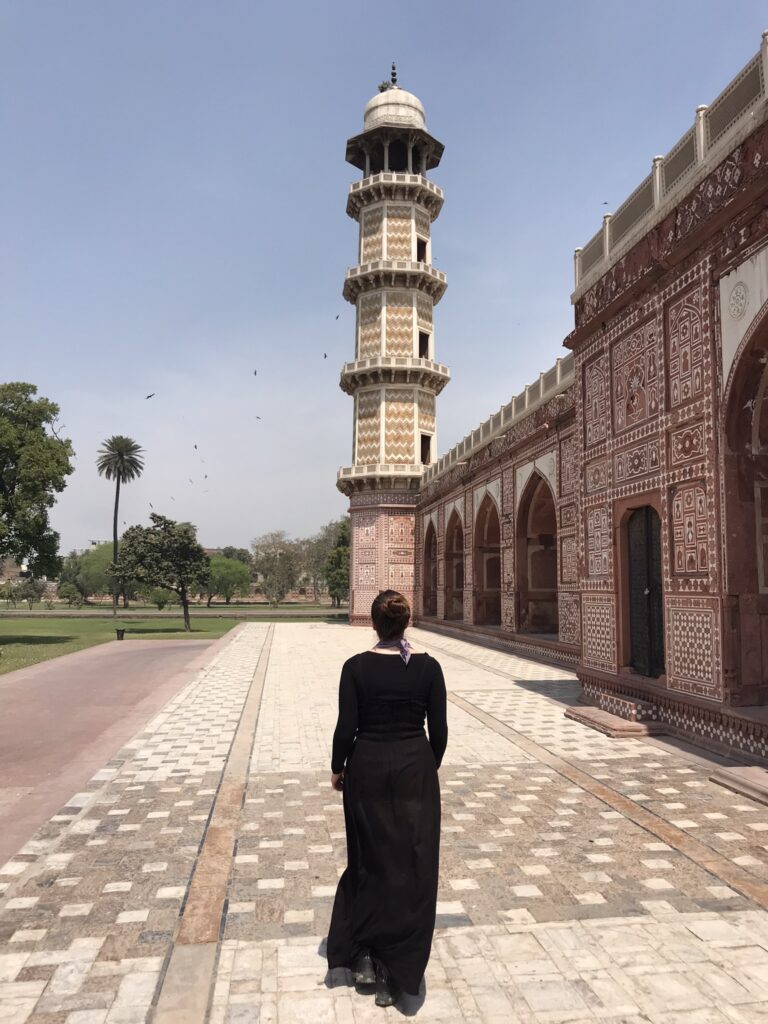
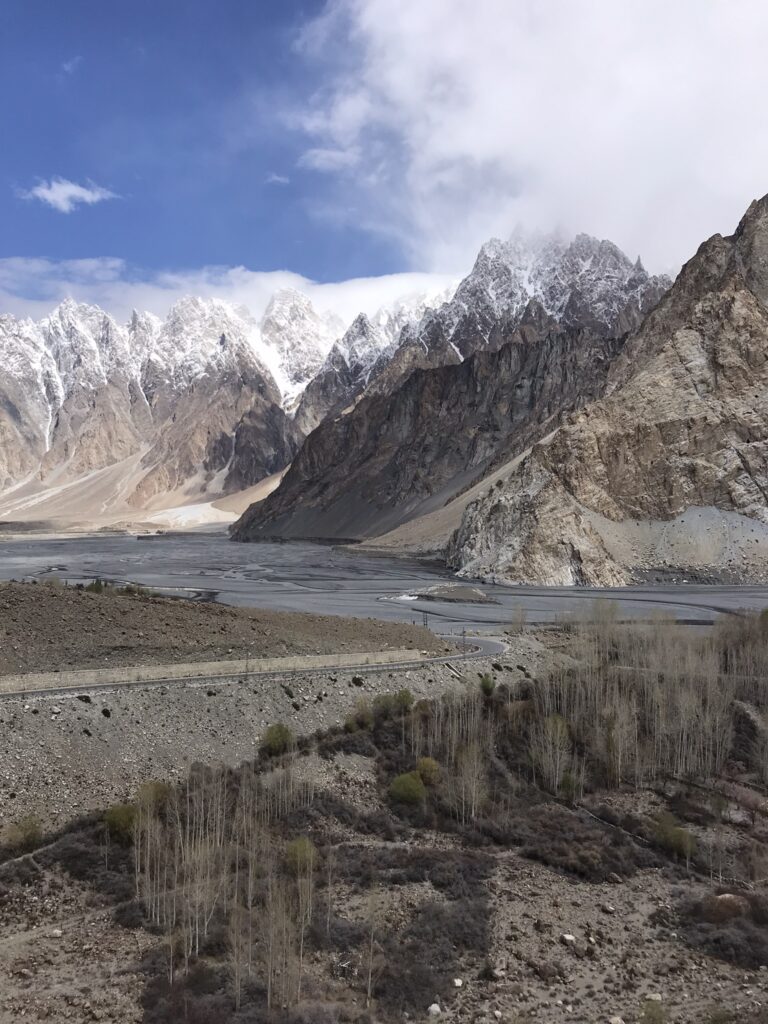
Pakistan is home to a wide variety of landscapes and cultures
Geography & culture
Pakistan is a land of snow-topped mountains, vast plains, rich river deltas and desolate deserts. It is a land of opposites, with fresh snow falling in Gilgit-Baltistan on the same day as the temperature hits 38 degrees celsius in Lahore. It has some daunting neighbours in the shape of China to the north-east, India to the east, Afghanistan along its north-west border and Iran to the west.
Pakistan lays claim to the second tallest mountain in the world – K2 (or Karakoram 2), which has a higher mortality rate for climbers than Everest. The Karakoram mountain range to which K2 belongs dominates the north of the country alongside the Hindukush and Himalayan ranges. Balochistan to the south-west is framed by arid desert and touches the Arabian sea. The Indus river basin between these areas cuts through the center of Pakistan like a spine descending from the mountains. Over 5,000 years ago, this great river delta was one of the cradles of civilization for the Harappa people, otherwise known as the Indus Valley civilization – this is one of the three recognised early civilisations in the world, alongside Egypt and Mesopotamia. Interestingly the name ‘India’ comes from the Indus river, although it now only flows through a small part of the territory of India in the Indian-administered part of Kashmir.
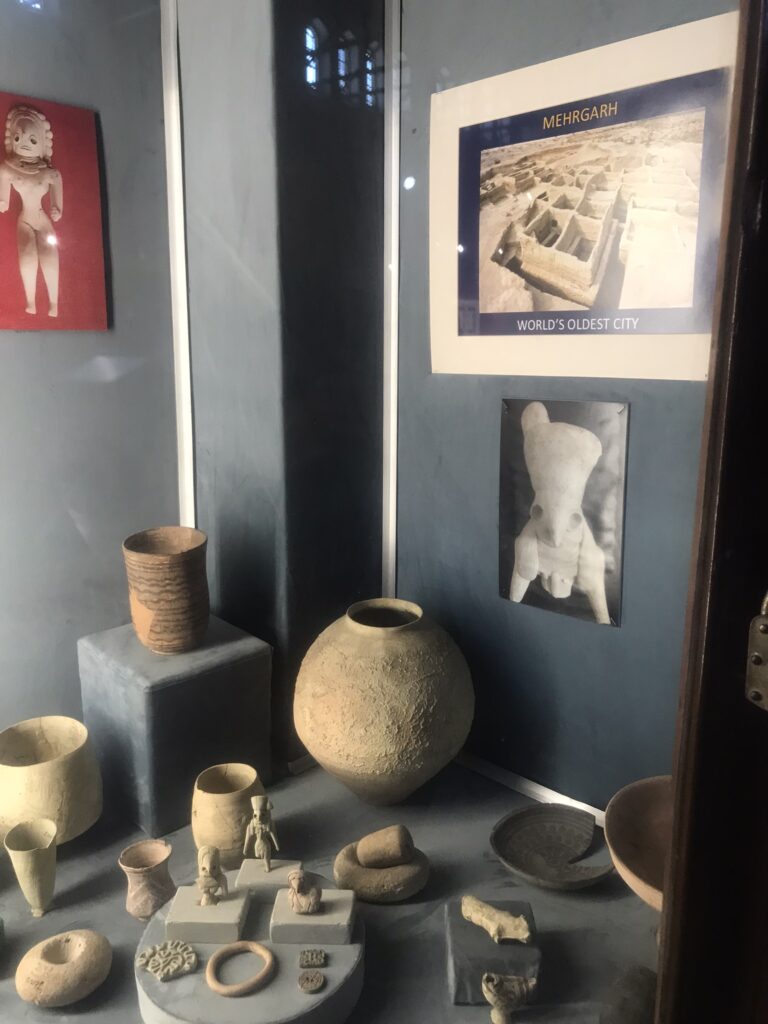
The Indus Valley Civilisation is one of the oldest in the world
Pakistan is especially fascinating for the diverse and unique communities of people who continue to live undisturbed in remote regions, such as the Wakhi and Balti in Gilgit-Baltistan and Balochi people in Balochistan – preserving their distinct culture (language, dress, beliefs, traditions, crafts and way of life). Many of these groups have been studied by anthropologists in an effort to document their cultural identity before it is lost. Check out Asra Hussain’s Youtube page for her experience with the Wakhi and Burusho People.
Pakistan is not one homogenous nation – ethnically, linguistically or religiously. In Lahore, the local population speak Punjabi as their first language and retain a similarity in character and culture with their Indian Punjabi neighbours. Languages like Pashto and Sindhi dominate the north-west state of Khyber Pakhtunkhwa and the south-east state of Sindh respectively. In Gilgit-Baltistan, there are a myriad of local languages spoken such as Wakhi, Burushaski and Shina alongside the national language, Urdu. Local people literally look different in the Karakoram mountains with fairer complexions, blue eyes and even ginger hair and beards on occasions. We saw local people in the mountains that we thought looked more Irish or Scottish than typically Pakistan in appearance. While the majority of Pakistanis are Sunni Muslims, the Ismaili Shi’ite branch of Islam is dominant in some parts of Gilgit-Baltistan, with an outwardly more liberal version of Islam practised.
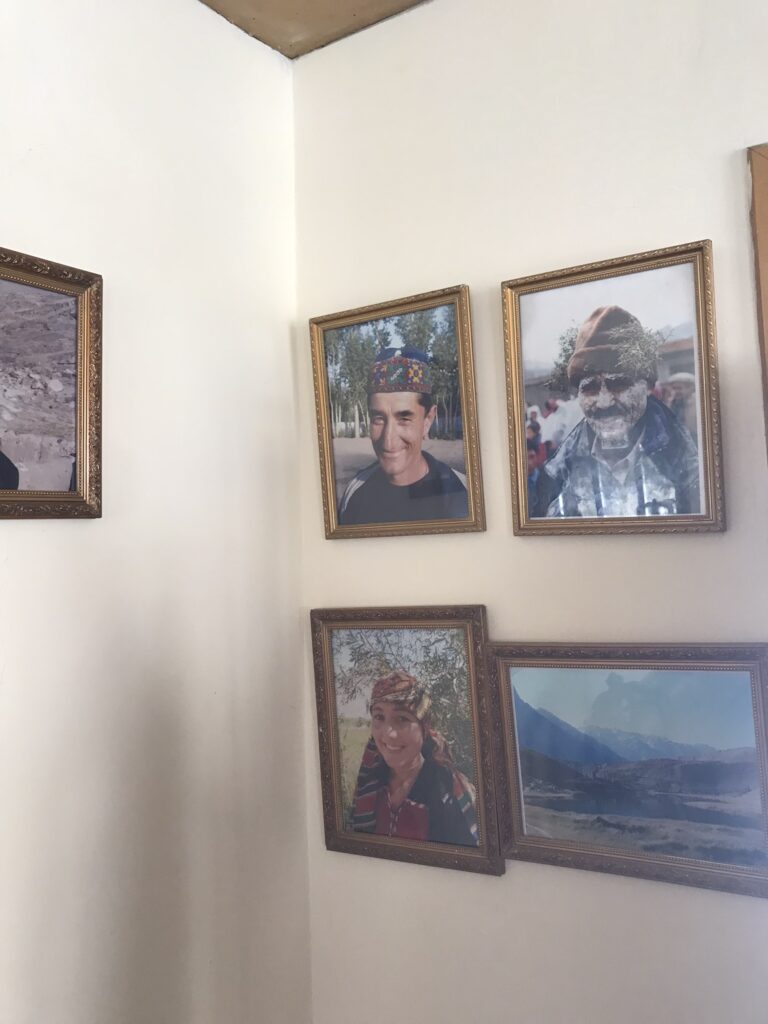
There are many different ethnic groups in Pakistan, each with their own culture and traditions
The national and unifying language of Pakistan is Urdu, which shares some similarities with Hindi (the national language of India) – the biggest difference is that Urdu is written in a modified version of the Arabic script, making it impossible for Hindi speakers to read. Urdu is not a first language for many Pakistanis, but it is widely understood by most of the population. Even though Urdu is the national language, we were surprised by how widely English was spoken. Interestingly, like in India, English is still one of the official languages of Pakistan and used by the government for the drafting of new legislation and laws, as well as playing a prominent role in education. We found that in general the levels of English seemed to be much higher in Pakistan than in neighbouring India – at least in the places that we visited.
Pakistani cuisine is very meat heavy with local specialities in each region. We particularly enjoyed handi (an often-boneless Pakistani curry), karahi (another Pakistani curry usually with chicken) and biryani – these were popular dishes everywhere we visited. It was nice to sink our teeth into some beef after some months spent in India. Barbequed meat and kebabs are also very popular in Pakistan.
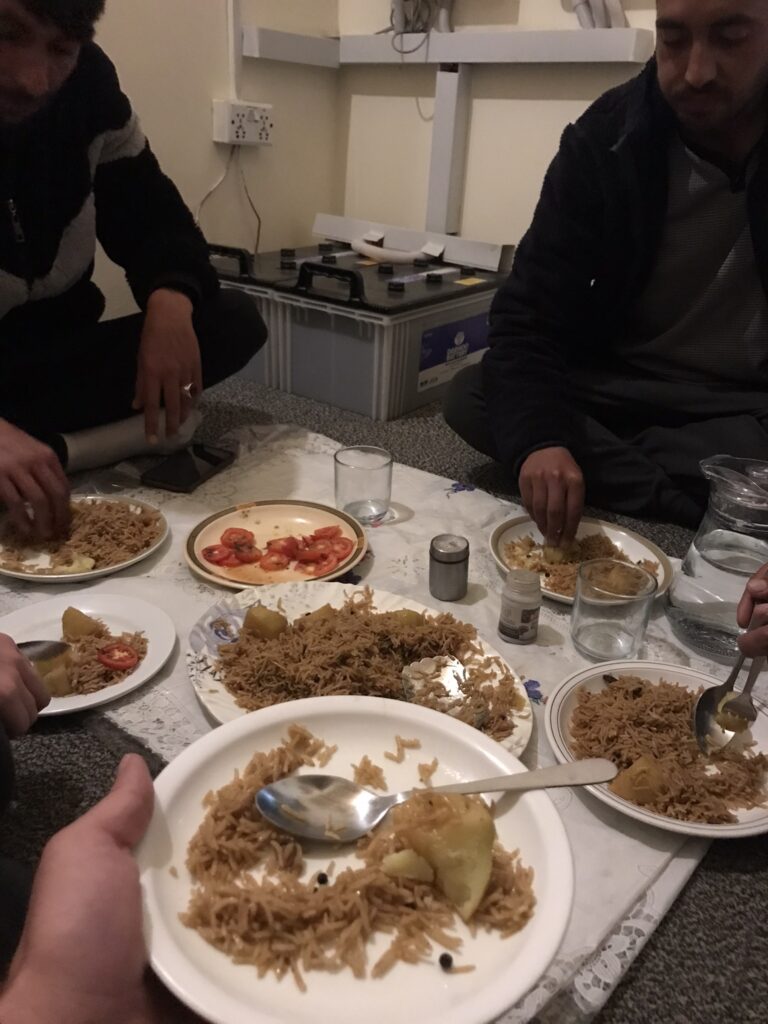
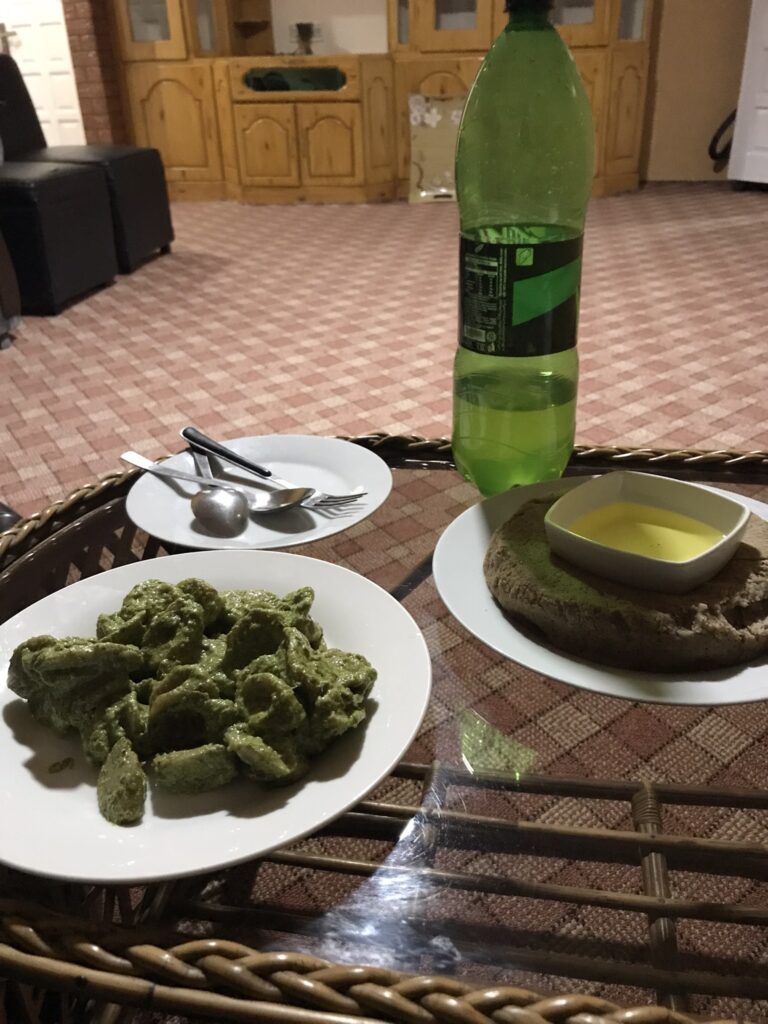
Cuisine in Pakistan ranges from classic favourites like biryani to obscure regional foods like this extremely heavy local dish we had in Skardu
Where to visit?
The number one question we were asked when we mentioned that we were visiting Pakistan was “is it safe?”. And the answer is yes, to an extent. Some parts of Pakistan are definite no-go areas, while other parts of the country are contentious and may be difficult for foreign travellers. However, there are definitely parts of Pakistan that can be visited independently with no problems – in fact these happen to be some of the most rewarding parts of the country!
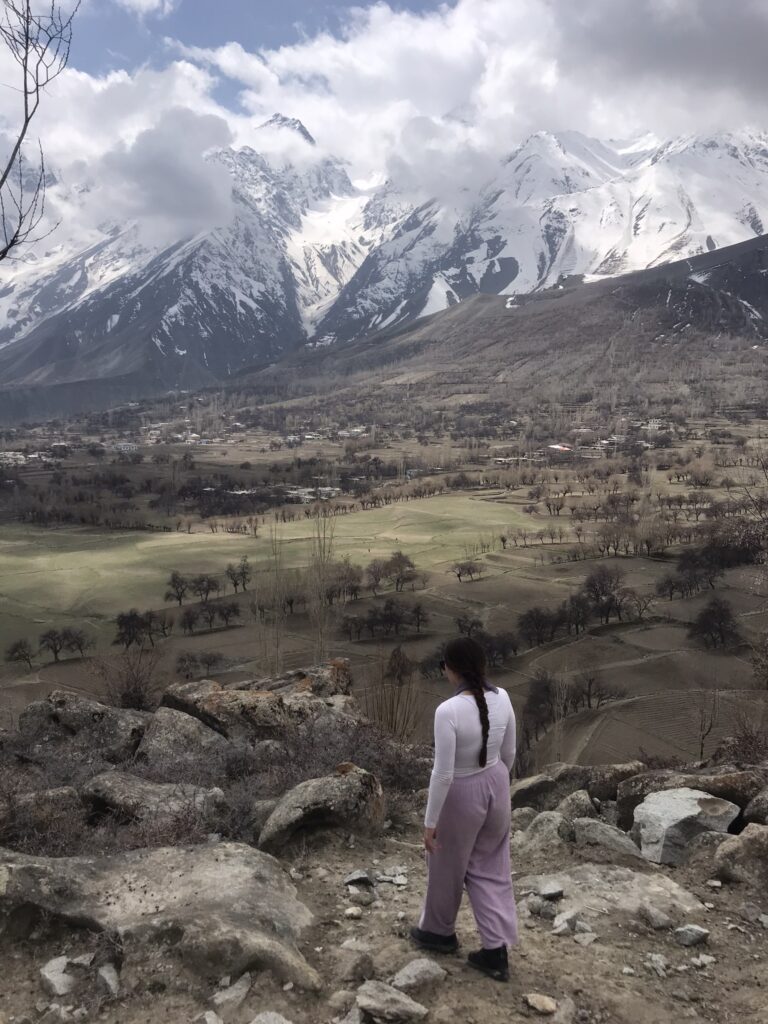
Gilgit-Baltistan is a spectacular region and totally safe to visit
We spent most of our time in Pakistan in the Gilgit-Baltistan region. Although it’s a part of the disputed territory of Kashmir, Gilgit-Baltistan is arguably the safest part of the country to visit and also the area with the most tourist infrastructure. The cooler climates in the region make it a popular domestic tourist destination, heaving with Pakistanis from Punjab and Sindh during the scorching hot summer months in those states. Filled with snow-capped mountains, rivers and alpine plains, it’s also one of the most beautiful places with some of the most breathtaking landscapes in the world.
As well as Gilgit-Baltistan, we also visited the cities of Lahore and Islamabad. These cities are a little more cosmopolitan, have relatively liberal populations by Pakistani standards and are therefore seen to be more accessible for foreign visitors. I can happily vouch for all these places being safe and welcoming for foreign visitors, as long as you use your common sense. The friendly welcome and hospitality we received from the Pakistan people in the regions we visited was second to none. People seemed legitimately pleased to see us and eager to ensure we were happy and safe.
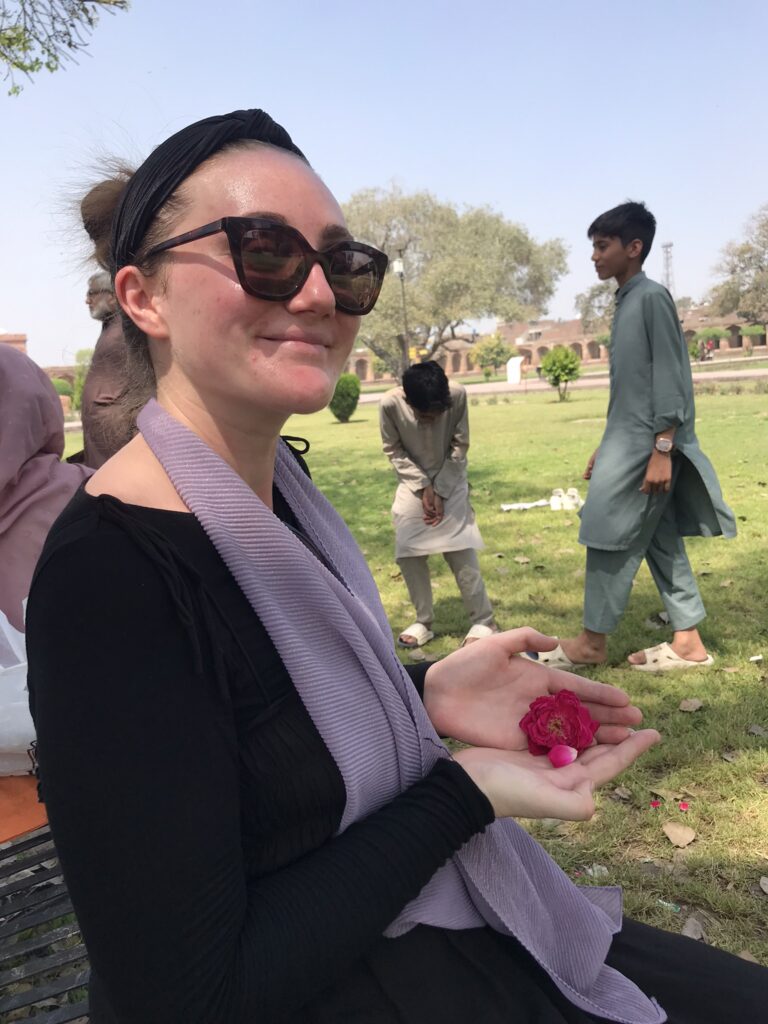
All the people we met in Pakistan were so gracious and welcoming – these young boys who were visiting the Tomb of Jahangir with their family picked flowers for me and Dan
Because we were at the end of a long and tiring trip through the Indian subcontinent, we decided not to stretch ourselves and venture too far off the beaten track in Pakistan (after all, Pakistan itself is off the beaten track for most travelers). There are several other places in the north of the country that we would’ve loved to visit, such as Chitral, the Kalash Valley, Swat Valley and Peshawar. People from Peshawar and the wider Khyber Pakhtunkhwa (KPK) region have a reputation for hospitality and this was evident whenever we encountered people from that region in other parts of Pakistan. However some of these places can also be extremely conservative and have been vulnerable to militant Islam and problems spilling over from neighbouring Afghanistan in the past.
As well as KPK, the entirety of the country south of Lahore was pretty much off-limits for independent travelers at the time of our visit. Although it is technically possible to travel there, we heard some first-hand accounts of foreigners who tried to visit the city of Multan and other places in the south of Punjab being provided with a mandatory police chaperone for their own protection – this is done because Pakistani government are very keen to ensure the safety of foreign visitors. It sounds great in theory but the chaperones often forbid tourists from walking around freely, greatly restricting their movements and freedom to explore. If you do want to visit the south of Pakistan outside of Karachi, it’s probably best to go on an organised tour for now.
Avoid restricted border areas with India as you never know what might happen. Parts of the Karakoram Highway around Chilas have been considered unsafe for foreigners in the past and we heard reports of taxis carrying foreigners being prevented from traveling on these stretches after dark. It’s also best to give Balochistan a wide berth for the time being as the situation is pretty volatile. Balochi separatist attacks have been on the rise in recent years as insurgent groups demand greater autonomy and control of their land.
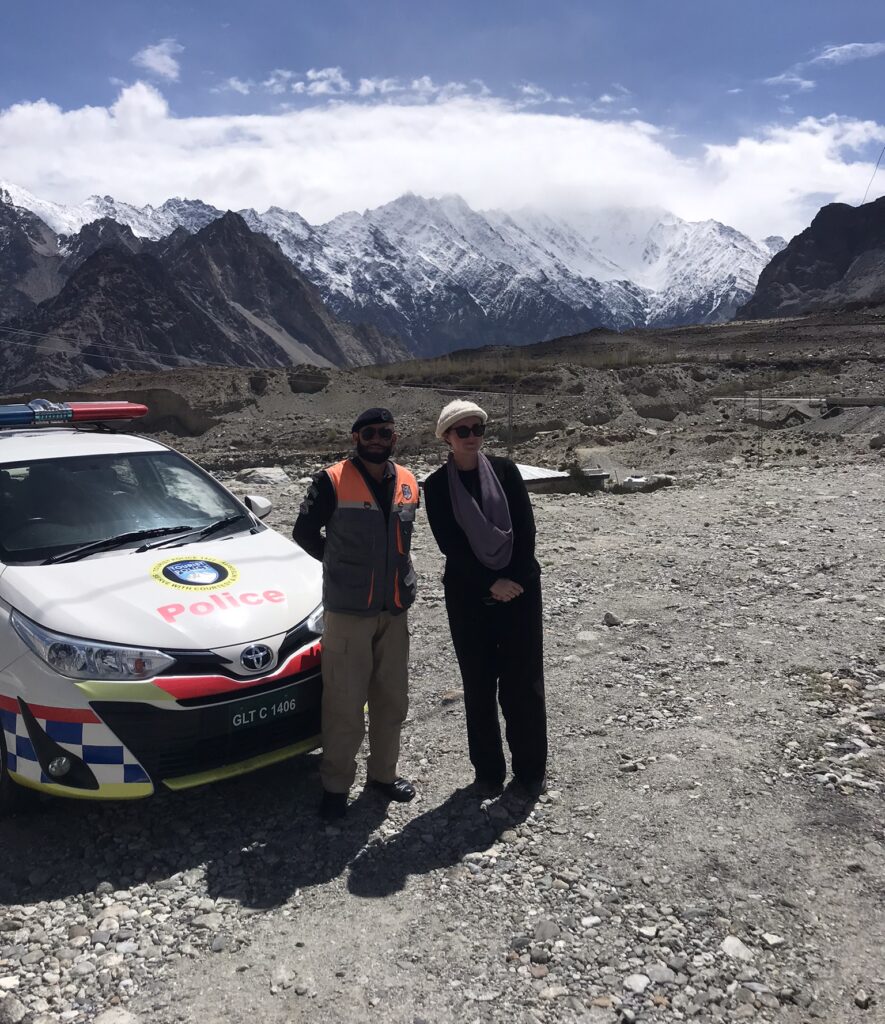
The parts of Pakistan that we visited felt super safe – the local authorities are very keen to protect foreigners
We visited Pakistan in April – although it was ridiculously hot in Lahore, this is one of the best times to visit Gilgit-Baltistan, when the valleys are blanketed in cherry and apricot blossom at the very start of the summer season and when things are starting to open back up after the winter but before the arrival of the hordes of domestic tourists.
Cultural nuances
It really goes without saying but there are obviously significant cultural differences between Pakistan and many other nations, particularly Western nations. Pakistan, is generally speaking, a very conservative Islamic country. When visiting it’s important to be open and non-judgmental to the local cultural nuances, just as you would expect any guest in your own country to be. Pakistan is not the place for short shorts or closed mindedness.
Religion permeates everything in Pakistan, from travel prayers on planes and buses to the call to prayer being played over the loudspeakers in the airport. Museums and attractions may temporarily close on a Friday afternoon for prayers. In Pakistan, blasphemy is a crime which is punishable by death. People dress modestly, fast during Ramadan, eat halal food and avoid products which are considered haram like alcohol, pork and other intoxicants.
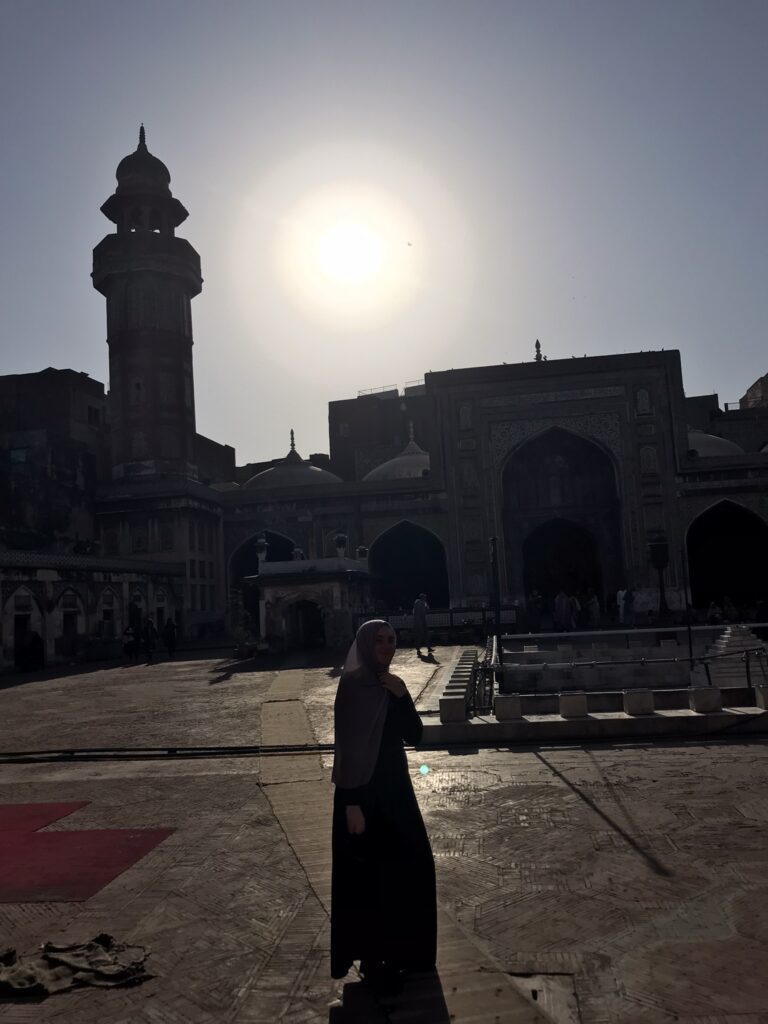
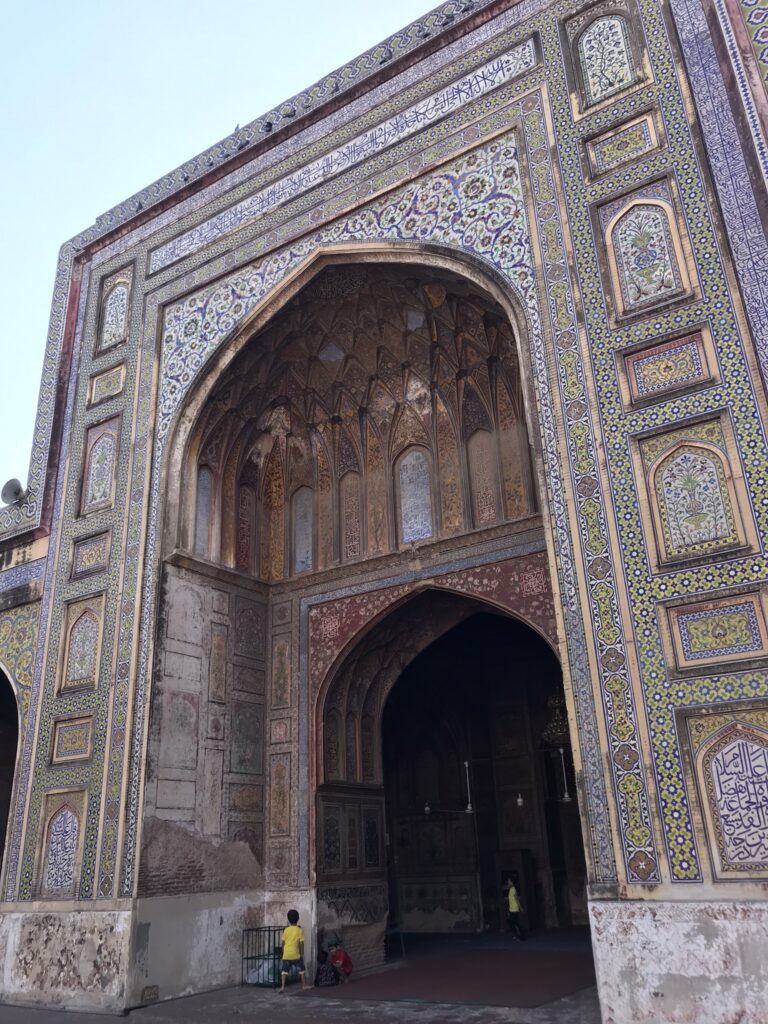
Pakistan is home to many grand mosques – the Wazir Khan mosque in Lahore reminded us of Uzbekistan
When traveling through Pakistan, you of course need to adhere to the cultural sensitivities and show respect to local customs. However, as non-Muslims I can say that we didn’t feel uncomfortable in Pakistan or really encounter any problems at all because of the difference of religion. On the contrary, people were curious about us but also very courteous, warm and welcoming. Ladies will need to cover their hair in mosques and religious buildings, but I didn’t feel the need to cover my hair the rest of the time in the places we visited. We also made sure to describe ourselves as Christian when asked – a good idea even if you’re not actively religious. Click here to check out my Pakistan travel tips including advice on dealing with issues of marriage, religion and clothing.
Hospitality is the backbone of society in Pakistan. We often find outstanding hospitality in Islamic countries and Pakistan was no exception. From being invited in for refreshments by a friendly family in Skardu to a fellow passenger in a shared taxi paying for our tea at a roadside restaurant without us even knowing, or rocking up at a friend of our hosts in Gulmit near Karimabad for some dried cherries and apples. Pakistanis are renowned for being good natured and humble hosts with doors wide open to guests.
In Pakistan it’s always chai time! Chai or unspiced milk tea is the answer to everything. Need waking up? Chai. Meeting friends? Chai. Tired? Chai. Unlike the herbal teas in Central Asia, we found that the chai in Pakistan was very similar to English breakfast tea, milky and rich in consistency which was an unexpected delight for us.
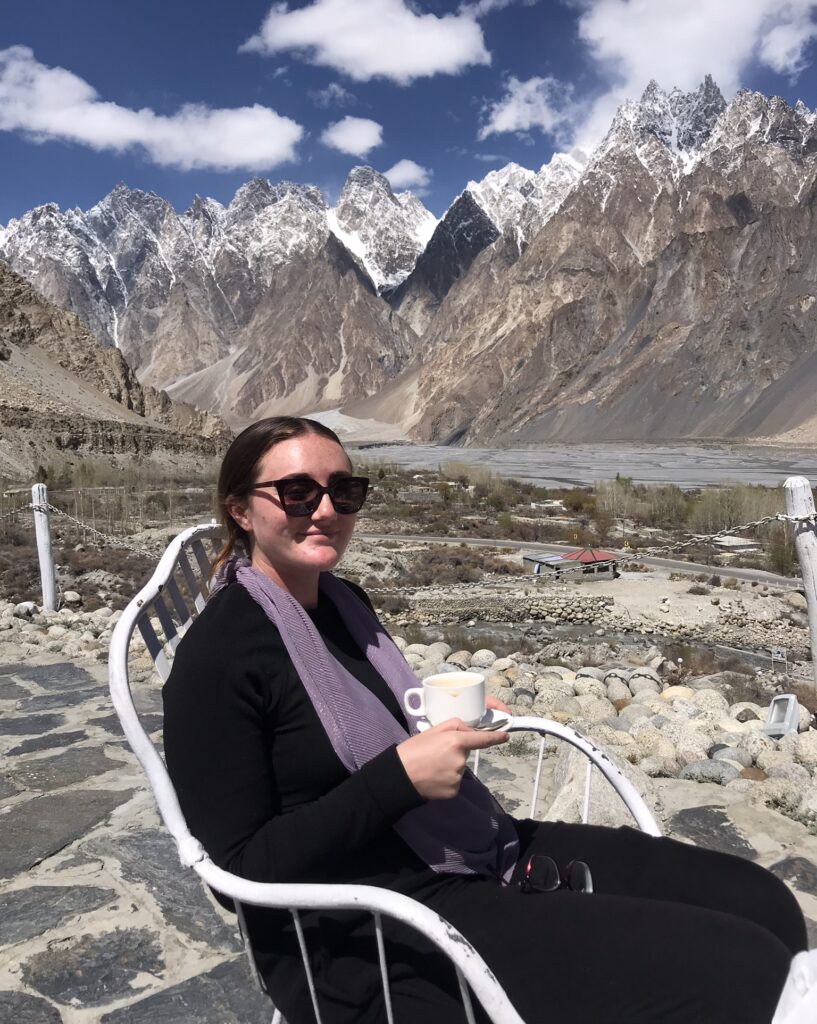
Pakistan is great for lovers of a nice cup of tea
Contrary to popular perception, in Pakistan I found that there is actually great respect for women. As is the cultural norm in many Islamic countries, men are forbidden from touching women that are outside of their family. I found men to be very gracious towards me, often giving me a wide berth on the pavement or giving me more space to pass by without touching. This made a nice change from India where I was inundated with men getting too close, trying to touch my hand or take photos with me.
Most Pakistani men wanted to shake hands and take photos with Dan rather than me – a sign of respect. However despite giving me plenty of space, the men were not dismissive; they were open to speaking to me and accepting of my presence. I didn’t know what to expect interaction-wise before arriving but I didn’t experience any disrespect or prejudice personally. I wasn’t ignored or spoken over at all! All my interactions with Pakistani men were very normal and amiable interactions. The general rule is unless a man offers to shake your hand (this only happened to me on three occasions in 16 days) simply place your right hand over your heart as a respectful sign of greeting.
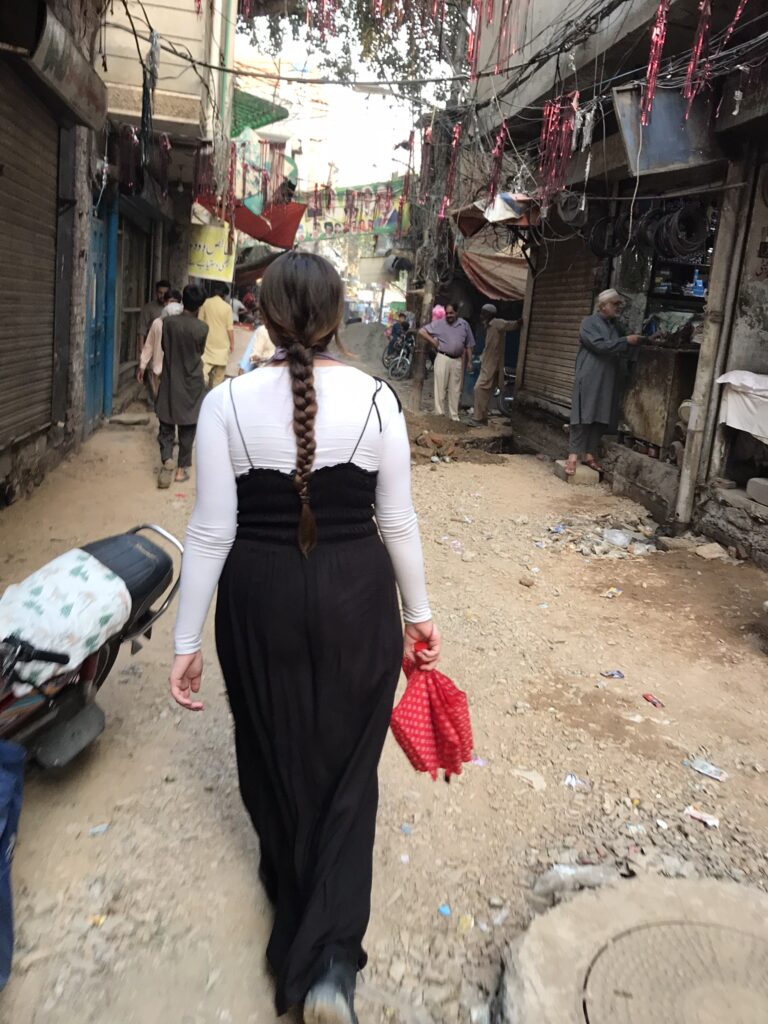
As a foreign woman I was fine walking the backstreets of Lahore with Dan
Pakistan is often portrayed in a negative way in the media but Rabia, my Pakistani friend from Lahore, wanted to make clear that Pakistan is by no means Afghanistan; women can have high-flying careers, wear western clothes and makeup, watch Hollywood movies on Netflix, drive fancy cars, study to be doctors and have opportunities open to them. However women’s freedom often depends a lot on their family situation and background. For women from wealthy, liberal, urban-based (Lahore, Islamabad, Karachi) families, opportunities are available. However those from more conservative or rural areas or at the bottom of the social pile may find that their options are a lot more limited.
I would be remiss not to talk about the other problems facing Pakistan. Sadly, poorly-treated child domestic workers are a reality in Pakistan at present among middle and upper classes. Pakistan is one of the only parts of the world where polio has not been eradicated, while some rural parts of the country remain isolated geographically and culturally. The threat of Islamist insurgency and terrorism in certain parts of Pakistan remains a concern, with problems spilling over from neighbouring Afghanistan in the recent past as well as attacks carried out by militant separatists in Balochistan. Chinese resource mining is also becoming a malignant factor in the country in order to repay debts to the International Monetary Fund and China. The people we spoke to about this issue predict protests in the future against the selling off of local natural resources to pay back debts accrued by the national government.
Tips for travellers
Pakistan can be a culturally sensitive but also rewarding travel destination, filled with warm, friendly and interesting people. We picked up a few pointers along the way to make life easier when traveling independently in the country. Click here to check out my top Pakistan travel tips!
I also wrote a blog post about transportation in Gilgit-Baltistan – click here to view it!
Lahore
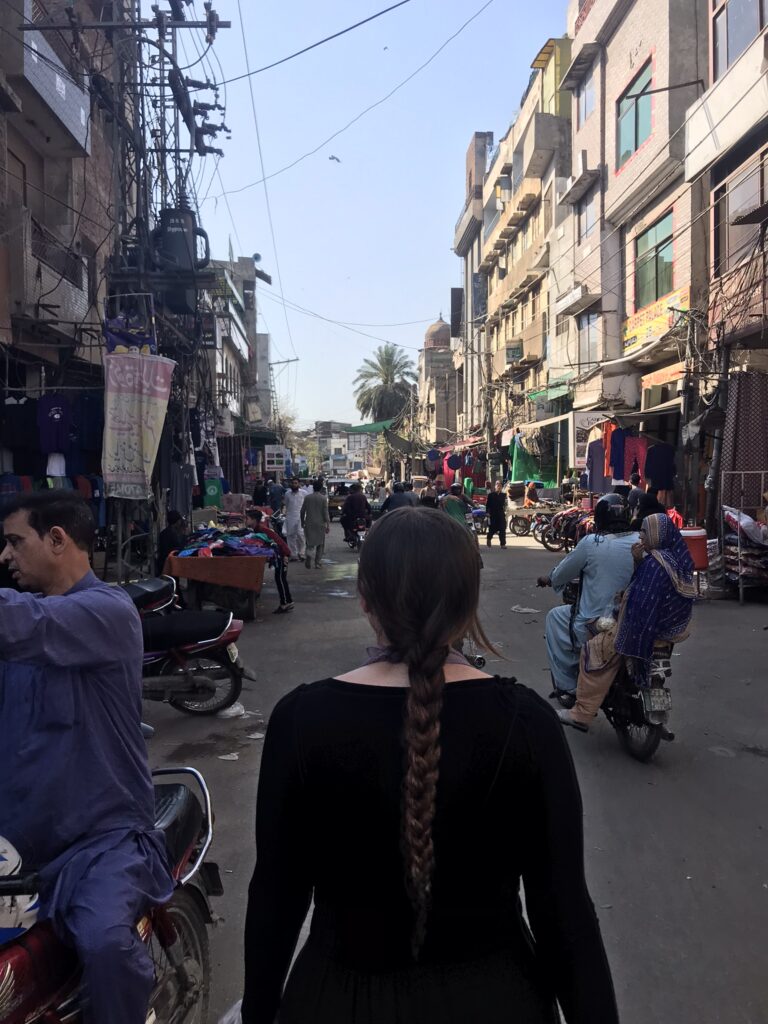
A stone’s throw away from the India-Pakistan border, Lahore is the largest city in Pakistan’s Punjab region. It has been described as the ‘Paris of the East’ for its relatively cosmopolitan, liberal atmosphere and reputation as a center of literature and music. And while in reality Lahore is very different from Paris, it is most definitely a unique and vibrant city with a strong cultural heritage and many interesting sights and places to explore. Lahore represents the old and new; from the medieval Walled City with its tangled web of confined streets and passageways near Delhi Gate to the wide boulevards and extravagant mansions close to Lahore Zoo. With two UNESCO World Heritage sites (Lahore Fort and Shalimar Garden), world-class museums, the fascinating Mughal-era Tomb of Jahangir and the most iconic mosque in Pakistan to boast about, it’s an unmissable stop on any Pakistan itinerary.
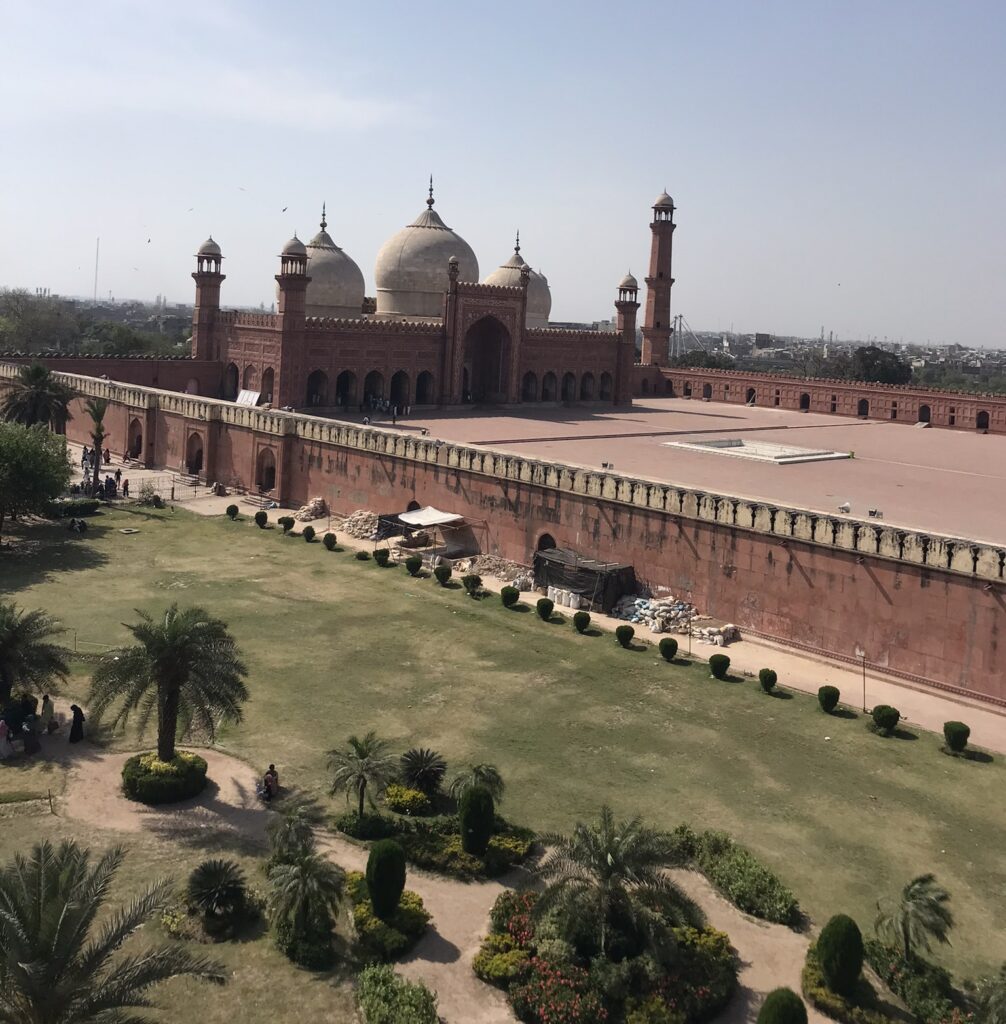
Badshahi Mosque is one of the iconic symbols of Lahore
Lahore has been inhabited for many centuries but reached its peak during the Mughal period in the 1600s. The Mughal influence can still be felt throughout the city’s many buildings and monuments; it defines the culture and architecture of Lahore to this day. After the decline of the Mughals, Lahore then passed into the hands of the Sikh Empire and then later the British Empire, both of which have also played a major role in shaping the city’s cultural identity.
Lahore was our first stop in Pakistan. We didn’t really know what to expect. Strolling around the streets (we did a hell of a lot of walking there!) we weren’t approached or bothered once – a welcome change after the relentless hassle of the north of India! We also immediately noticed that there was minimal traffic chaos, fewer honking horns and no over-the-top litter compared to the place we had just come from. It’s interesting to note that Lahore and Amritsar used to be sister cities but were torn apart by the 1947 Partition. Punjabi continues to be the first language of the majority of residents of Lahore to this day, just like the Punjab region in India.

For some reason, table football (foosball) is everywhere in Lahore – Dan was soundly beaten
Lahore is a huge city with an enormous population, but most of the time it felt strangely relaxed, not really overcrowded or chaotic at all. The major exception is the Walled City and Delhi Gate area, which is teeming with people. Still, even this area wasn’t so busy that it was unpleasant to walk around – the human traffic jams weren’t on the same level as in places like Dhaka and New Delhi. The Walled City is the historic centre of Lahore, with Delhi Gate being the overcrowded eastern entrance to the Walled City. Delhi Gate actually faces New Delhi in India, dating back to the time of the Mughal Empire – interestingly, in New Delhi there’s a sister gate named Lahori Gate.
The Walled City can be both manic and peaceful, an atmospheric labyrinth of narrow streets and alleys which is the heart of the old town in Lahore. Inside is a bit chaotic with pedestrians and mopeds jostling for space in the winding alleys and walkways. A mix of residential and commercial properties with bustling market streets selling an array of products from metalware to woven beds and luxurious silk dresses. Well worth a visit for the buzzing atmosphere and historic mosques! Outside of the Walled City area, Lahore is a mixture of wide, modern streets and winding, medina-style residential areas which we felt comfortable enough wandering around and exploring on foot.
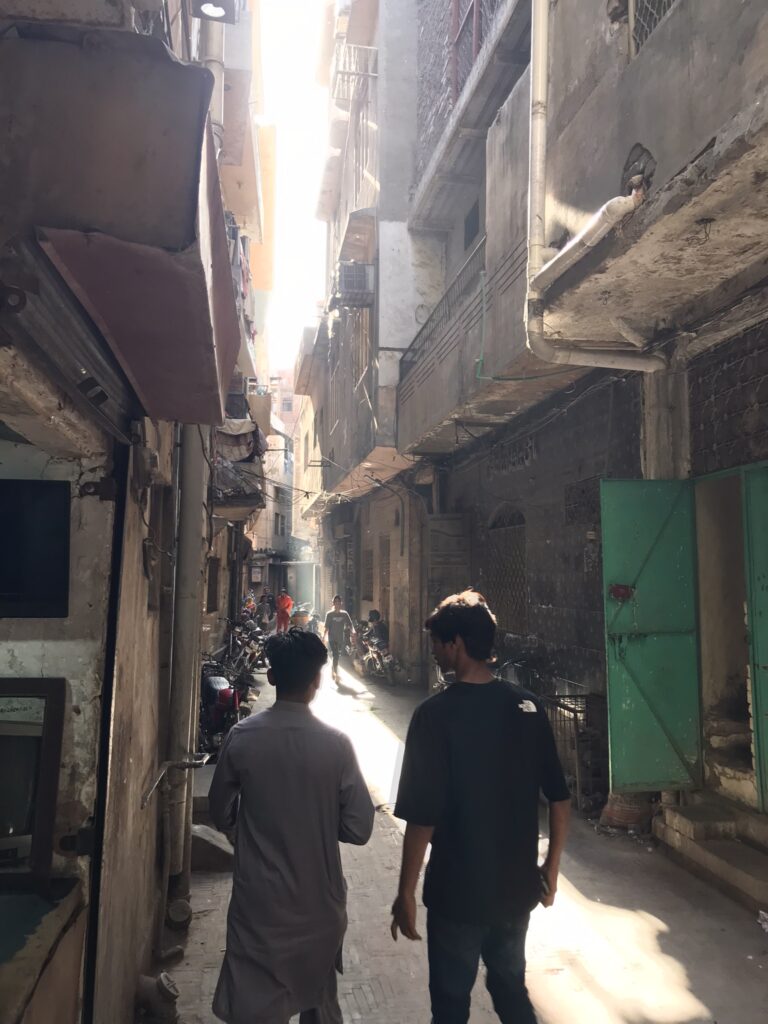
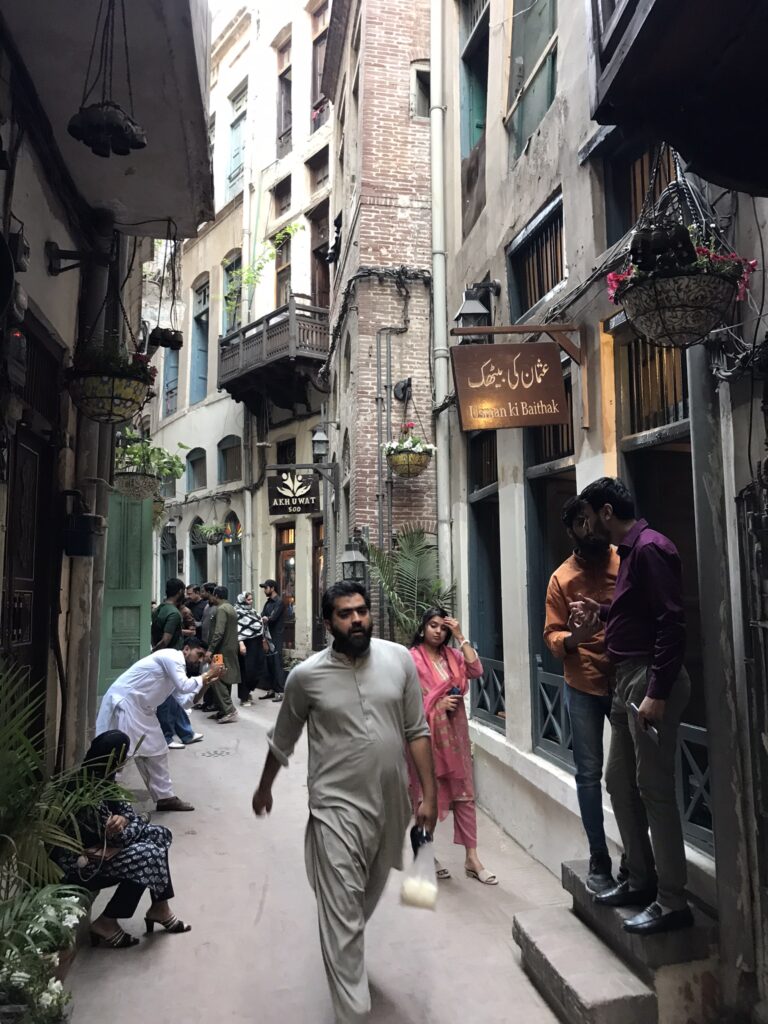

There is plenty going on in the Walled City
Lahore can get incredibly hot. Temperature-wise the best time to visit the city is in the winter months of December, January and February, however pollution levels can be much higher in these months and this is also not the best time for visiting other parts of Pakistan. When we visited in April, the temperatures in Lahore were already pushing 40 degrees celsius and it was almost unbearably hot. If visiting at this time of year, my best advice is to carry an umbrella with you for shade and drink plenty of water. A hotel room with air conditioning is a must!
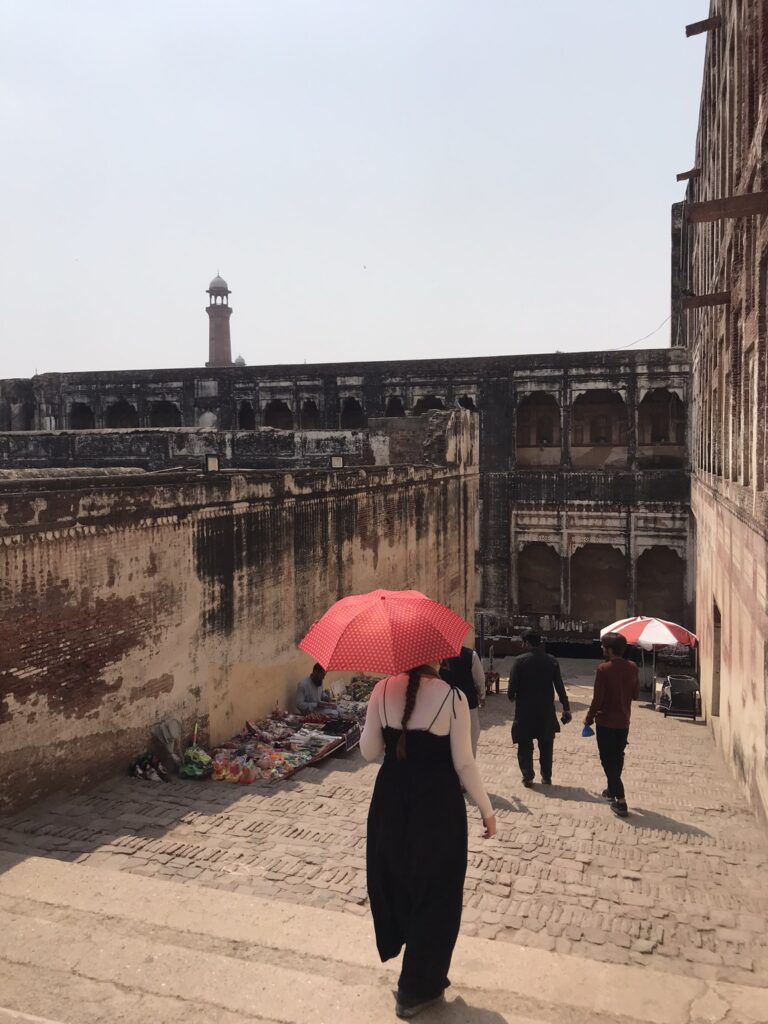
Carrying an umbrella may be cumbersome but it really helped with the sun
When visiting attractions in Lahore, it’s worth double-checking social media for any scheduled or unscheduled closures. We didn’t do this and were sorely disappointed to find that both the entire Lahore Fort complex and Shalimar Gardens were unexpectedly closed on the same day. We had to shuffle around our itinerary and never actually made it into Shalimar Gardens in the end as a result. From speaking with locals and also based on our own experiences, the opening of both major and minor attractions in Lahore can be a little bit erratic as they are regularly used to host delegations, functions, festivals, public holidays or any manner of other things which may result in temporary closures.
Public transport in Lahore
To get around the city using public transport, the metro bus and metro are the way to go. The metro in Lahore is a modern, shiny new system which works well. The downside is that it currently only has one line and not particularly good coverage of the major touristic sites.
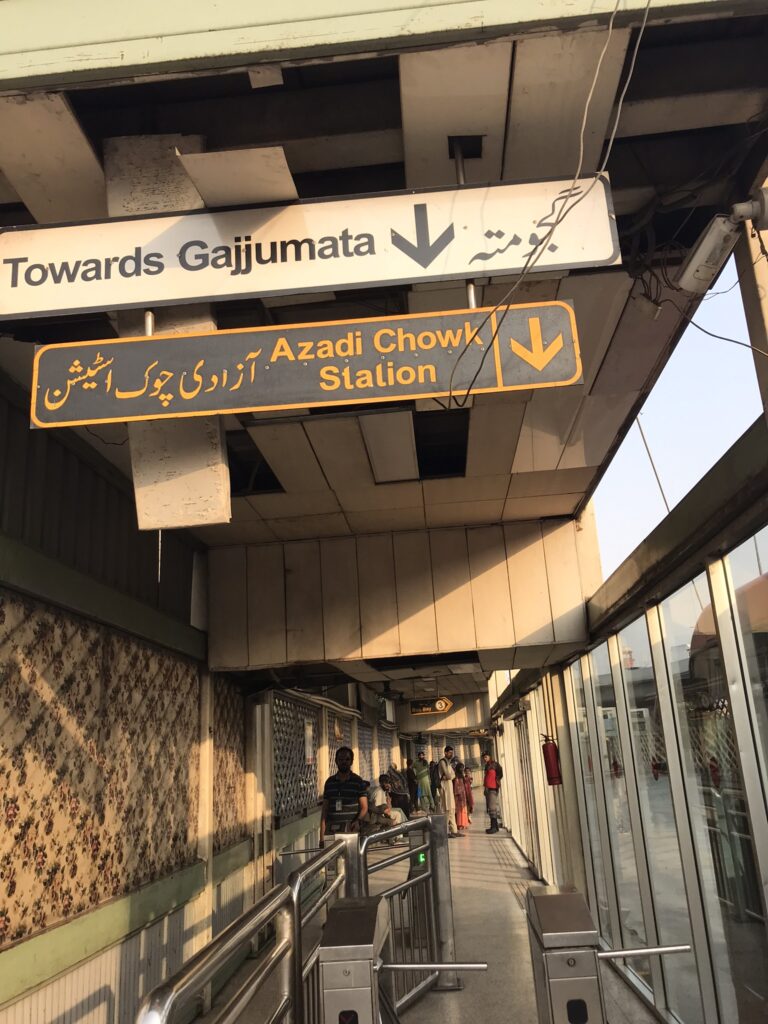
A typical metro bus station in Lahore
The metro bus was a new experience for us – it’s literally a bus that operates on a set route like a train or tram in its own special lane. The tickets are super cheap and the buses are very regular – roughly every 2-3 minutes. There’s an unofficial area for women and children at the front of the metro bus and even though I was with Dan I was encouraged to join the ladies at the front. Most of the time the air-conditioning worked on the metro bus, which was a godsend when it was baking hot outside. I also had some interesting interactions with local women on the metro bus, who were genuinely curious and eager to talk to me.
Lahore Fort complex and Jahangir’s Tomb are both situated close to the metro bus line. Shalimar Gardens and Lahore Museum are both on the metro line. Using public transport can become a little inconvenient when you want to reach some sites as you may need to change from the metro bus to the metro. A minor annoyance but worth it to save money.
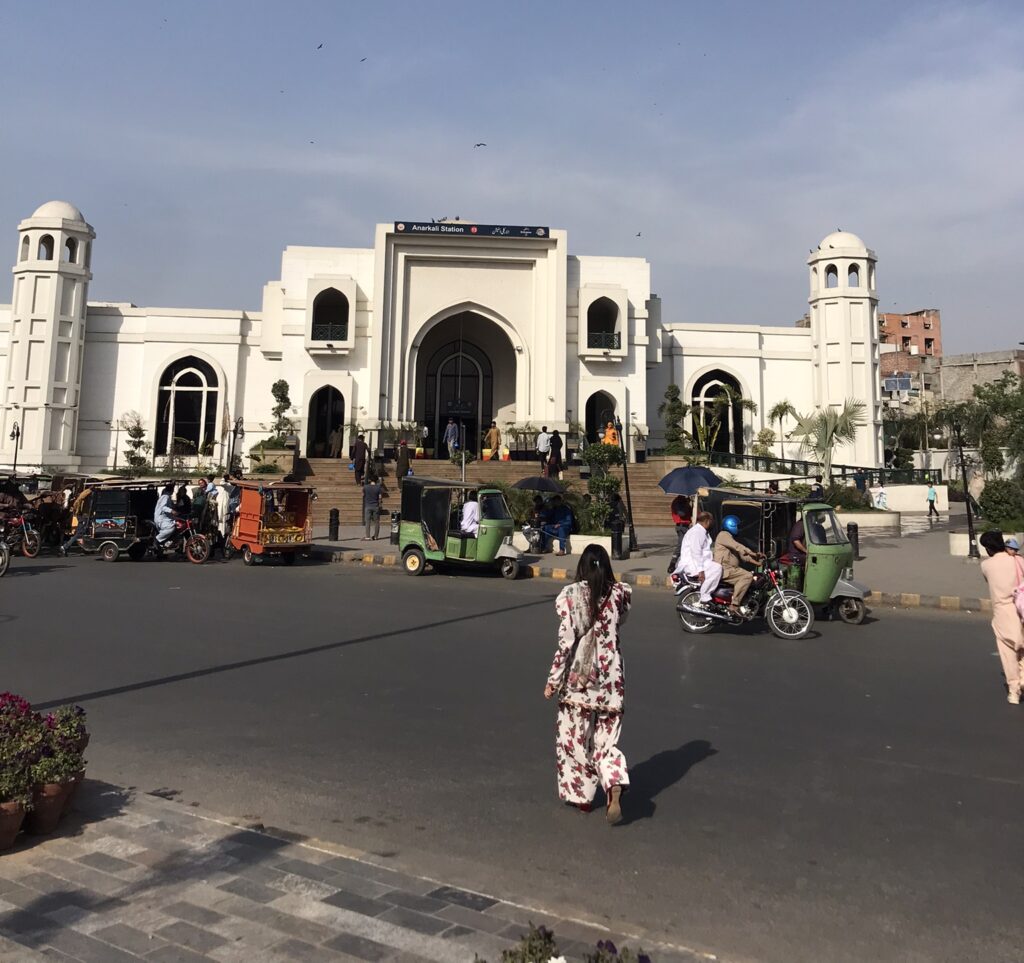
Anarkali Station is the best place to change between the metro and the metro bus – just around the corner is the MAO College metro bus station
If public transport is not your cup of tea, InDrive works well in Lahore. It’s similar to Uber except you can negotiate a price for your journey and choose your own driver (always go for the one with the highest rating).
When traveling intercity, Faisal Movers is an excellent bus company. We used them to get from Lahore to Islamabad and had a great experience. They offer executive business class buses which include a fancy executive lounge with free hot drinks and water cooler, a snack pack and water bottle en-route and an interactive screen onboard which you can use to play movies or Qawwali (sufi devotional music), which makes the journey fly by. There are regular buses at very reasonable prices considering the level of service. The experience with Faisal Movers is honestly one of the best and most luxurious intercity bus experiences I have ever had in any country. The Faisal Movers terminal that we used in Lahore is located here – no need to buy a ticket in advance as they have a ticket office at the terminal.
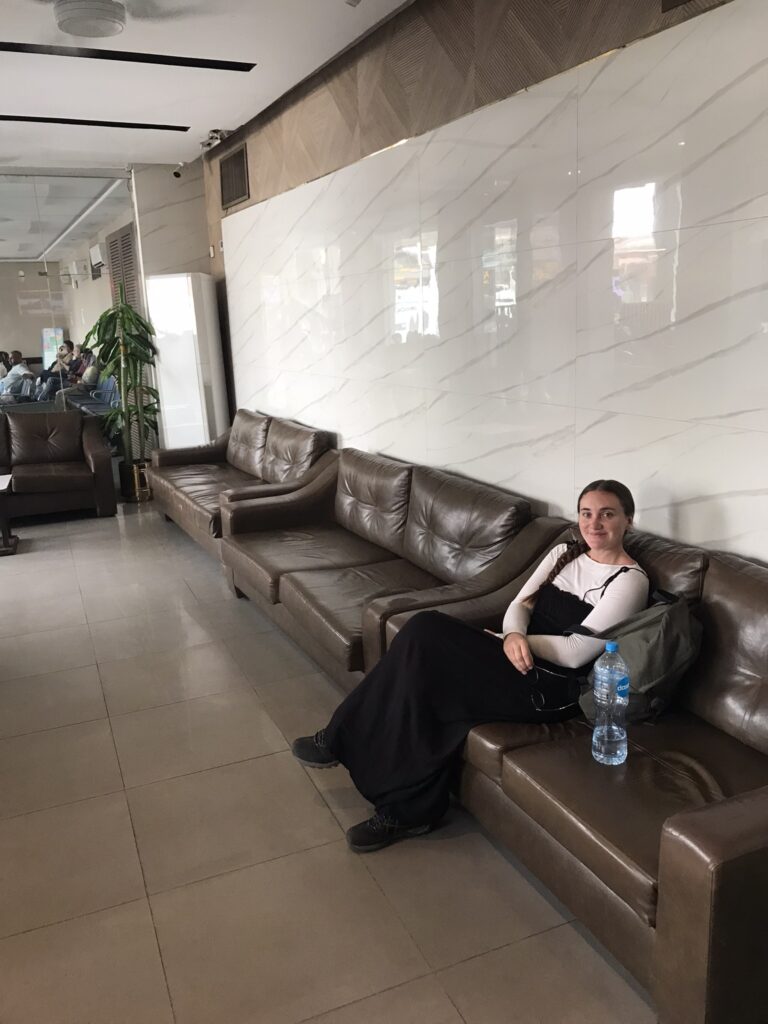
Chilling in the Faisal Movers executive lounge – I highly recommend this bus company
Accommodation
Most foreign visitors to Lahore choose to stay in the Gulberg neighbourhood, which is considered to be one of the most upmarket parts of town. We didn’t stay here, instead we stayed near Bagh-e-Jinnah which is a little bit closer to the centre of town. Sadly we couldn’t find any decent accommodation within our budget located along either the metro or metro bus lines, which would’ve made life a lot easier.
Imperial Suites – Spacious and stylish studio rooms with a comfortable bed, stand alone bath tub, great air conditioning and a functional kitchen area. Our stay was very peaceful and rejuvenating as the place is situated on a quiet street off the main road. There are plenty of food options nearby as well as room service if you’re feeling lazy – all food that we ordered was filling and tasty. The reception staff were also very professional and accommodating. From Imperial Suites it is just about possible to walk to The Mall and Lahore Museum, the Shrine of Shah Jamal and the metro bus station. However this walk can become a bit of a slog in the hot weather so I recommend using InDrive if the temperatures are high or you’re short on time.
Foodie Places
Fort Road Food Street, right next to Lahore Fort, is a great place to head for Lahori cuisine although it’s a tad on the touristy and expensive side. Haveli Restaurant is the most highly rated of the restaurants on the street.
Haveli Restaurant – located in a historic family house, this slightly pricey restaurant has fantastic views of Badshahi Mosque from the roof and main dining room. It also houses a small museum on the ground floor. Another quirk of the place is that they have front of house staff with dwarfism who welcome you inside and escort you to the lift. There is a small gallery area in the lobby. The food served traditional Lahore fare such as handi, karahi and a wide selection of kebabs. A gimmicky, touristy place but we liked it.
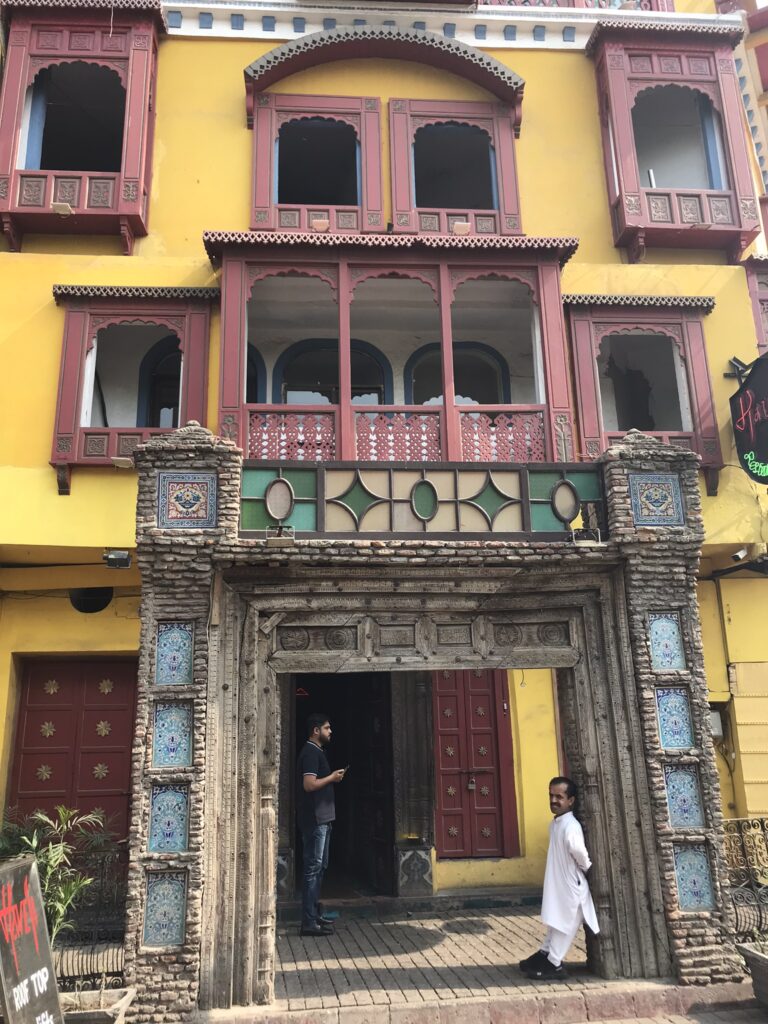
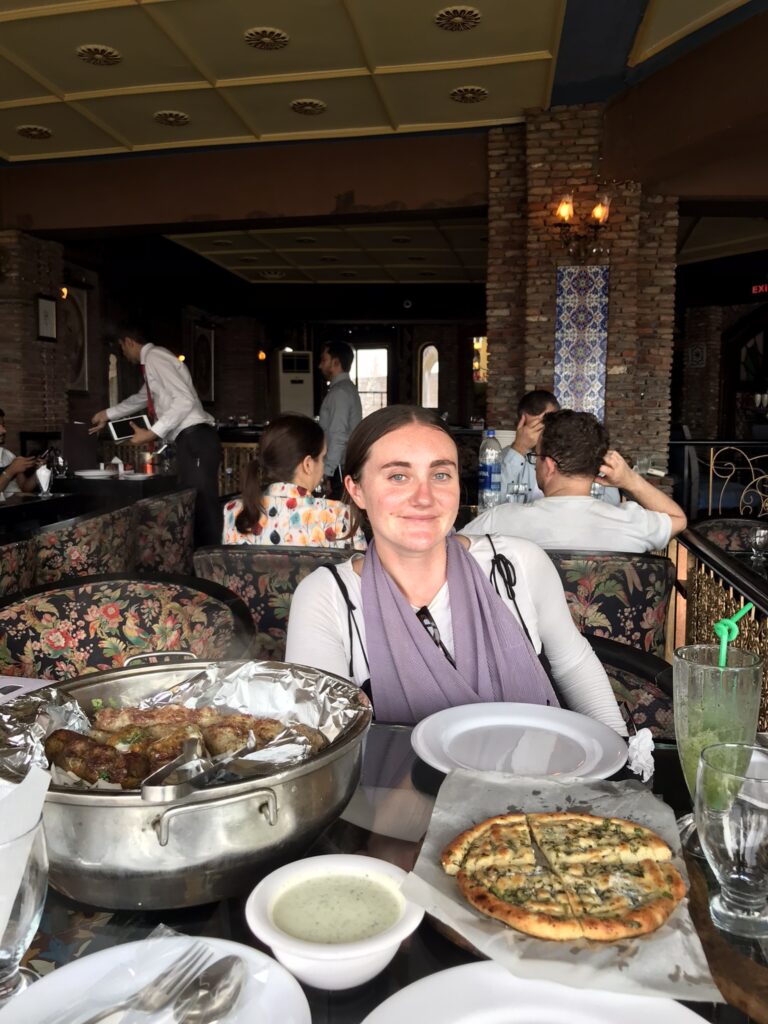
Haveli restaurant is as much about the experience as the food, but we enjoyed the mixed kebab platter including fish kebabs!
Broadway Pizza – Shadman – if you’ve got a craving for fatty processed food then Broadway Pizza is the place to go to fill up on gooey, cheesy pizza. The prices are very reasonable and the menu is in English too.
Subway – yes, there is Subway in Lahore. Not exactly an authentic Pakistani option but home comforts are needed sometimes after months on the road. We’ve tried Subway in dozens of countries and honestly the sandwiches we had in Lahore weren’t the worst. Plenty of fresh salad is always a boost.
Activities
Sufi Dhamaal at the Shrine of Shah Jamal – ONLY on a Thursday night
Every Thursday night, adherents of the Sufi order of Islam gather at the Shrine of Shah Jamal and various other Sufi shrines in Lahore to participate in dhamaal – essentially a type of religious ecstatic dance. If you’re in Lahore on a Thursday, attending a dhamaal is an unmissable experience in my opinion. The best way I can describe it is that it’s like attending a Sufi version of an underground religious nightclub.
Click here to read my blog post here for my experiences at the dhamaal!
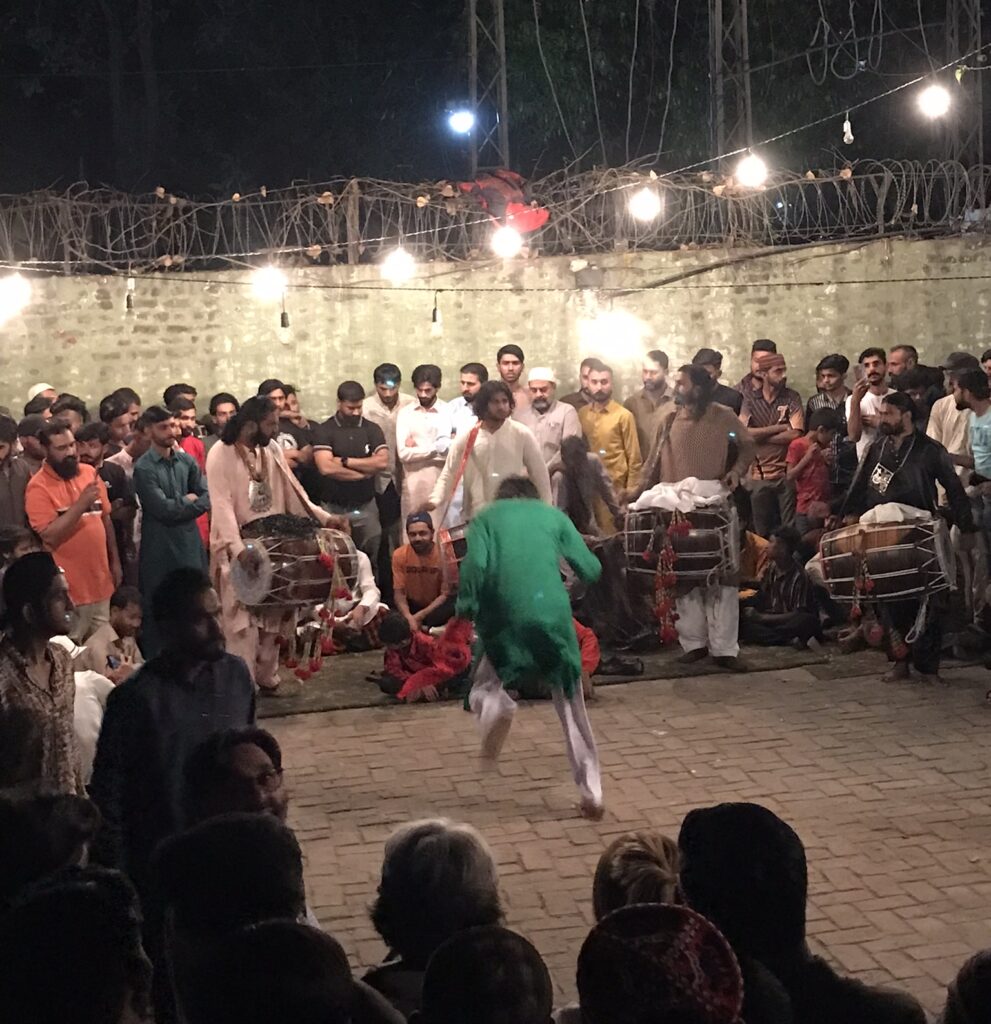
The dhamaal at the Shrine of Shah Jahan is something I can highly recommend if you’re in Lahore on a Thursday night
Guruwalk around the Walled City with stops at Delhi Gate, Gali Surjan Singh (named after a prominent Sikh doctor, after being renovated it’s now a picturesque touristy street with boutique cafes and upmarket shops), Wazir Khan Mosque (on the UNESCO tentative list, famous for its Persian-inspired design and glazed tile exterior we couldn’t help but notice similarities with Uzbekistan madrassas), Khalifa Bakers near Mochi Gate (a much-loved Lahore bakery since 1925 – almond nankhatai is the biscuit to try here!) and Sunehri Masjid (famed for its golden domes). As always, a Guruwalk is a great way to engage with and get first-hand authentic experiences and tips from a local as well as uncovering hidden aspects that you would’ve otherwise missed. This is particularly useful in the labyrinthine Walled City with its many undiscovered treats. Tip your guide fairly!
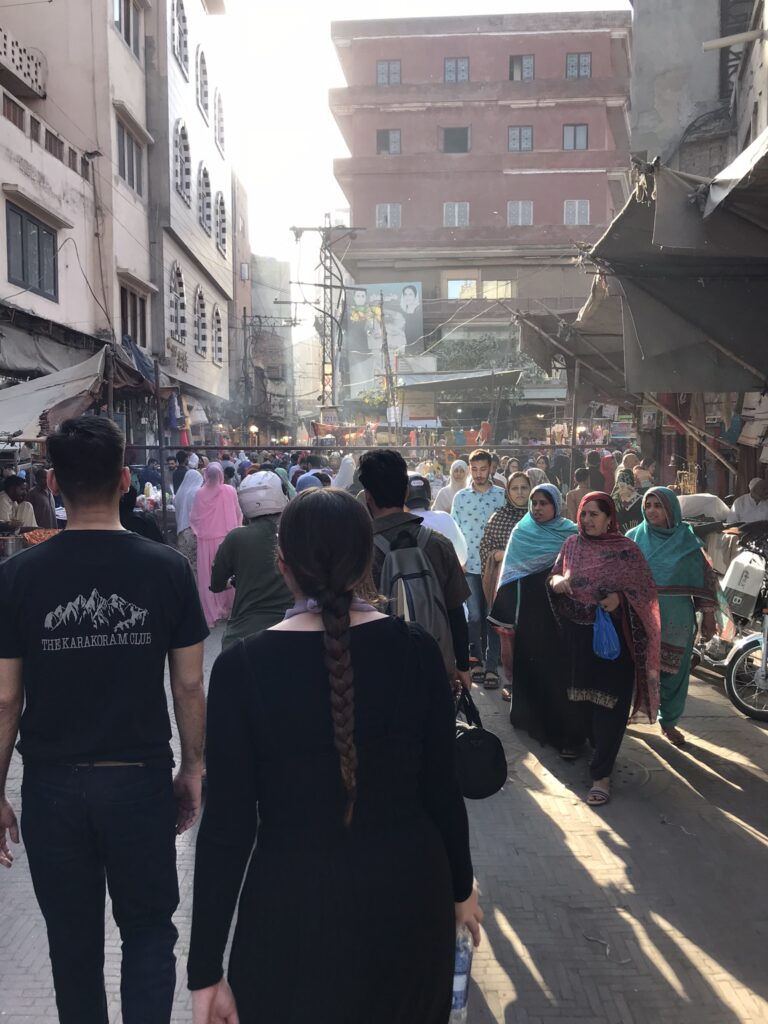
The Walled City can be a busy place
Tomb of Jahangir – a typically extravagant Mughal emperor’s tomb. This iconic landmark is situated in what used to be an extensive Mughal pleasure garden complex on the banks of the river Ravi. According to legend, the spot for Jahangir’s tomb was his favourite garden. Jahangir was buried in Lahore as he died in Kashmir and Delhi, the capital, would’ve been too far to repatriate the body of the emperor. Apparently Jahangir prohibited the building of a dome over his mausoleum, as was the style at the time. Jahangir’s son, Shah Jahan, was responsible for building this final tribute to the deceased Mughal emperor. Later, the tomb was desecrated by the Sikhs when they took possession of the city in the 18th century.
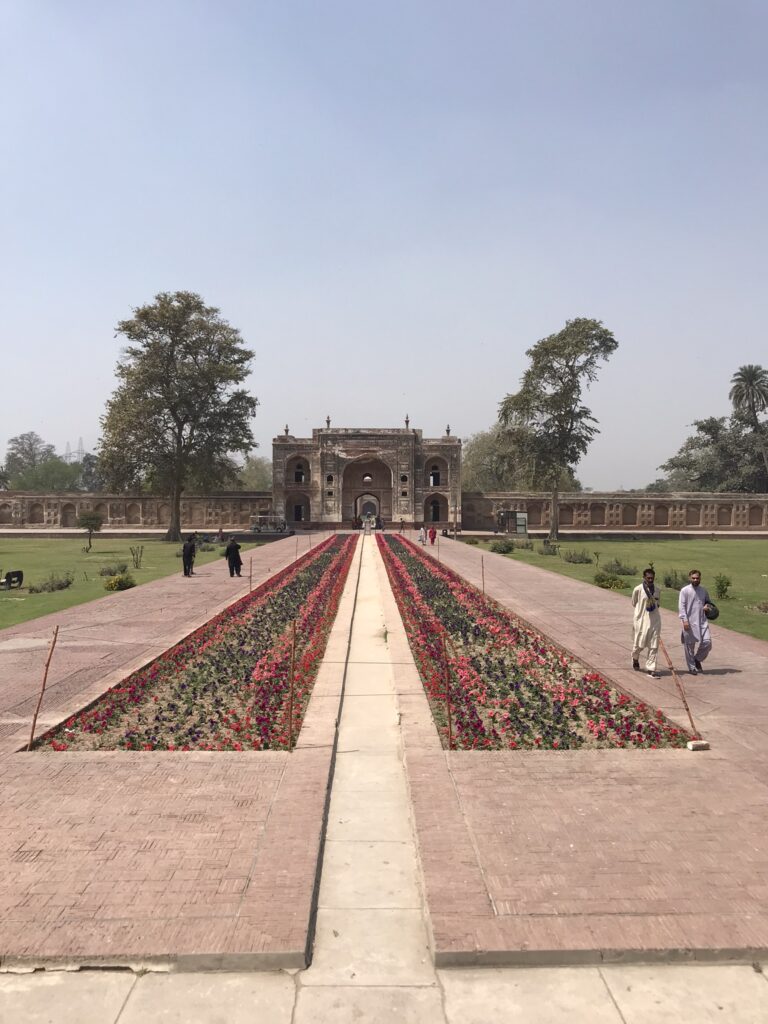
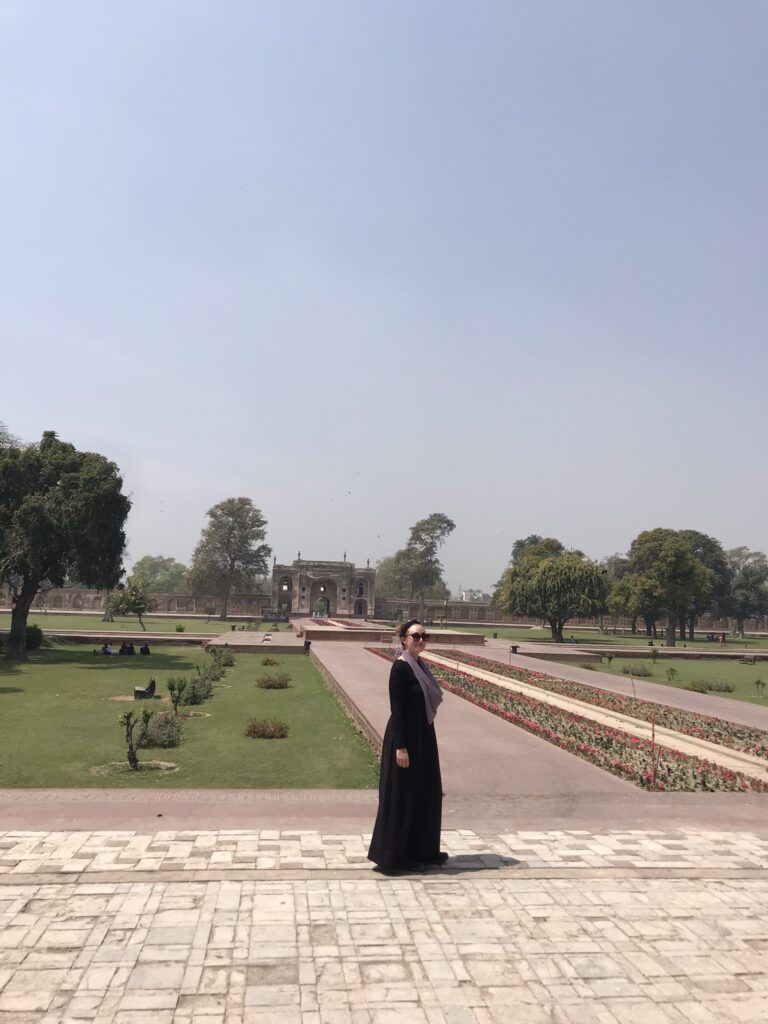
Jahangir’s tomb complex follows a typical Mughal-style garden layout
The mausoleum features typical Mughal architecture with intricate pietra dura marble inlay work in dusky sandstone, four towering gleaming white marble minarets and a Persian Paradise Garden. The symmetry and layout of the mausoleum complex is flawless. We found the gardens to be very tranquil and serene – an ideal place for a picnic or rest in the shade. There is a small photo gallery within the mausoleum showing before, during and after conservation shots, although we were asked for a tip by the attendant after leaving the room. Opposite the entrance to the mausoleum and within the wider complex is an archaic caravanserai (inn for travelers), fully functioning mosque and the tomb of Asif Khan.
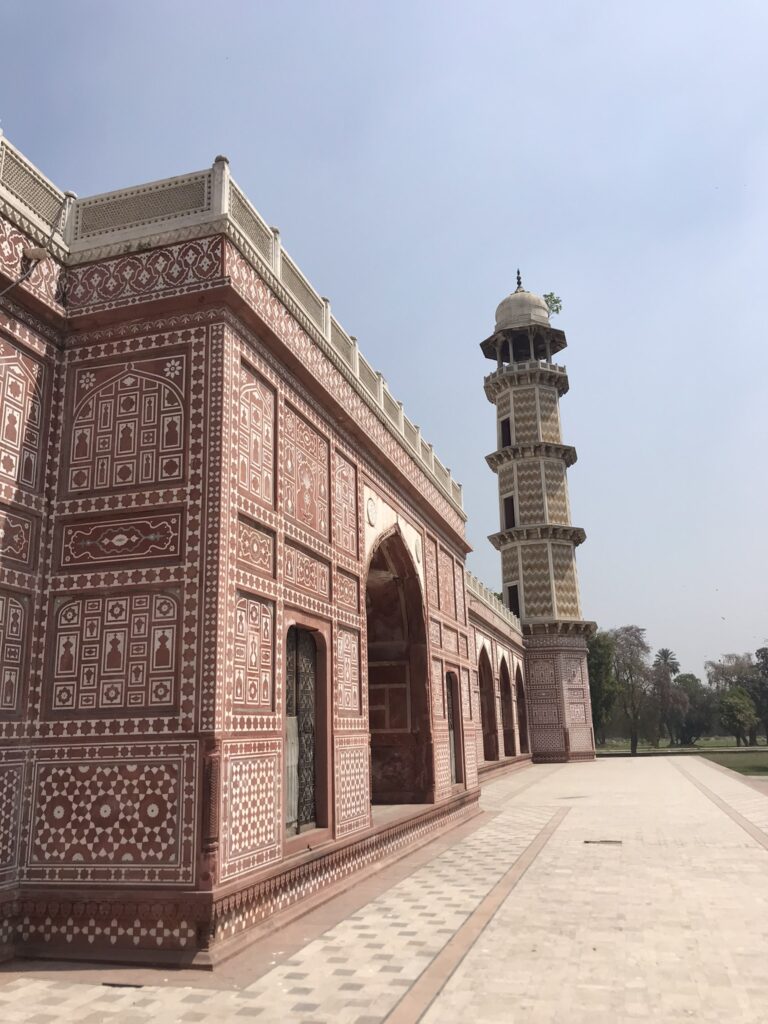
Jahangir’s mausoleum – I can never get enough of the intricate decorations on the grand Mughal structures
The Tomb of Nur Jahan (separate entry ticket) is located nearby, within easy walking distance of Jahangir’s Tomb. Nur Jahan was one of Jahangir’s wives. As well as vast gardens, this smaller sandstone mausoleum of Nur Jahan is another testament to the Mughal legacy in the city. The mausoleum is surrounded by pleasant gardens which are a nice place to take a stroll.
Both of these attractions can easily be visited using the metro bus. Just take the bus to Shahdara, which is the final stop on the line. From the station, it’s a 10 or 15 minute walk to either of the tombs. Entry for both tomb complexes is paid – annoyingly there is no combined ticket so you have to pay separately for both the Jahangir and Nur Jahan complexes, although entry is quite cheap (500 PK rupees for foreigners when we visited).
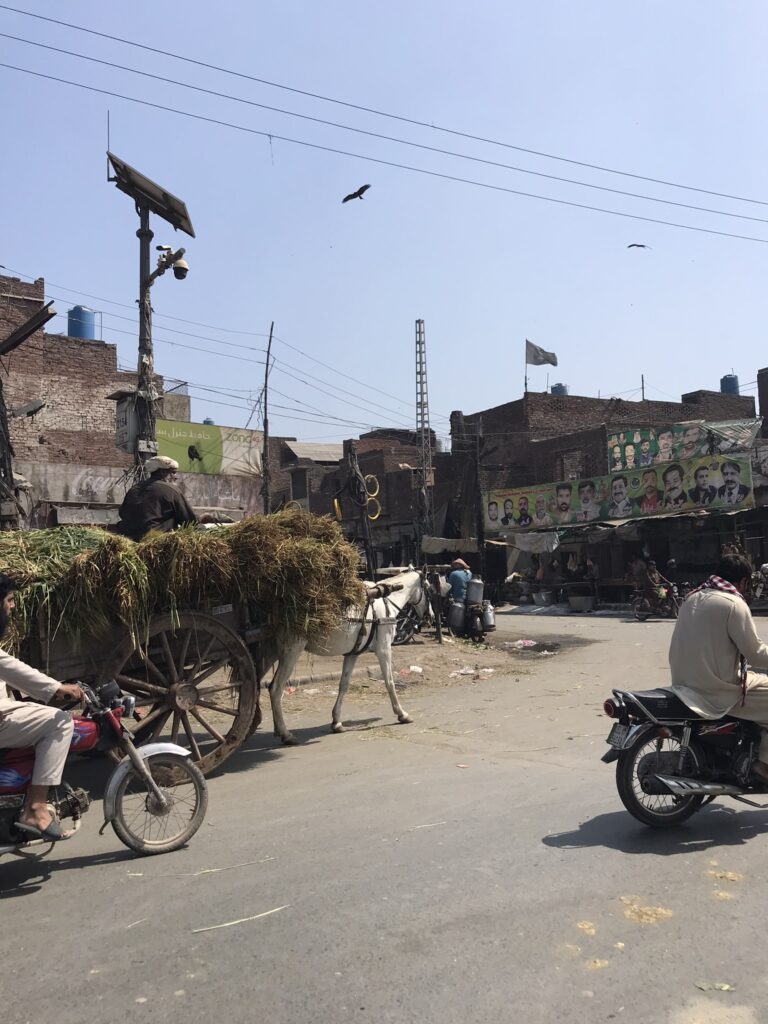
Jahangir and Nur Jahan’s tombs are both in the Shahdara district – easy to reach by metro bus
GPSmycity self-guided walking tour around the Lahore Fort area – Lahore Fort is part of a wider walled complex also including the Gurdwara Dehra Sahib Sri Guru Arjan Dev, Badshahi Mosque and the Tomb of Allama Muhammad Iqbal. Entry to the fort is paid, while the other attractions are free to visit. Entry to all of these attractions can be obtained via Roshnai gate, which is situated at the end of the Lahore Food Street.
Lahore Fort – Lahore Fort has been awarded UNESCO World Heritage status and is one of the major tourist attractions in the city. The fort complex comprises 21 buildings in what used to be the royal Mughal citadel. The Mughal Emperor Akbar is credited with starting the construction. In my opinion the inside of the fort isn’t as impressive as the outside, with plainly decorated royal chambers (Shah Jahan and Jahangir), bare bones public and private audience hall, a royal hammam and the sheesh mahal (palace of mirrors) which costs extra to visit. Craftsmen were in the process of restoring the sheesh mahal when we visited – we happened to meet some of the artisans who invited us to see their work. We noticed that the sheesh mahal has more surviving original decoration than most of the other buildings – probably the reason for the additional entry charge.
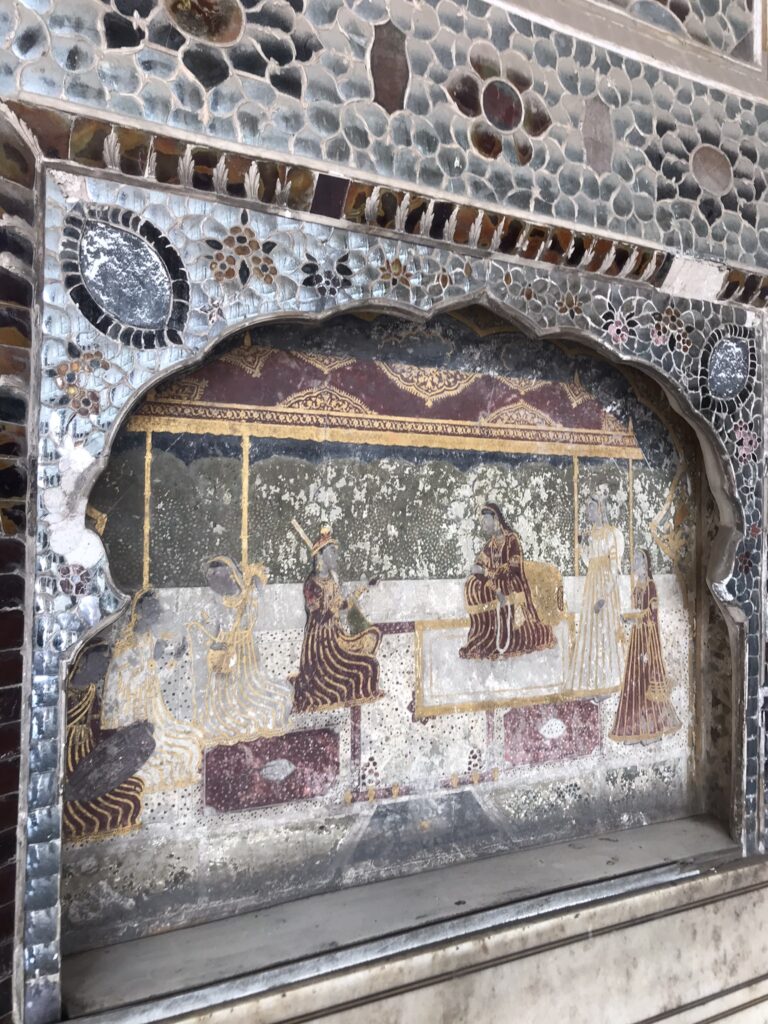

Intricate decoration in the sheesh mahal
There are plenty of information boards scattered around the fort so it’s not necessary to hire a guide at the entrance. The complex is quite large and on especially hot days you can hire a golf buggy with a driver who will take you around and point out the main areas of interest. We saw locals doing this and the price seemed very reasonable, however we weren’t sure if this service was in English or only Punjabi/Urdu.
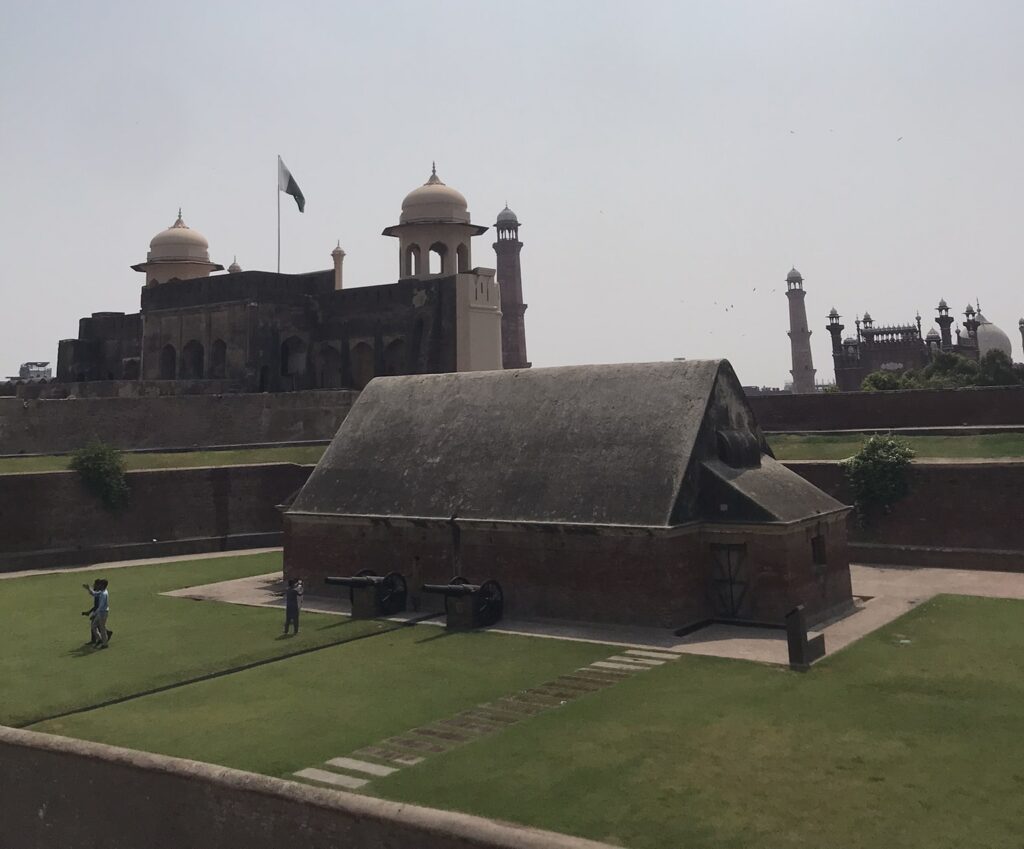
Inside the fort you will find 21 different structures surrounded by manicured lawns and gardens
The pictured tiles which cover the outside of the inner walls of the fort are the highlight of the whole complex, depicting colourful elephant fights, striking polo games and, strangely, floating angels. The Aga Khan foundation is in the process of restoring these picture walls.

The tile decorations on the external wall are a real highlight, featuring many depictions of fighting elephants
Gurdwara Dehra Sahib Sri Guru Arjan Dev (free entry) – a revered site of pilgrimage for followers of Sikhism due to its historical importance as the site where the 5th Sikh Guru was tortured for 5 days on the orders of the Mughal emperor Jahangir. The 19th century Sikh Maharaja, Ranjit Singh, commissioned the present Gurdwara after conquering Lahore. It now stands as a testament to the fact that the whole Punjab region was once part of the Sikh Empire with Lahore as its capital. The Partition of India in 1947 led to many religious buildings being trapped on one side or the other of the demarcation line. It’s now difficult for Indian Sikhs to visit this gurdwara as cross border travel for Indians and Pakistanis is severely restricted – as a result, Sikhs continue to be separated from their history and culture. Unfortunately the Gurdwara was closed when we tried to visit due to a festival taking place.
Badshahi Mosque (free entry but it’s nice to give a donation – the outside shoe dispensary is slightly expensive so make sure you check the price before using it) – this huge Mughal-era mosque is one of the most iconic sites in the city and in all of Pakistan. For several hundred years it was considered one of the largest mosques in the world and it’s still in the top 20 largest mosques globally, able to accommodate 100,000 worshippers at maximum capacity. It is symbolic of the grand buildings of the Mughal dynasty, crafted of exquisite red sandstone with intricate pietra dura marble inlay work.
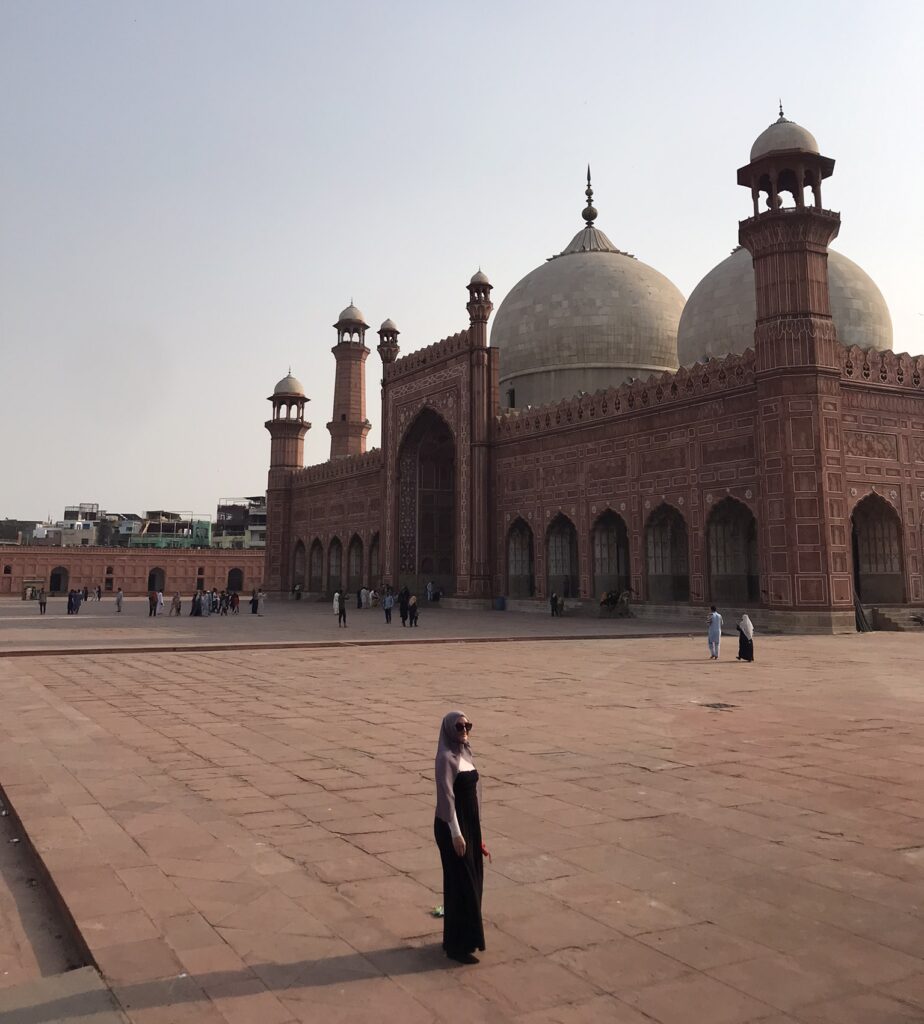
Badshahi Mosque is truly huge
Once you enter the mosque you might be directed to the right to visit a small exhibition containing relics of the prophet Mohammad (PBH). There is also a room dedicated to calligraphy. After having made a small donation you’ll then be pointed into the main courtyard of the mosque. You can explore the chambers surrounding the vast courtyard, but there isn’t much to see in them. The mosque was previously used as a place of worship by the Sikh empire and a military garrison by the British, but little evidence remains of those times. The mosque is particularly stunning at sunset.
Hazuri Bagh gardens (free entry) – as soon as you enter Roshnai Gate you are greeted by these beautiful gardens – very popular with locals as you don’t need to pay any admission fee to visit.
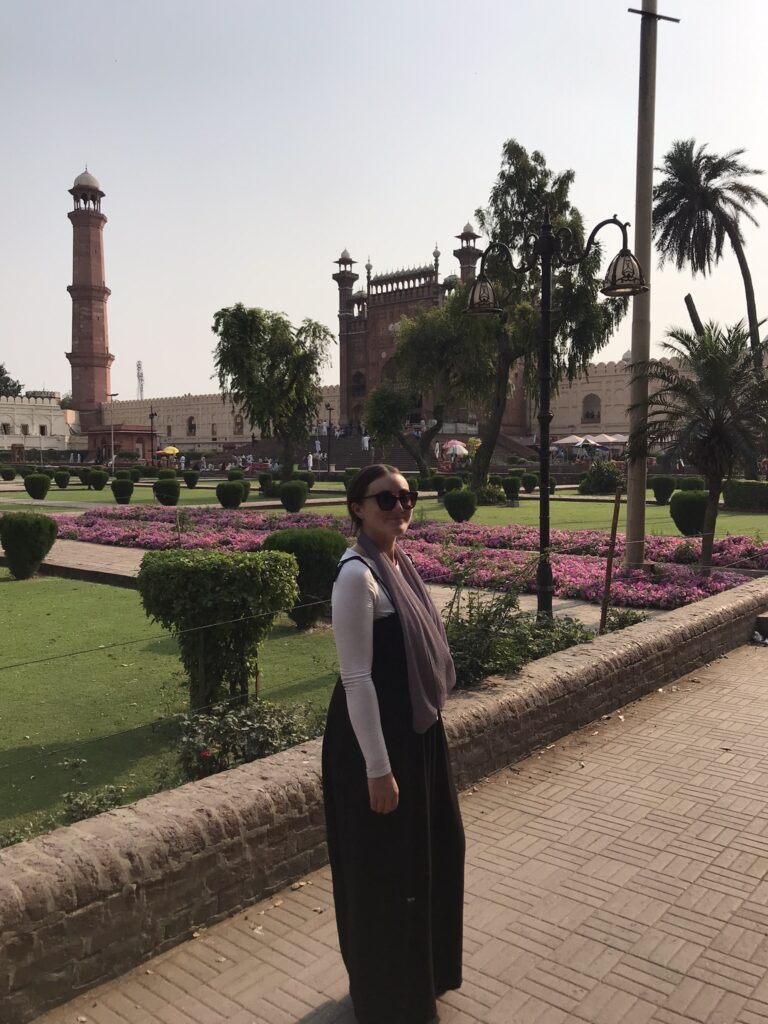
Hazuri Bagh is the central courtyard which is surrounded by Lahore Fort, Badshahi Mosque, the Tomb of Allama Muhammad Iqbal, Roshnai Gate and the Gurdwara
Tomb of Allama Muhammad Iqbal (free entry) – contains the grave of Muhammad Iqbal, the national poet and much revered ‘thinker of Pakistan’. This tomb is guarded by uniformed armed soldiers. You must remove your shoes before entering the miniature mausoleum as a sign of respect.
Minar-e-Pakistan (free entry) – situated in Greater Iqbal Park, this striking monument commemorates the site of the 1940 Lahore Resolution by Jinnah’s All-India Muslim League, which called for an independent nation for Indian Muslims. This later became the guiding principle of Partition in 1947, leading to the creation of the nation of Pakistan. It’s a symbol of the city and Pakistani independence. We read online that it may be possible to ascend to the top of the tower, however it was closed when we were there.
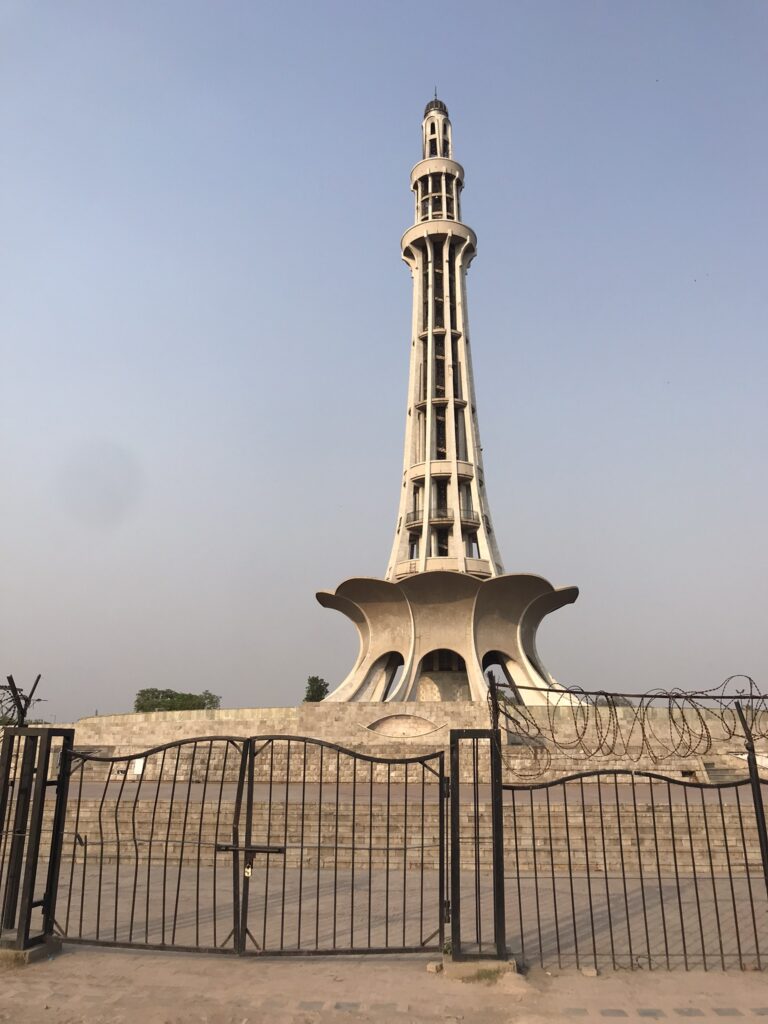
Minar-e-Pakistan is situated within Iqbal Park, but the actual tower was closed when we visited
Lahore Museum – a very extensive museum containing a mix of Islamic artifacts, pre-Islamic Buddhist pieces, some Chinese and miscellaneous world artifacts including part of Berlin Wall, Jain and Sikh exhibits, info about the Harappa/Indus Valley civilizations, Indian miniature paintings, an ‘independence gallery’ containing many photos of Jinnah and his compatriots, a weapons gallery, an ethnographic section with traditional clothing, arts and crafts from various ethnic groups throughout the different regions of Pakistan such as Hunza, Balochistan, Sindh, Chitral and Swat, and small art gallery featuring work from Pakistani artists. We spent several hours in the museum, which is located in a purpose-built British colonial building.
We were intrigued to learn from the museum’s Guest Relations Coordinator that Hinduism may have sprung from the Harappa Civilisation; an ancient seal has been discovered with a depiction of a many-headed god alongside a cow, which some experts believe to resemble the Hindu god Shiva. You can see evidence of this inside the museum, along with some other artefacts from one of the earliest human civilisations on the planet.
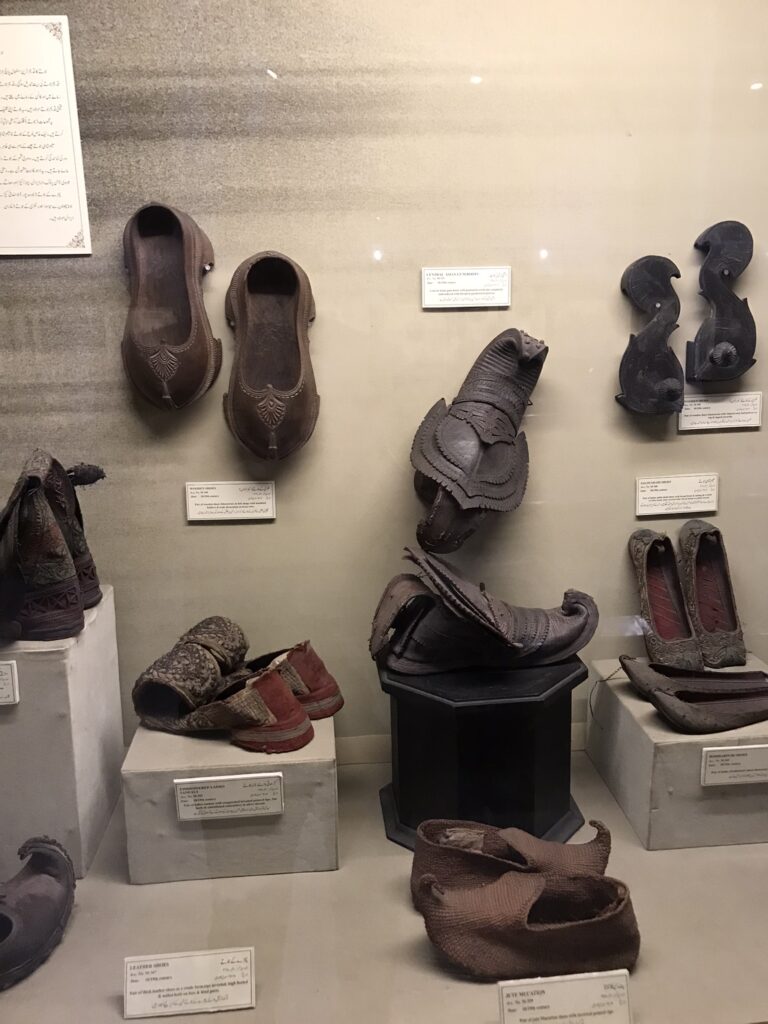

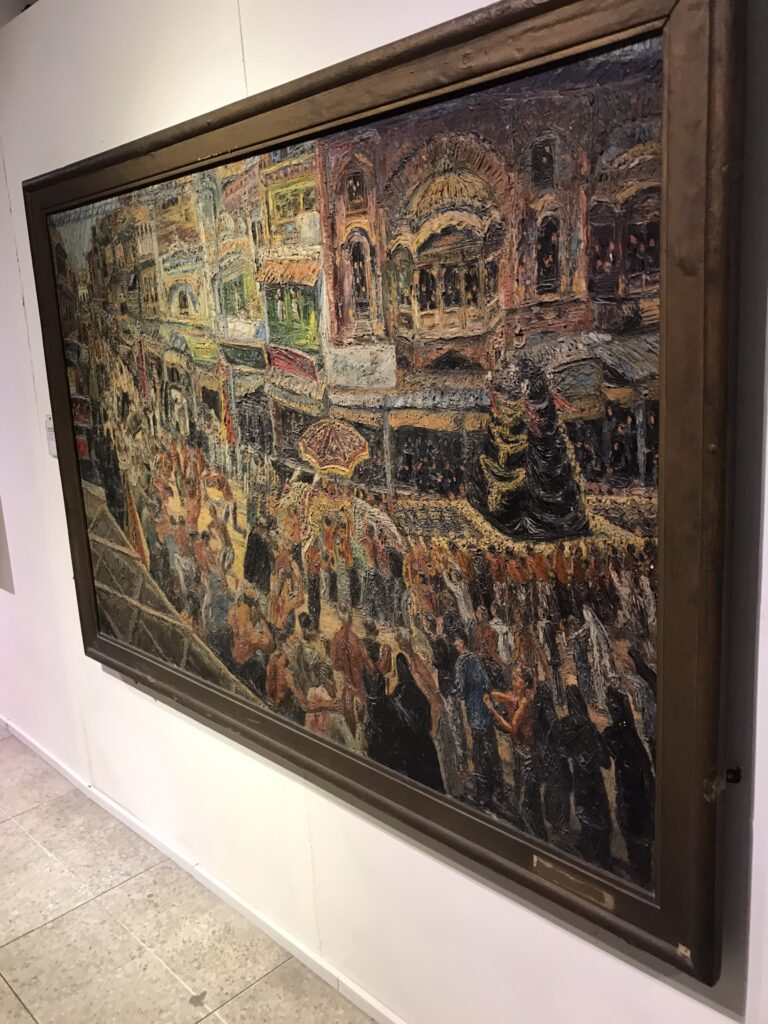
Artwork, artefacts and ethnographic displays can all be found inside the museum
Shalimar Gardens is the other UNESCO World Heritage listed site in Lahore. Unfortunately we didn’t make it inside due to an unexpected closure on the day we visited. I can confirm that it’s very easy to get there using the Lahore metro.
Islamabad
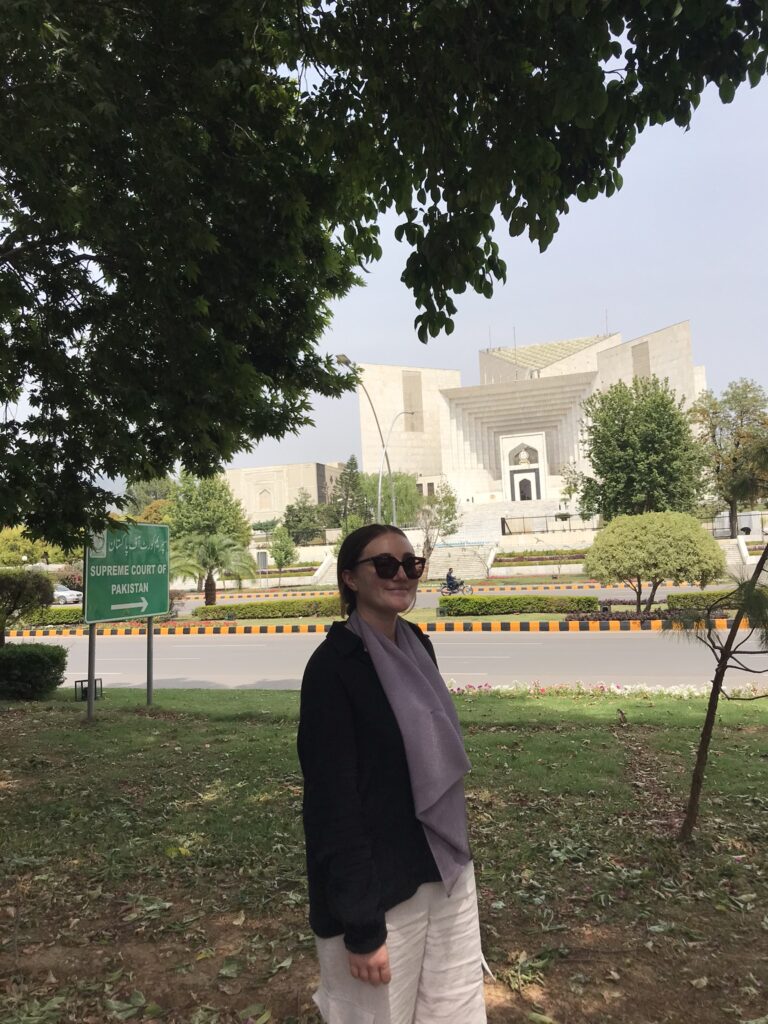
Islamabad is the shiny new capital of Pakistan, created in a bold move to distinguish itself post-independence. The name literally means ‘City of Islam’. It was constructed from scratch in the 1960s, with governance of the country transferred from Karachi to Islamabad in 1967. Due to its relatively new status, it remains only the tenth most populous city in Pakistan, although it forms part of a large urban area alongside its twin city Rawalpindi.
Islamabad stands out as a classic example of modern city planning, with wide boulevards and a sturdy grid layout. Each district is identified by a number and a letter, such as G-9. Because of this, Islamabad has a different feel to other Pakistani cities. The city is very spread out – it’s not actually that big geographically, but because of the spatial dispersion it is not really possible to reach all of the city’s attractions on foot easily. We actually found Islamabad to be a surprisingly desolate place, with lots of large empty lots and spaces. It seemed more like a vision of a ‘city of the future’ from the 1960s, as opposed to a flashy modern capital city like Astana in Kazakhstan.
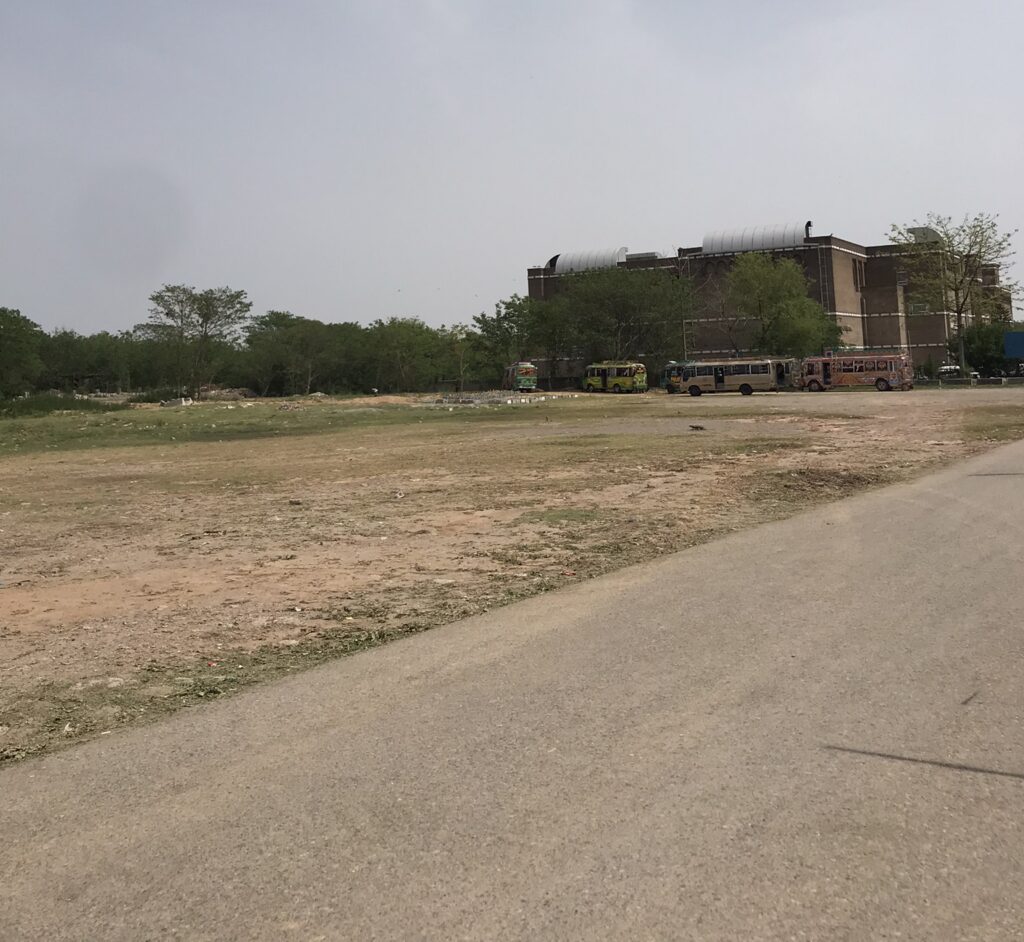
We found that these type of large empty lots were surprisingly common in Islamabad
Islamabad is situated around 300 kilometers from Lahore in the Punjab region, although it is technically not part of Punjab but is its own ‘federal territory’, Islamabad Capital Territory, which also borders the state of Khyber Pakhtunkhwa. Surrounded by the Margalla Hills, Islamabad has a more temperate climate than Lahore and other low-lying cities in the north. While it was 38 degrees celsius when we left Lahore, there was a torrential hailstorm just after we arrived in Islamabad – a local guy we met in a coffee shop showed us evidence of hailstones so big that they had caused damage to parked cars!
The ‘Red Zone’ at the far east end of Islamabad contains the nucleus of government (judicial, fiscal and legislative) with the High Court, Parliament Lodges, President and Prime Minister’s Official Residence and Parliament all located on the same street. This is technically a restricted area and there appeared to be police conducting vehicle searches at the checkpoint entrances to the zone. We entered on foot and were not stopped or checked at all, we were able to walk around freely and see all of the main government buildings (a favourite of ours when visiting a national capital, although in this case we decided that it was probably not a good idea to linger for too long or get too close).
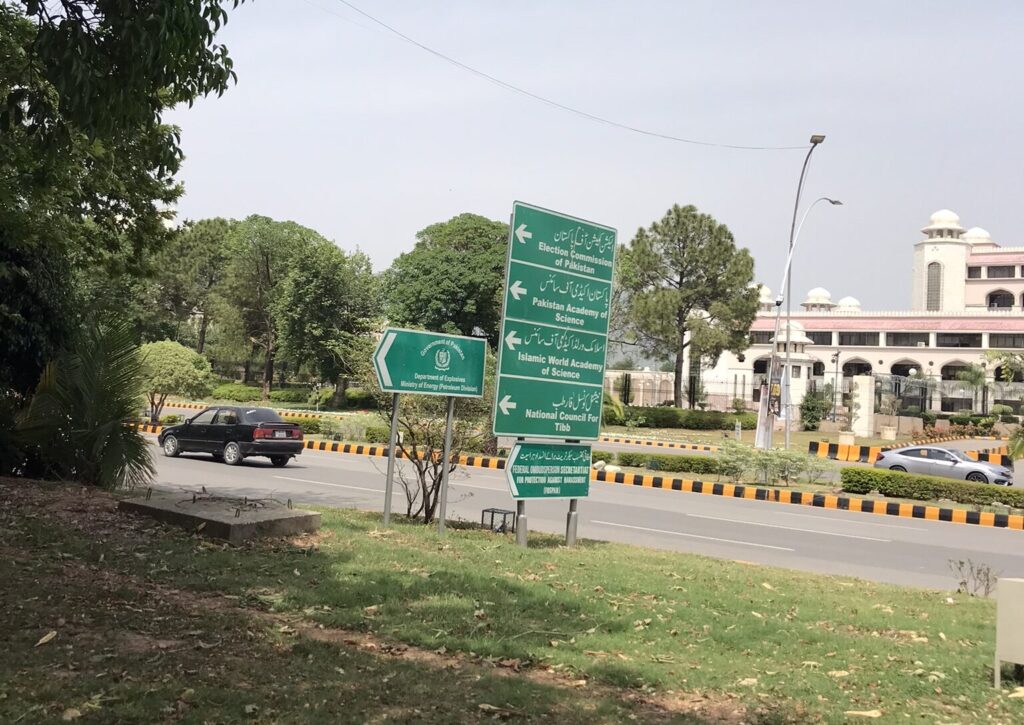
All manner of federal buildings can be found in the Red Zone
We couldn’t help but notice the amount of flashy cars sitting on the driveways of opulent mansions and the lack of ordinary people milling about on the streets near to the Red Zone.
Rawalpindi is the ‘ugly twin’ of Islamabad. Rawalpindi is everything Islamabad is not: a much older settlement, congested, overcrowded and polluted. For a more authentic Pakistani city experience, Rawalpindi could be an interesting place to spend a bit of time. The metro bus system links Islamabad and Rawalpindi, so they really are twins. Sadly we only had one full day in Islamabad before flying out so didn’t have time to explore Rawalpindi.
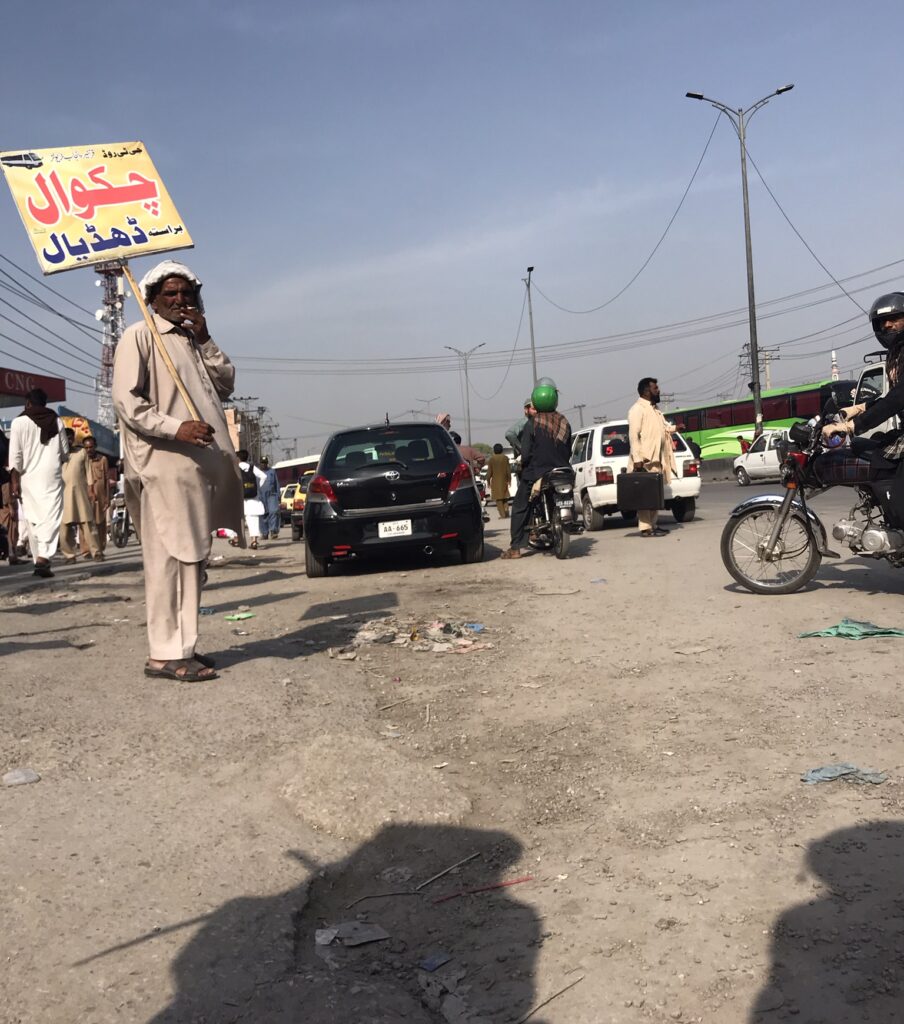
Street scenes in Rawalpindi near Faizabad bus station
When traveling to Islamabad via intercity bus from elsewhere in Pakistan, you’re likely to be dropped off at the Faizabad bus station. This is an overly chaotic area at the boundary between Islamabad and Rawalpindi. From Faizabad, it’s easy to get right to the heart of Islamabad using the metro bus system, which is similar to that in Lahore. The metro bus network in Islamabad/Rawalpindi is more extensive than Lahore, running right from the Red Zone through to the south of Rawalpindi. There is even an airport extension to the metro bus system, although I recommend just using InDrive to get to the airport as it’s likely to be much faster and easier.

Women and children first on the Islamabad/Rawalpindi metro bus
Accommodation
‘Rest house’ accommodation is quite popular in Islamabad as it’s both affordable and comfortable. Essentially this is a private house that has been turned into accommodation, as opposed to a commercial purpose-built hotel.
Holidazzle Lodge Islamabad – we had a peculiar experience here. At first, we had trouble checking in as we turned up to find no one home and nobody responding to our WhatsApp messages. A young lad arrived and showed us to our room and took payment. On the first morning we didn’t receive any breakfast – after a tentative message to the guy which he didn’t respond to, we accepted that breakfast wasn’t going to happen even though it was included in the price. The lad later apologised for this and said he would get us breakfast the next day, only for him to be late the next day with our breakfast as well. When we did receive breakfast it wasn’t great either. We figured that the usual owner/manager was away and had maybe left a helper in charge. All this aside, the rooms were clean and comfortable and the whole house seemed very quiet, eerily so at points for which we were eternally thankful as we needed the rest. Another perk is that there are kitchen facilities available for guests to use.
Foodie Places
Cafe SOIR – attached to the adjacent boutique hotel Sintra, this cafe serves a few decent meal options such as burgers and alfredo pasta, alongside a variety of tasty sweet treats and countless hot and cold drink options. If you’re staying nearby it’s your best bet for trustworthy food.
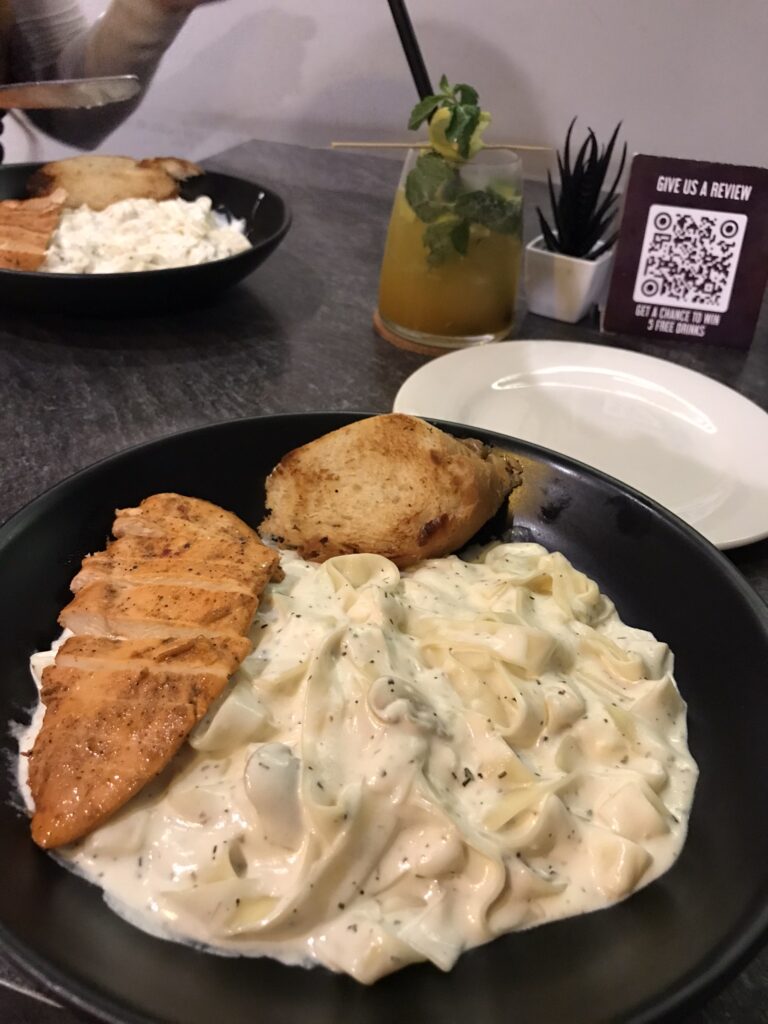
Chicken alfredo pasta at Cafe SOIR – a great choice if you fancy decent Western food
Second Cup Coffee Company – a stylish cafe in an upper-class area of the city. As well as serving a mighty fine cup of coffee you can also find smoothies, milkshakes and flavoured lemonade on the menu. They also have an impressive selection of sandwiches, burgers and main courses to satisfy even the fussiest of eaters. Prices are a little higher but the quality is there. It seems to be a meeting place for young rich socialites. We even spotted a few ladies wearing tight clothing and short-sleeved t-shirts. There are quite a few similar trendy coffee shops in the nearby area.
Activities
We focused our limited time in Islamabad on the Red Zone and nearby attractions, as they were all within walking distance of our accommodation.
Islamabad Museum – a compact museum tracing the history of Pakistan from the Harappa Civilisation in the Indus Valley to the advent of Buddhism and introduction of Islam. Located near to the Red Zone, the museum is free to visit. It’s not the largest or best museum in the country or even the city but is modern, neatly-presented and a great place to start for any budding historians. Be aware that it does close briefly on a Friday afternoon for prayers.
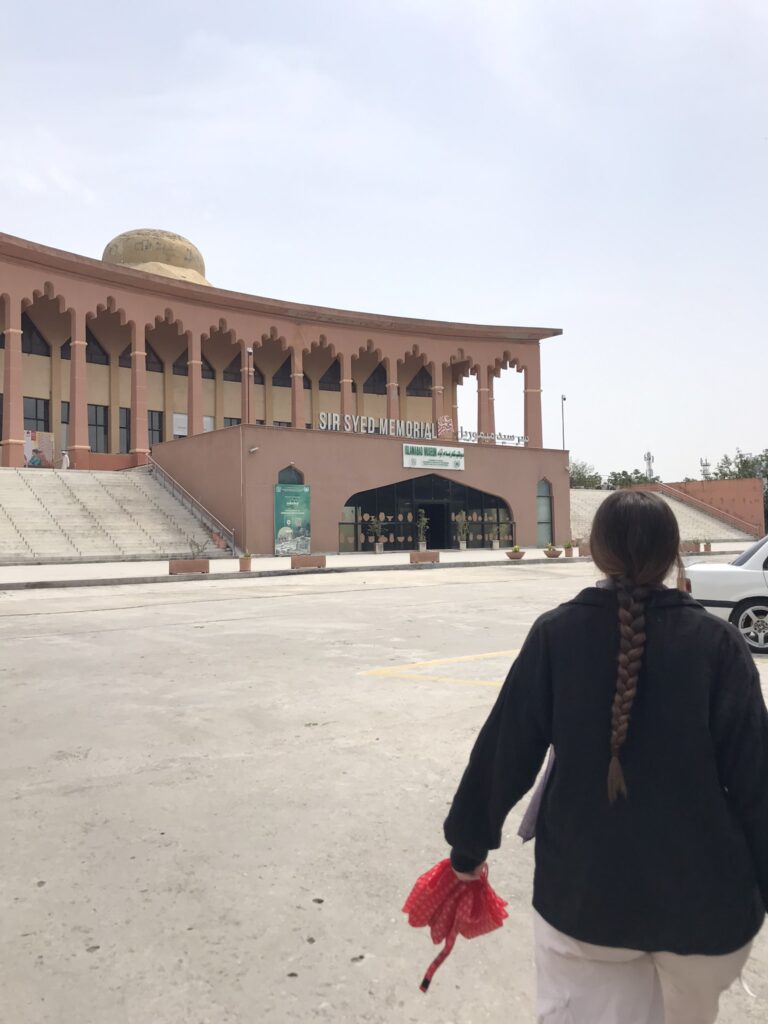
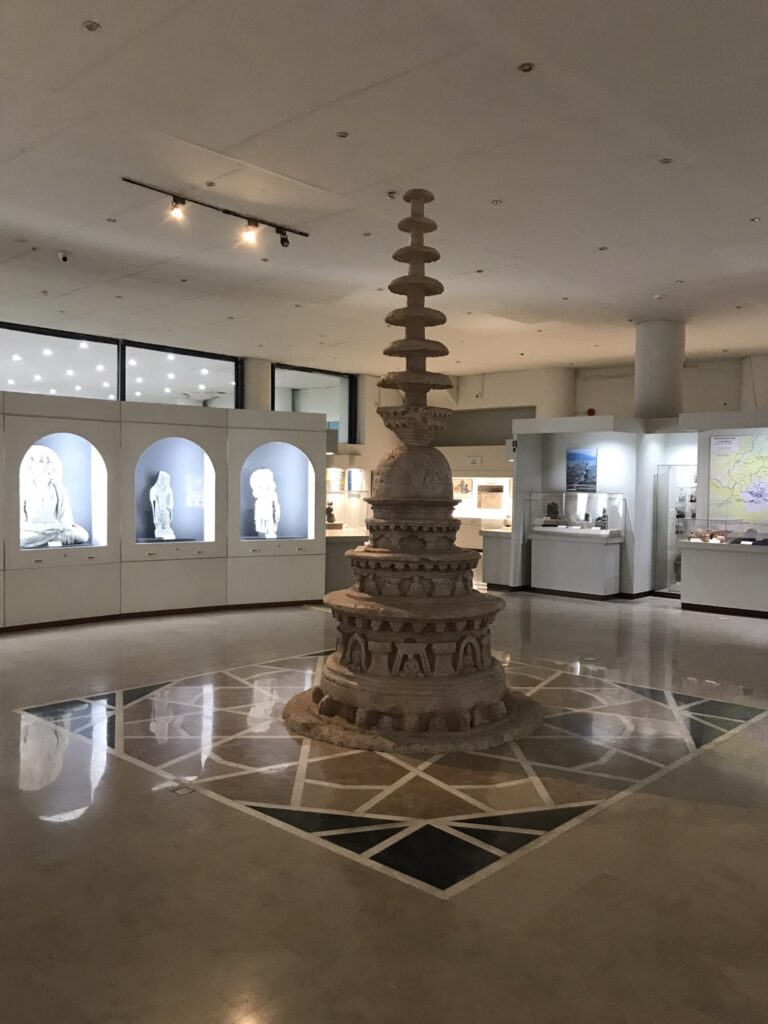
Inside and outside Islamabad Museum
Pakistan National Council of Arts (PNCA) – a bit of a bust really, this place is described as an art gallery but after arriving we realised that they only use the space to host special exhibitions from time to time and there is no permanent gallery. We did have a nice cold coke in the cafe though which revived us after walking in the heat to get there.
Red Zone – we expected access to be restricted in the Red Zone however this didn’t prove to be the case and we happily wandered around, passing the High Court, Parliament and Prime Minister and President’s Official Residence among many other buildings.
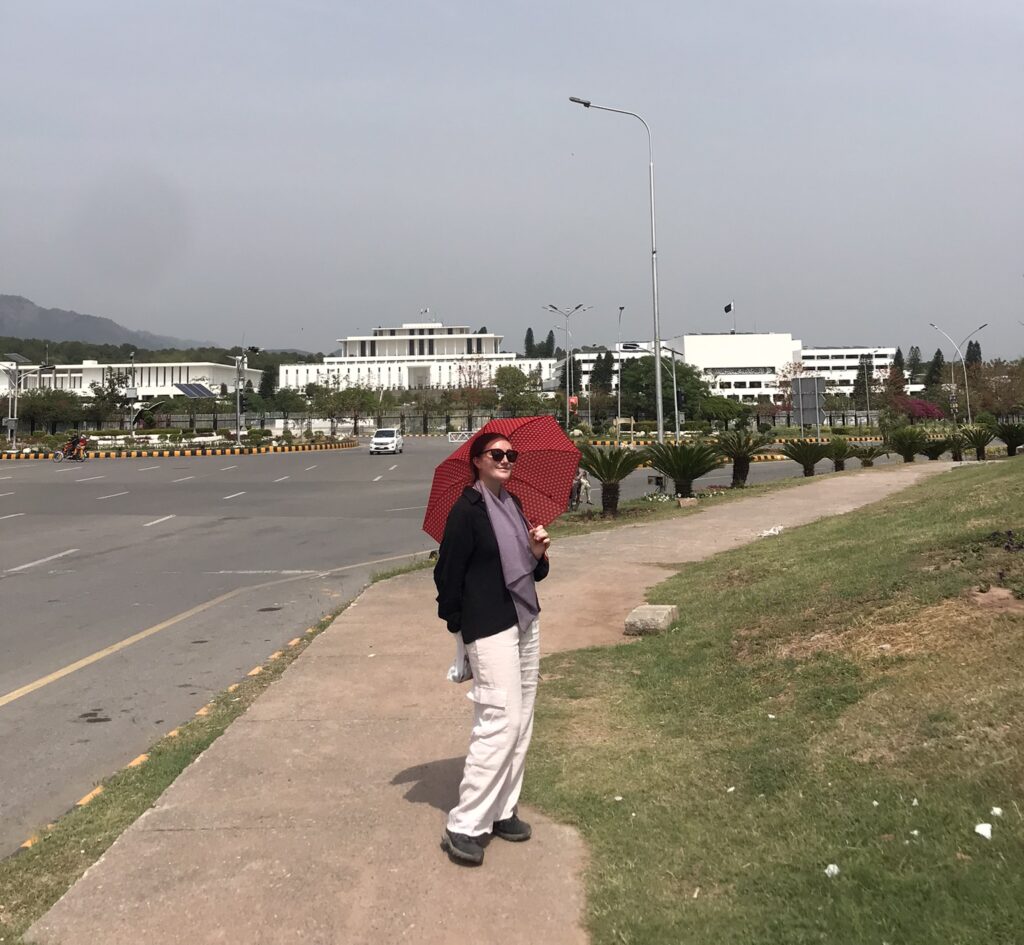
Roaming around the Red Zone
Because we only had one full day in Islamabad, we weren’t able to fully explore and see the best of the city. There are two major areas in Islamabad that we would’ve liked to explore. One is Shakarparian Park, which is home to the Pakistan Monument and Monument Museum, Lok Virsa Heritage Museum and a rose and jasmine garden. The other is the Margalla Hills, including Daman-e-Koh park and a couple of viewpoints across the city and over the Faisal Mosque, which is the largest mosque in Pakistan and one of the largest in the world.
We also wanted to see the Buddhist archaeological remains in Taxila (UNESCO World Heritage site) but this unfortunately wasn’t possible with our itinerary. Nearby Murree is a popular hill station (hillside town) for those with extra time to spend in the area. Rawalpindi would’ve also been pretty cool to visit but we didn’t have time due to restrictive flight schedules at the time we were traveling.
Gilgit-Baltistan
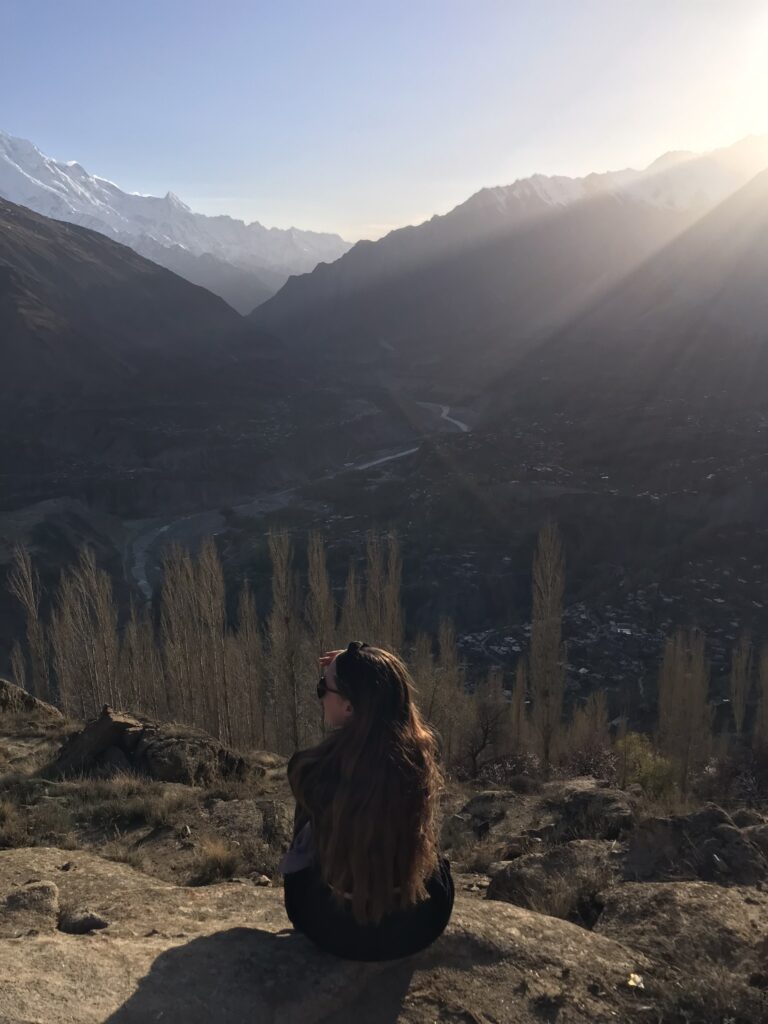
Gilgit-Baltistan, located at the north-east of Pakistan within the disputed Kashmir region, is one of the most stunning regions in Pakistan. Containing some of the world’s highest mountains, it seems like a different planet from the intense heat and bustling streets of Rawalpindi and Lahore, both geographically and culturally. The local people in Gilgit-Baltistan have a distinct cultural heritage which is mostly free from the influence of the Mughals and the British, and instead shares more similarities with the Pamiri mountain dwellers in south-eastern Tajikistan. We also found some of the landscapes in Gilgit-Baltistan to be similar to those we encountered along the Pamir Highway. Small, remote villages are dotted around enormous, sweeping valleys surrounded by 6,000m+ mountain peaks. It truly is a spectacular place.
Although it is probably the most popular destination in Pakistan for both foreign and domestic tourists, getting to and from Gilgit-Baltistan region is no mean feat. Click here for my guide to getting there and getting around once you arrive!
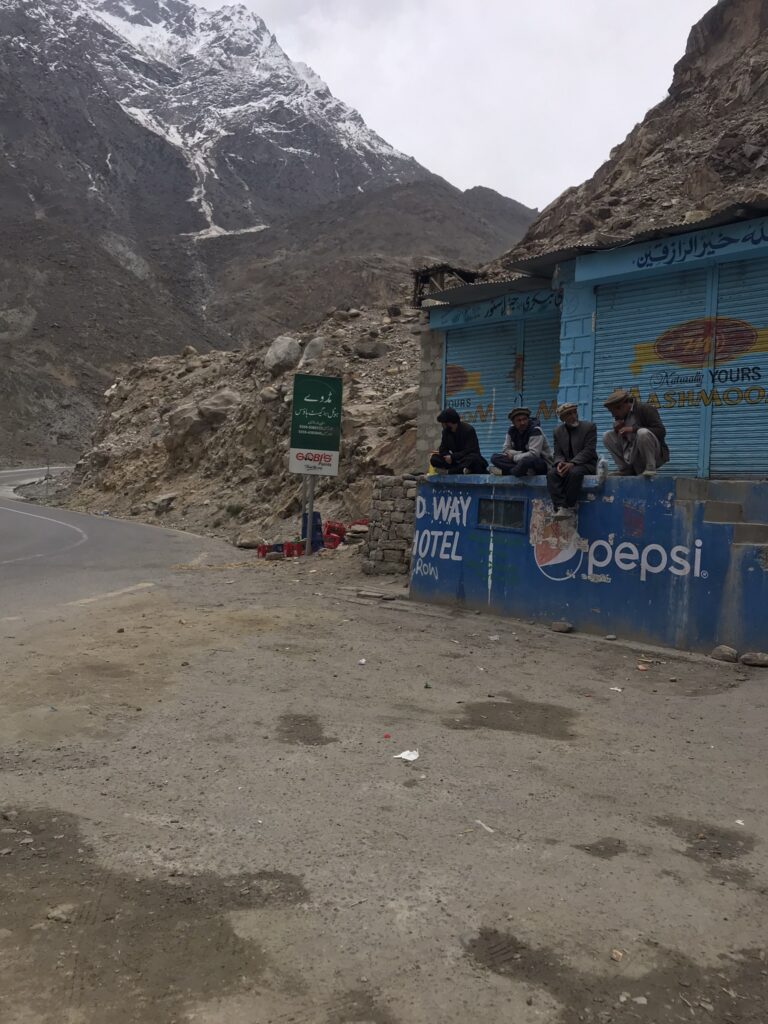
Local men at the services on the Skardu-Gilgit road
Gilgit-Baltistan, unlike the other provinces, has a certain degree of autonomy and special status in Pakistan. We even spotted a Gilgit-Baltistan government building in Islamabad. Citizens are granted special privileges such as exemption from customs tax for cars, and depending on their culture they may be permitted to consume home-brewed alcohol like arak at special occasions and weddings. Because of the diversity of cultures in Gilgit-Baltistan you can find locals with lighter skin, blue eyes, and ginger hair. You can also find Pakistan’s largest concentration of Shia Muslims. The Hunza region in particular has a large number of Ismailis (one of the most liberal branches of Islam), and it is common to see women with uncovered hair in this area.
Each community in Gilgit-Baltistan has its own distinct cultural identity, language, traditions, stories and cuisine. Because of the remote and inhospitable mountain conditions, small communities have been relatively isolated and developed differently over time, meaning there can be a lot of variation even in a relatively small area. In Aliabad and Karimabad, residents speak the Burushaski language while 40 kilometers away in the village of Gulmit, in the shadow of the Passu Cones, Wakhi (an Afghan language) is spoken. While driving with our host Noushad from Karimabad we visited his friend Shakeel in Gulmit and were intrigued to discover that both friends had to communicate in Urdu, as their first languages were Wakhi and Burusho respectively even though they grew up only 40 kilometers from one another. A Japanese professor of linguistics has studied the Burusho language and is a local hero in the region as he regularly visits to practise talking with locals in their mother tongue. We saw heart-warming videos of locals excitedly chatting away with the Japanese professor, one of the few outsiders to speak their language. Balti and Shina are other local languages which are prominently spoken in Gilgit-Baltistan.
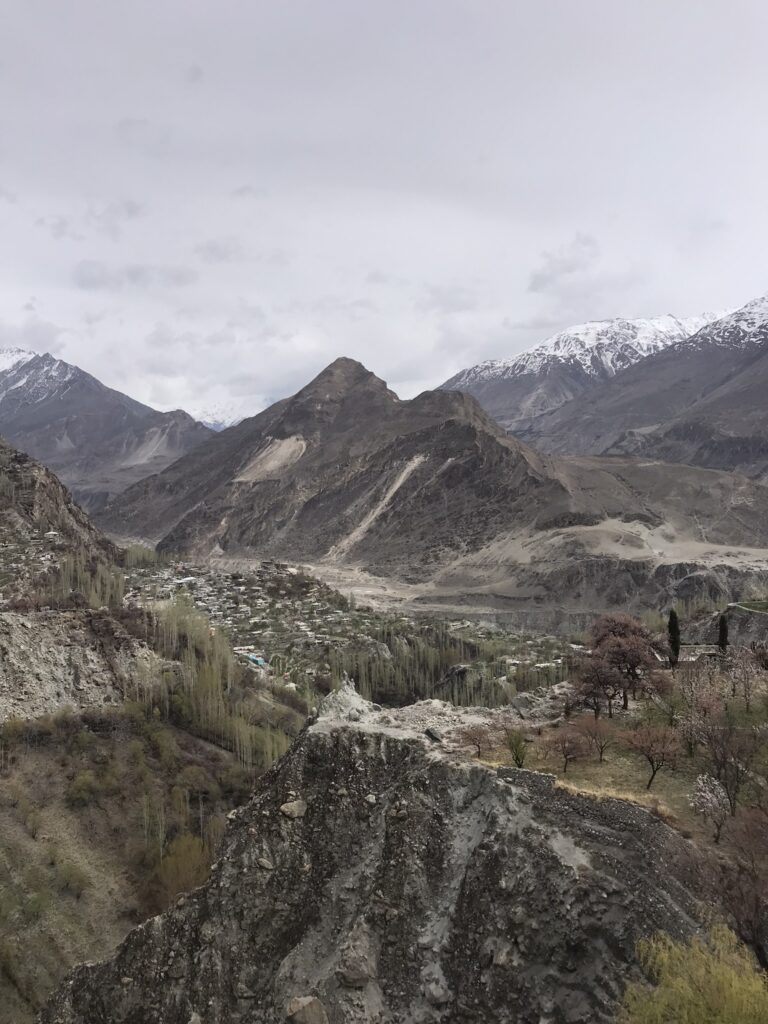
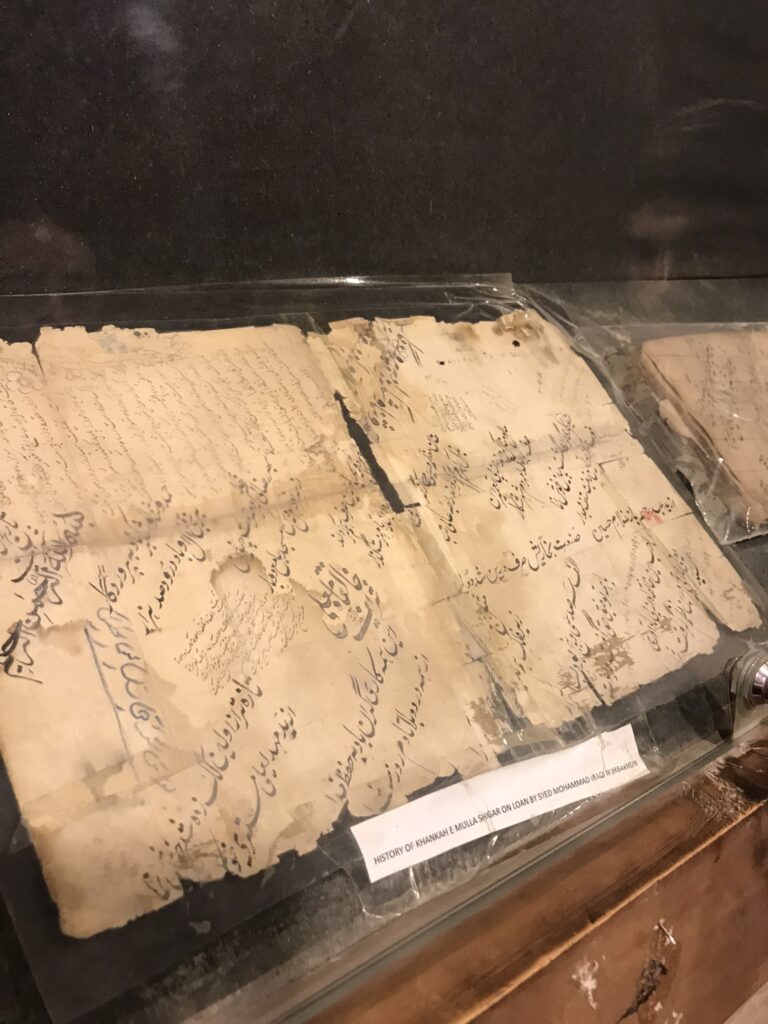
Gilgit-Baltistan is home to dramatic landscapes and ancient cultures
In recent times the region has been opened up with the construction of new roads linking these once remote mountainous communities. The Karakoram Highway is the major thoroughfare in the region, linking Islamabad with Gilgit and Hunza en route to Kashgar in China. This road is immaculate – China recently financed the construction of both the road and various tunnels as part of their Belt and Road initiative, providing safe passage for trucks and other trade vehicles to China. Unfortunately the other main road in Gilgit-Baltistan, between Skardu and Giglit, is not good at all. Built by the Pakistani Military, the Skardu-Gilgit road does not have the same tunnels as the Chinese-built road and is particularly treacherous for landslides during rainy conditions; we personally saw piles of fallen rock on the road, with the military regularly called in to launch clear-up operations. We were told that this road route is sometimes entirely closed, with fatalities common.
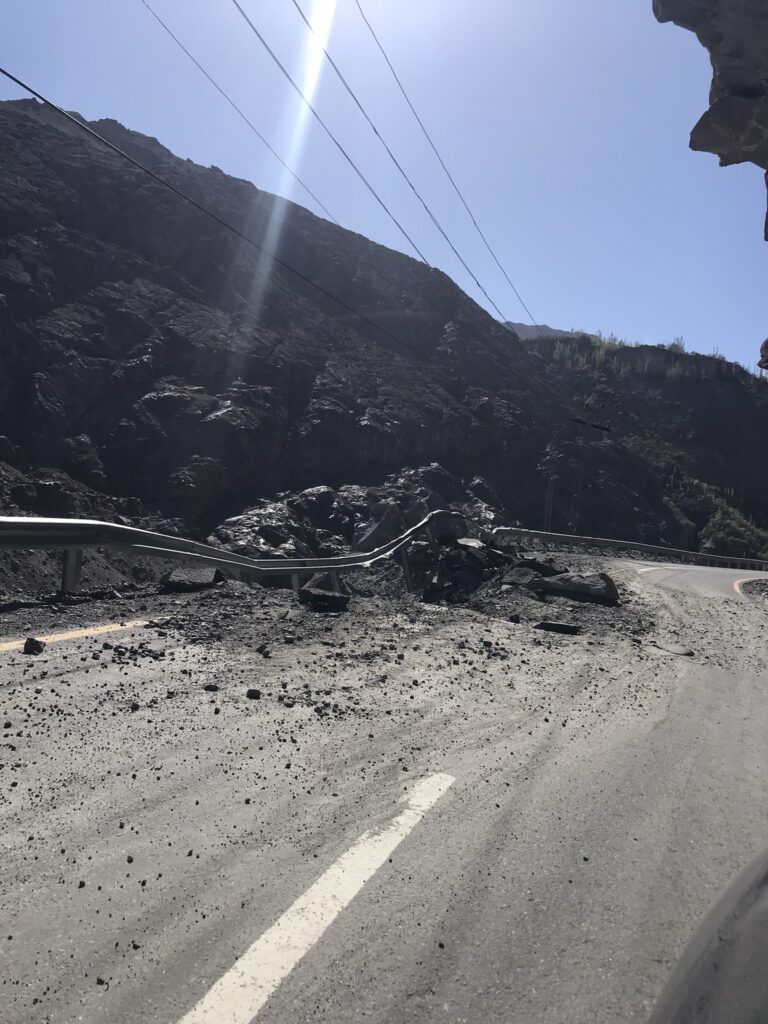
After driving past the 10th set of mangled barriers and enormous stones in the road you start to get used to it
Winter is NOT a good time to visit Gilgit-Baltistan. Residents who can afford to do so usually fly south for the milder winter conditions, leaving behind those who have to suffer through near constant electricity cuts (sometimes only 1 hour of electricity per day) and harsh weather conditions. Think -15C with no electricity! Flights operate sporadically if at all during the winter. Even during the spring, summer and autumn months electricity is a commodity and not a constant, with an average of 6 hours per day the usual. Most guesthouses and upmarket restaurants have backup generators for when the inevitable power cuts happen. Gilgit-Baltistan also struggles with water scarcity during the winter months and then too much water in the warmer months as the glacier and snow melt. When visiting the region, don’t always expect uninterrupted access to luxuries like mobile phone coverage, electricity and warm showers. It’s a remote, mountainous place, and the fact that such infrastructure exists at all in the region is an achievement.
Most of the larger settlements in Gilgit-Baltistan tend to be based in the flat valleys surrounded by imposing mountains, where the weather is slightly milder and altitude much lower. Skardu and Gilgit are prime examples. Other smaller communities can be found high up in the mountains. Despite its remote and isolated setting, Gilgit-Baltistan did not feel like a desolate or insular place to us. The major cities were relatively cosmopolitan, families from the cities often send their children away to the larger metropolises of Lahore and Islamabad to continue their studies and we found many people in the region to be surprisingly well-educated and worldly.
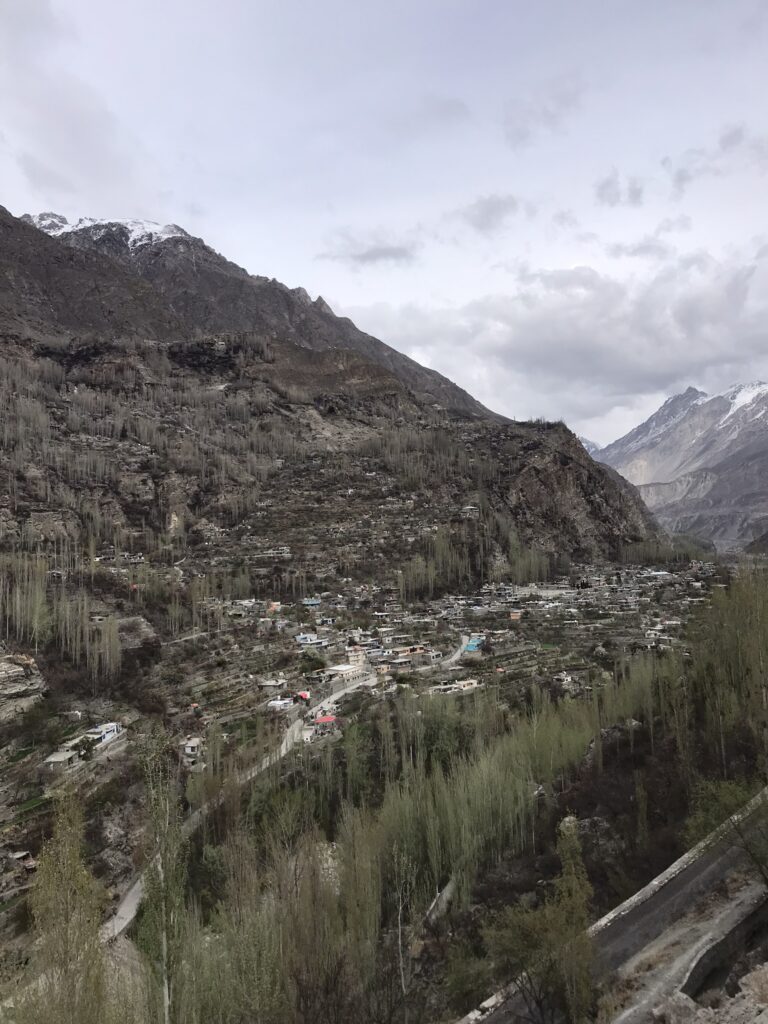
Settlements in Gilgit-Baltistan are often sheltered by the mountains but can still get extremely cold in winter
Gilgit-Baltistan is breathtaking during the blossom season. Usually this takes place in the first few weeks of April, although the trees blossom at different times depending on the altitude. It was fascinating to see at higher altitudes that the trees had not yet started to blossom when we visited in mid-April. Spring and autumn are the best seasons to visit for foreign tourists, as domestic tourists from the other regions of Pakistan swarm the area in the summer to get away from the overbearing heat in the south of the country. We were surprised to see so many guesthouses and hotels in really remote areas – apparently all of these are full in the summer months, which tells you just how many Pakistani city dwellers flock to the region for their summer holidays. There is some concern about overtourism in the Hunza region – according to our host in Karimabad, the area becomes inundated with noise and traffic jams as a result of the hordes of domestic tourists. Intolerable he said! The narrow mountain roads and hairpin bends surrounding Karimabad are not designed for such an influx of people.
In the summer months, the valleys and meadows are vibrant and green – in spring and autumn, there is noticeably less greenery around but still bursts of colour. We visited during the early springtime in April, which was right at the start of the local tourism season with things just starting to open back up. We found that this was a great time to visit – it coincided with the blossom season, the weather was good and the region was quiet and peaceful with only small handfuls of domestic tourists about. However there were still a few drawbacks to visiting at this time of year – a couple of the major tourist spots, Basho Meadows and Fairy Meadows, tend to still be blanketed with snow until later in the spring. We didn’t make it to these places in the end as we were discouraged from attempting to visit by locals. The best time to visit Fairy Meadows is during the summer months, as snowy conditions are the norm in April.
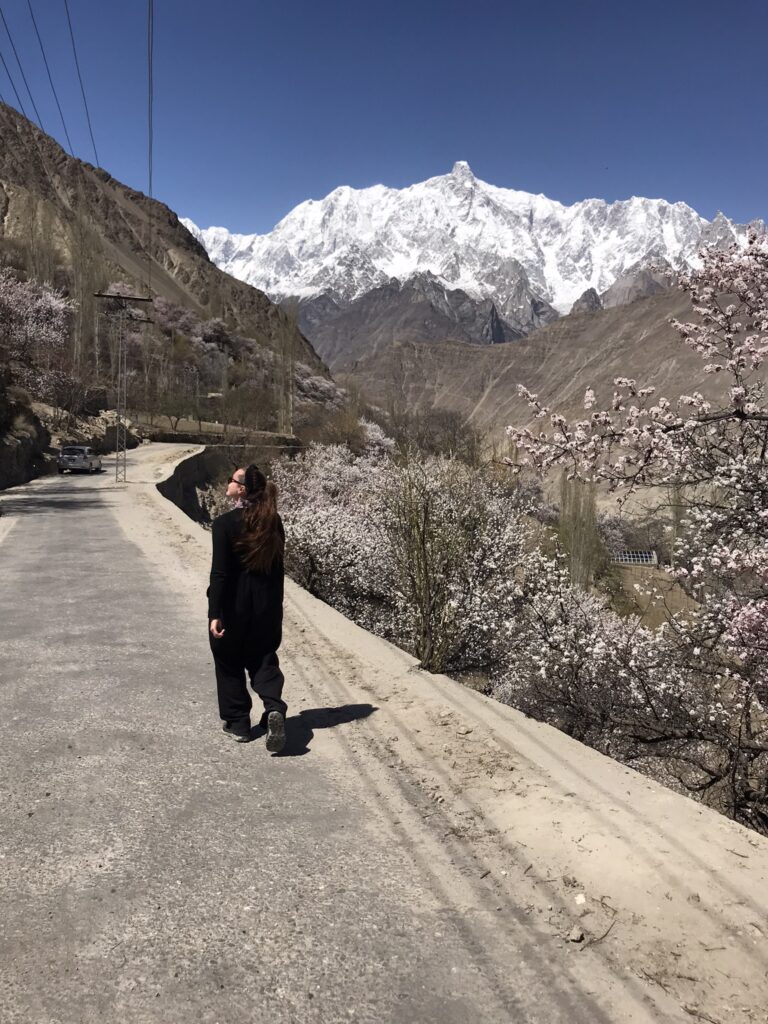
Blossom season in early April is a great time to visit Gilgit-Baltistan
We were surprised to see large East and Southeast Asian tour groups being ferried about in hefty buses in the Hunza region: we spotted groups from Vietnam, Thailand, Malaysia, Indonesia and Singapore, much to our surprise. It was explained to us that local travel agencies in these countries heavily market trips to Gilgit-Baltistan. These groups made up the overwhelming majority of foreign tourists that we saw.
Aside from tourism, one of the major industries in Gilgit-Baltistan is gem mining. The region is rich in rare minerals – you can see evidence of this from the abundance of genuine gem stalls and shops in most of the main tourist spots. Once spotted it’s impossible to miss the swiss-cheese effect of small mining operations on the Skardu-Gilgit road as gemstone miners burrow into the rock face to extract precious jewels. One gemstone miner that we found ourselves sharing a taxi with showed us videos of huge chunks of amethyst and aquamarine that we presume he had mined himself.
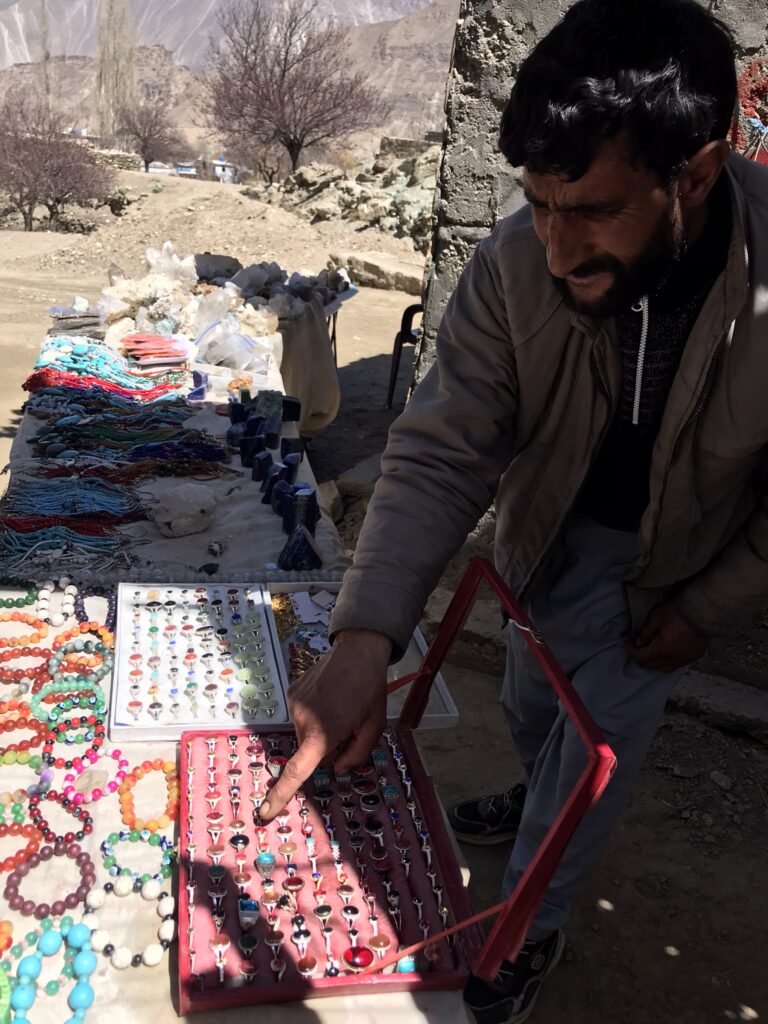
Mining and selling gems is big business for independent traders in Gilgit-Baltistan
Apricots are another highly prized product of the region: they’re dried as snacks, made into juice, baked in cakes, turned into apricot oil used during cooking and stored in jars as jam. Most local dishes in Gilgit-Baltistan contain at least some form of apricot. Yak meat is another local staple. Traditional Gilgit-Baltistan cuisine is quite unique and different to the food in the rest of Pakistan, although popular Pakistani dishes like karahi are still widely available in the region.
Gilgit-Baltistan used to be self-sufficient and produce its own food, however due to demand most products are now imported from Punjab and no longer grown in the region. The good news is that food and other products are still relatively affordable considering they’ve been transported quite a long distance by road. Keep an eye out for the eye-catching quirky colourful trucks chugging along the Karakoram Highway and the road between Skardu and Gilgit. These are a true emblem of Pakistan! Because Gilgit-Baltistan is part of the wider disputed Kashmir area, the Pakistani military now has a heavy presence in Gilgit-Baltistan and the UN also has a peacekeeping force in the area – we actually saw UN trucks making their way along the Karakoram Highway.
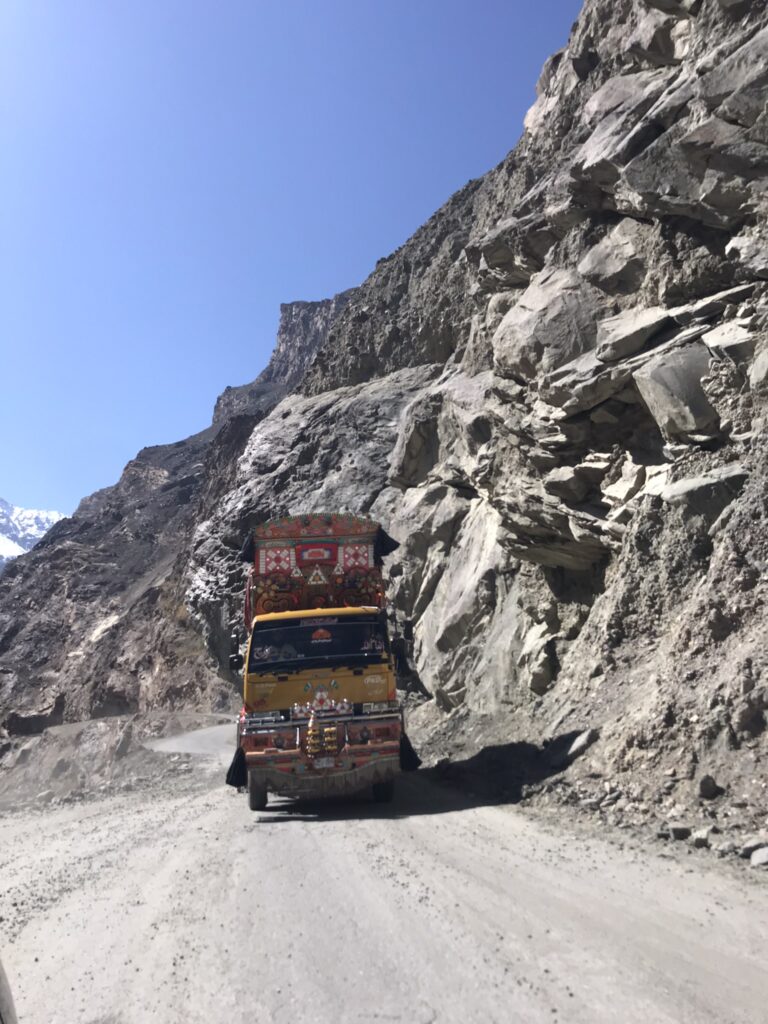
These funky trucks can be found everywhere in Pakistan
One quirk which we didn’t expect to find is that the region of Gilgit-Baltistan is polo mad! Along with Chitral in nearby Khyber Pakhtunkhwa, polo is a part of the cultural fabric of the region. We had no idea how old the game of polo was – its history in this area dates back to the early 1600s. In Gilgit-Baltistan, the regional variant is described as ‘freestyle polo’ – apparently it can get quite violent as there are essentially no rules. Kicking, hitting and pushing are allowed. Very different to the modern form of polo played in the west by upper-class English gentry types. The big match between Gilgit and Chitral is held in the summer and is said to be the pinnacle of Gilgit-Baltistan polo. You can find polo grounds in most cities and towns, some of them dating back hundreds of years.
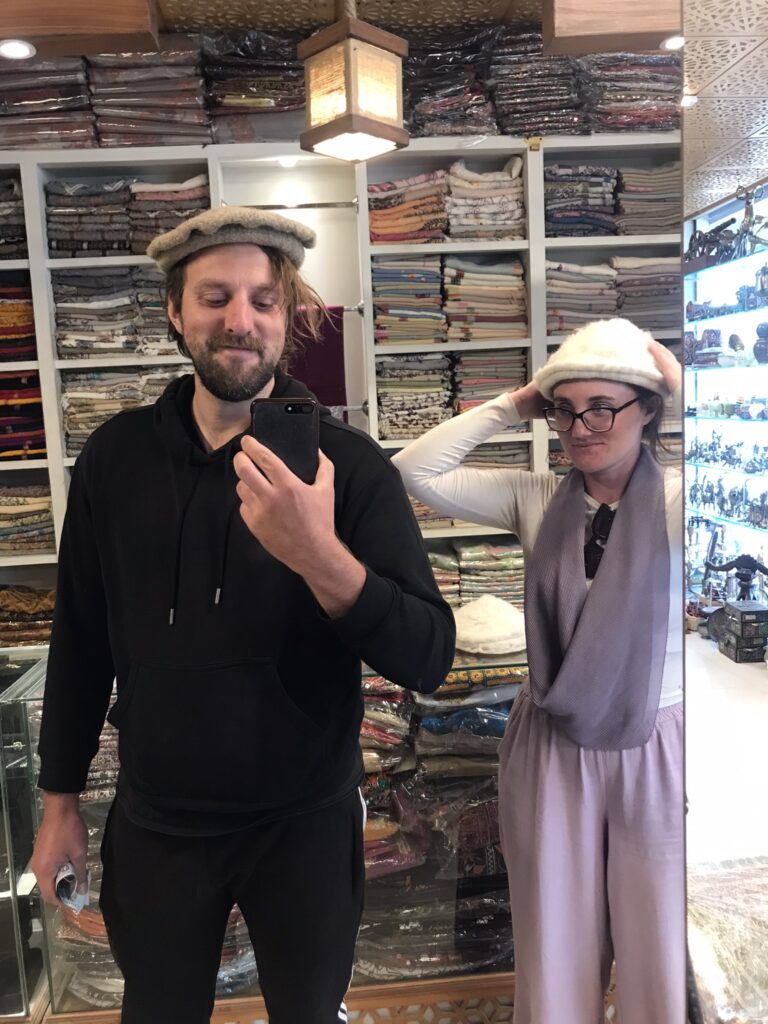
The Balti hat, still worn by locals, is another popular souvenir for tourists – we couldn’t resist
Skardu
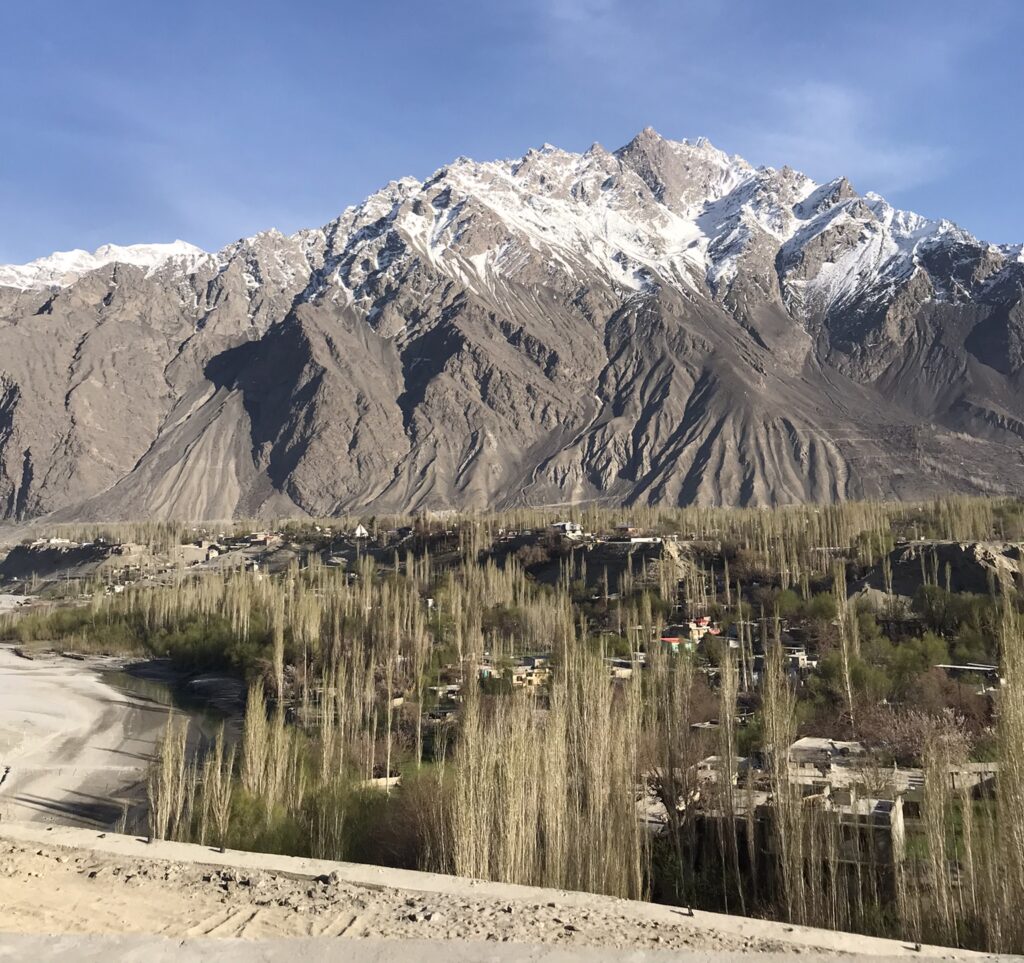
Located in the south-east of Gilgit-Baltistan, Skardu is at the centre of one of the region’s two major tourist hubs – the other being the area around the Hunza Valley in the north. Skardu is the heart of the ‘Baltistan’ part of Gilgit-Baltistan, a majority Shia Muslim area where the Balti language has historically been dominant (although today Urdu is widely spoken by the local people).
Skardu is the largest city in Gilgit-Baltistan, a regional hub surrounded by many smaller settlements. However Skardu itself is small by Pakistani standards – when walking around the streets it really felt more like a large town than a major city, and we were surprised to see how far out the settlement actually extended when we got a bird’s-eye view from Kharphocho Fort. The city lies along the banks of the famous Indus River, surrounded by snow-capped mountains and amidst so-called cold deserts – large, flat, desolate plains which are a hallmark of the area.

Vast cold deserts are a major feature of the Skardu region – the river in the middle is the Indus
Skardu is a fairly conservative city, especially compared to some other parts of Gilgit-Baltistan such as the Hunza region. Almost all women in Skardu are covered in public and even the tiny primary school girls cover their hair. Despite being a tourism hotspot, we got the impression that not many foreign visitors walk around the city as we received quite a few curious stares from locals. We would guess that visitors base themselves in Skardu but spend most of the day exploring the natural landscapes outside the city.
We also received many warm smiles and greetings from locals in Skardu. The people seemed to be quite friendly, with a typical Pakistani sense of hospitality. While walking up to the Manthal Buddha Rock, we stopped to catch our breath outside a random house. A young local guy from the house noticed that we were tired and came out to offer us chai – we agreed, thinking that he would maybe bring us out a cup but he then proceeded to invite us into his house to sit, chat and drink chai for half an hour with his family who even provided us with some snacks!
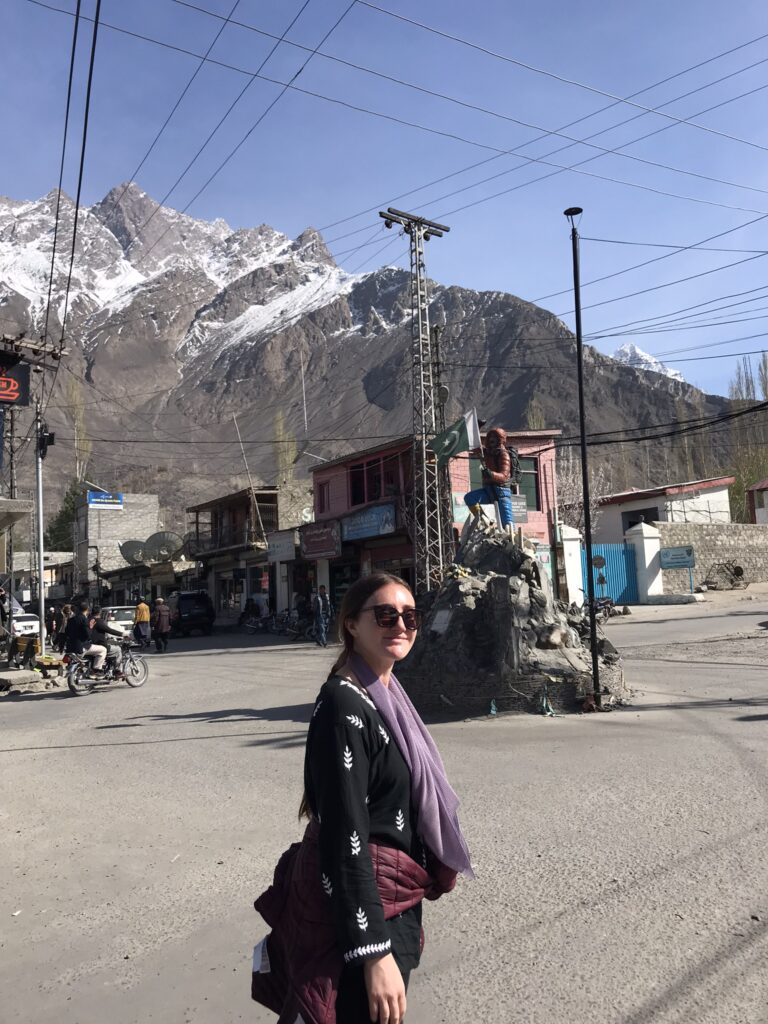
On the streets of Skardu
We noticed that Google Maps is not very accurate in Skardu, especially for elevation and walking times – particularly for the route up to Kharphocho fort. Weather forecasts were also not very accurate on any of the weather apps that we usually use. Skardu actually felt much warmer than we expected. The apps were predicting temperatures of 4 or 5 degrees celsius but in reality it felt closer to 15 or 20! At times we had to take our hoodies off while walking around the city as we were too hot – I’m not sure if this is normal or if it was just a particularly warm few days when we were visiting.
Skardu is home to the largest, most reliable airport in Gilgit-Baltistan. Skardu Airport is large enough to accommodate Boeing-style planes, whilst the other airport in the region (Gilgit) is restricted to smaller planes. This means that Skardu is a more reliable choice with fewer flight cancellations than Gilgit, although cancellations and delays do still happen frequently. Skardu Airport has recently been upgraded to international status with the launch of international flights to and from Dubai, although these were not running when we visited.
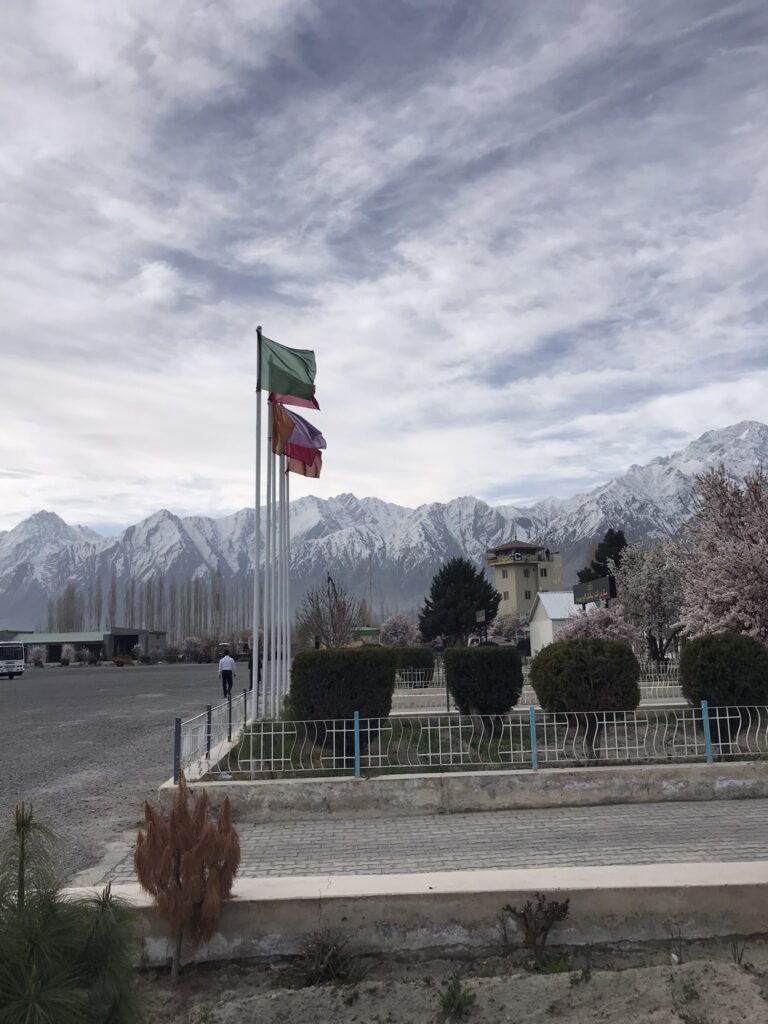

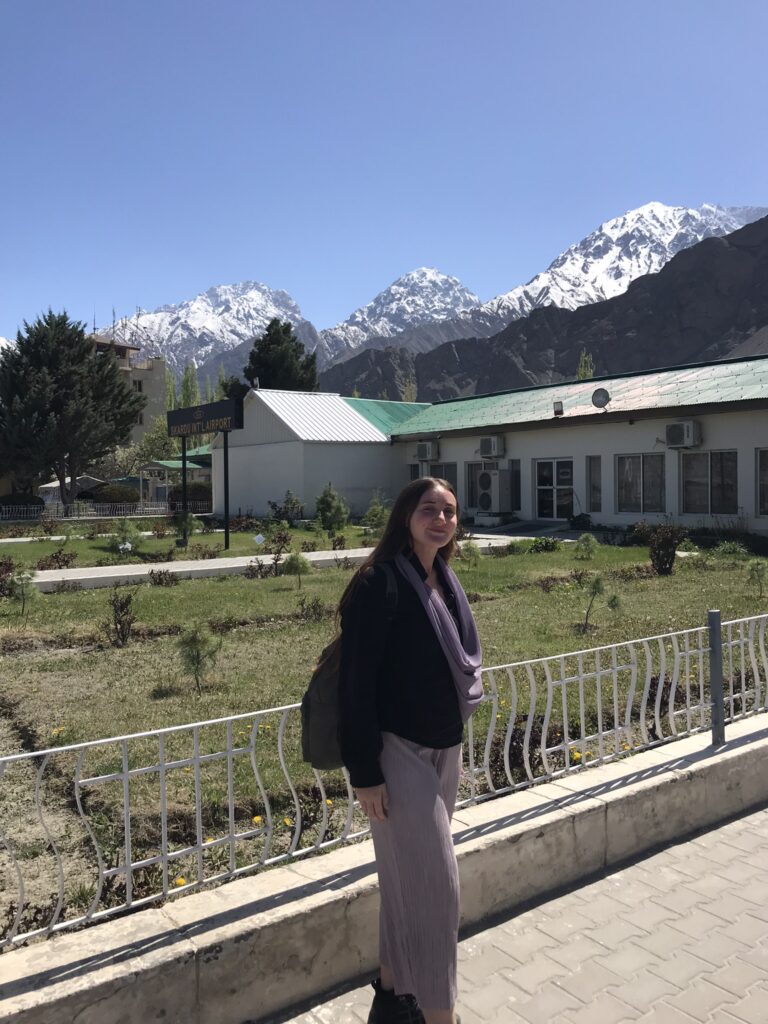
Skardu airport is one of the more interesting in the world, it feels like arriving on a different planet
The airport is located a little way out of town – we arranged for a transfer with our guesthouse, who sent an ‘uncle’ to come and get us, however there were also taxis waiting outside. The airport only receives a few flights per day so the drivers know when to arrive. Apart from by air, Skardu is linked to the Karakoram Highway and the rest of Pakistan by a fairly sketchy mountain road. Click here to for my Gilgit-Baltistan public transport tips!
Skardu also happens to be the closest major city to K2, the world’s second-highest mountain. The nearby town of Askole, approximately 6 hours drive from Skardu, is considered the gateway to K2 from where intrepid trekkers start their hike to the base camp. K2 is not visible from Skardu and a gruelling, multi-day trek is required just to be able to catch a glimpse of the imposing mountain. If this doesn’t underline how remote and unforgiving K2 is, I don’t know what does. K2 has a staggering mortality rate for climbers of almost 25%, which is much higher than Everest.
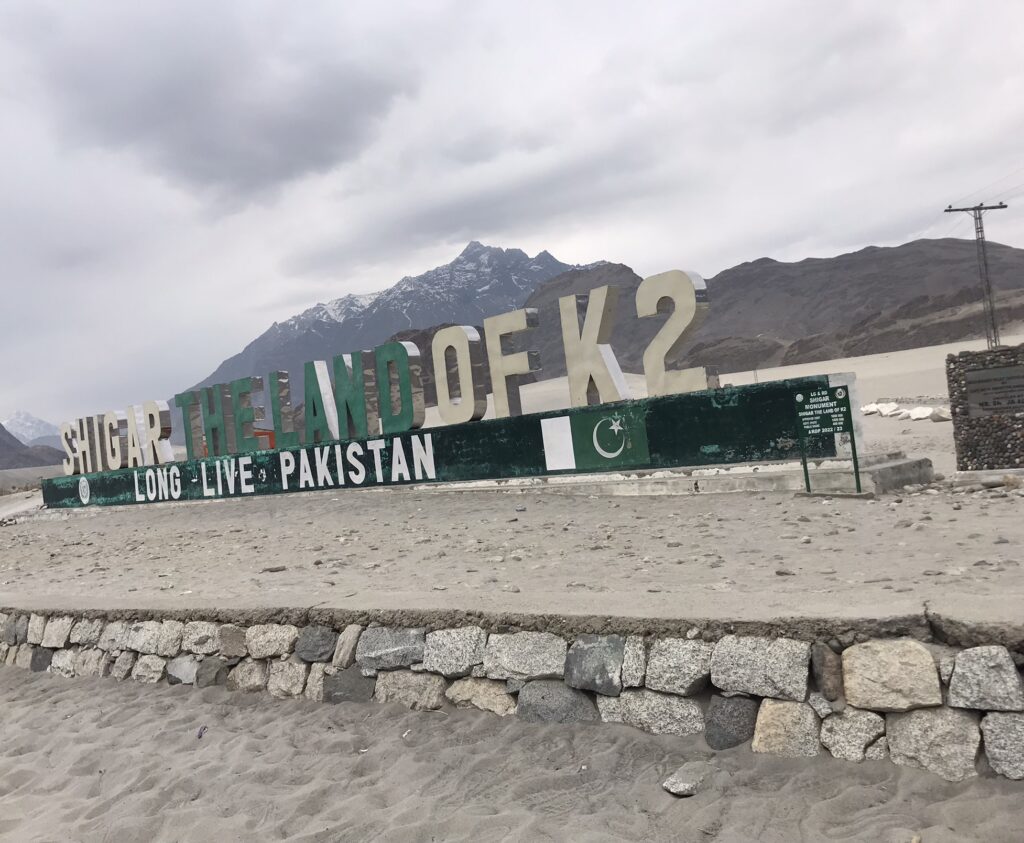
Shigar, near to Skardu, is the home of K2 – but you still won’t be able to see it without completing a multi-day trek
While Skardu city has a few interesting sites that are walkable from the centre, the city itself isn’t really the main attraction. Most of the best sights are dotted around the wider region amidst the surrounding peaks and valleys. If you’re visiting Skardu without a car, the best bet is to ask your guesthouse if they know a reliable driver. Most guesthouses can provide transportation and day trips, usually combining multiple sites into clusters to make it possible to visit multiple attractions in a day. This is what we did; in the end one of the brothers running our guesthouse drove us around and we were able to see pretty much everything that we wanted to see in the region. A few nearby places, such as Deosai National Park and Basho Valley, were not accessible when we visited in early April as they were still snowed under, but there was still easily enough to fill three full days in and around Skardu.
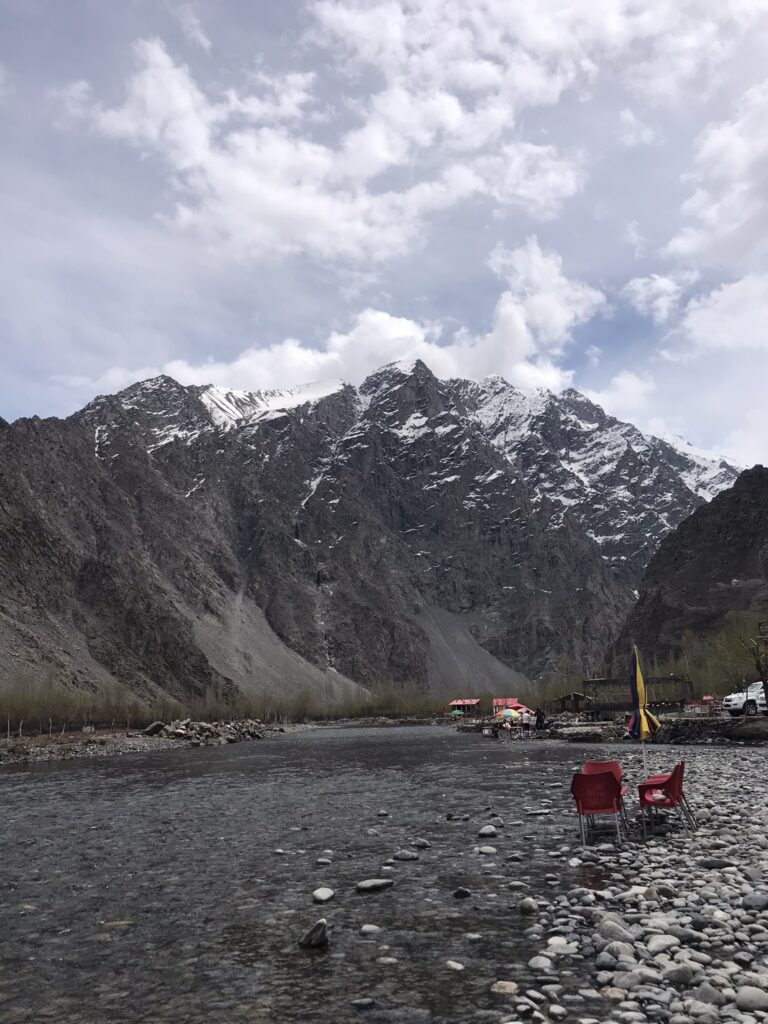
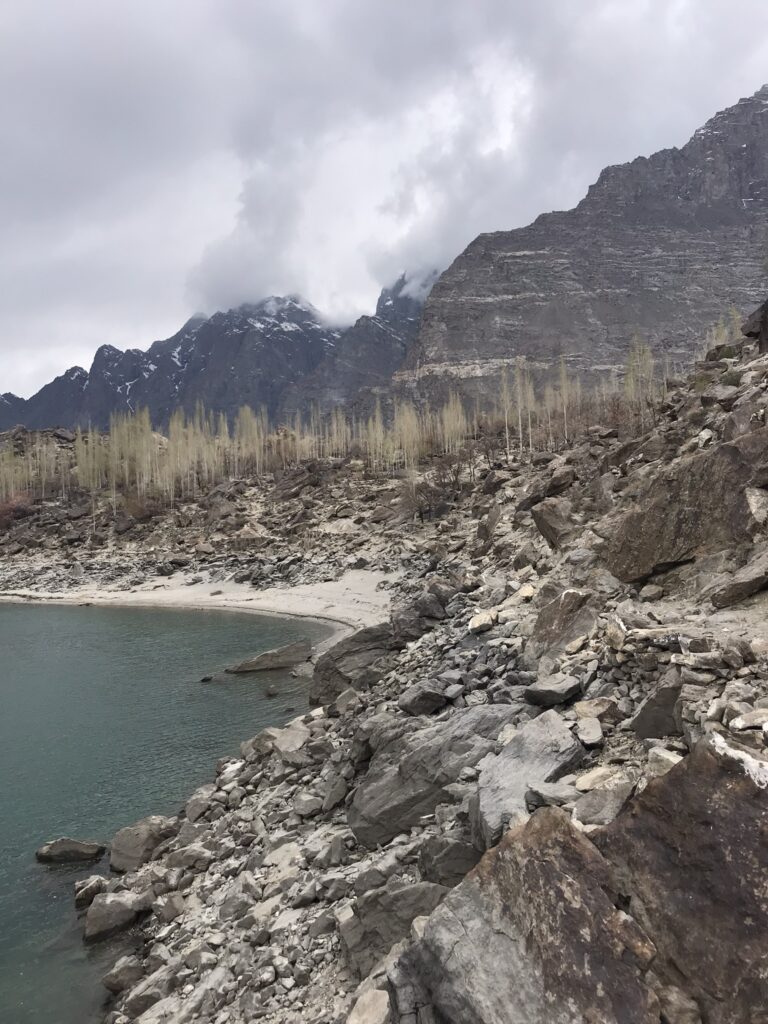
Locations like Sok Valley and Upper Kachura Lake an be visited in the same day
Accommodation
Taaj Residence – an excellent base in Skardu. This guesthouse is run by (at least) three brothers, with the whole property used by guests and a separate house around the back for the family. All the brothers are proficient in English and happy to organise airport transfers, tours or personally guide you around the local sites at incredibly fair prices. The outside garden area is particularly charming with lush green grass, apricot trees bursting with confetti-like blossoms and an outside seating area where you can soak up the sun or enjoy an alfresco breakfast. Outside you can enjoy views of the nearby mountains. Power outages are common in Gilgit-Baltistan but most of the time we were able to access power to charge our phones, decent enough wifi and warm showers here. The family can also provide breakfast and dinner for an additional cost.
Foodie Places
The Grind Cafe – this trendy hipster-style cafe is one of the more cosmopolitan joints in town, serving burgers, sandwiches, milkshakes and some traditional Baltistan cuisine if you are more inclined to try local Balti food.
Apo-G Yak Grill Burger – a random burger joint by the side of the road between Hussainabad and Skardu serving tasty yak burgers. Our host drove us there after we expressed a desire to try yak burgers. It’s safe to say they don’t receive many foreign visitors as we were the first people to review the restaurant on Google. The only other customers were some local Balti guys who were digging into burgers and chain smoking. To this day we don’t know what the special chai included, but it was a really good shout.
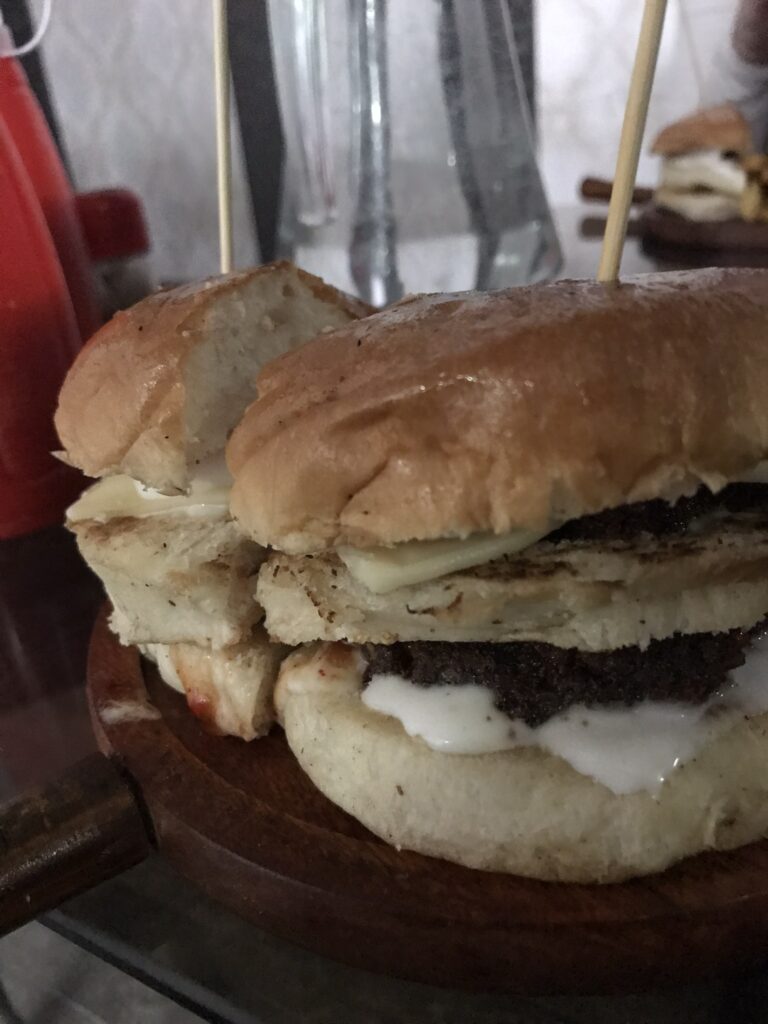
Yak burger at Apo-G – as tasty as it looked
Mountain Cup Cafe – we had quite an odd experience here as the electricity kept cutting out, leaving the entire place in total darkness. Even when the lights were out, the kitchen was still functional. We treated ourselves to alfredo pasta here and it was pretty average, however the wildflower lemonade was a hit with us. The cafe accepts card payments, which is a huge plus for travellers whose reserves of physical cash are running low
Taaj Residence – after a tiresome day of exploring we often opted to eat dinner at our guesthouse. I imagine this is pretty standard for most visitors who don’t have access to a car. The mum of the family made us special Balti dishes to try which was a real treat, although sadly I can’t remember the name of the dish – very apricot oil heavy though. The family offers both Pakistani dishes like karahi and traditional Balti food
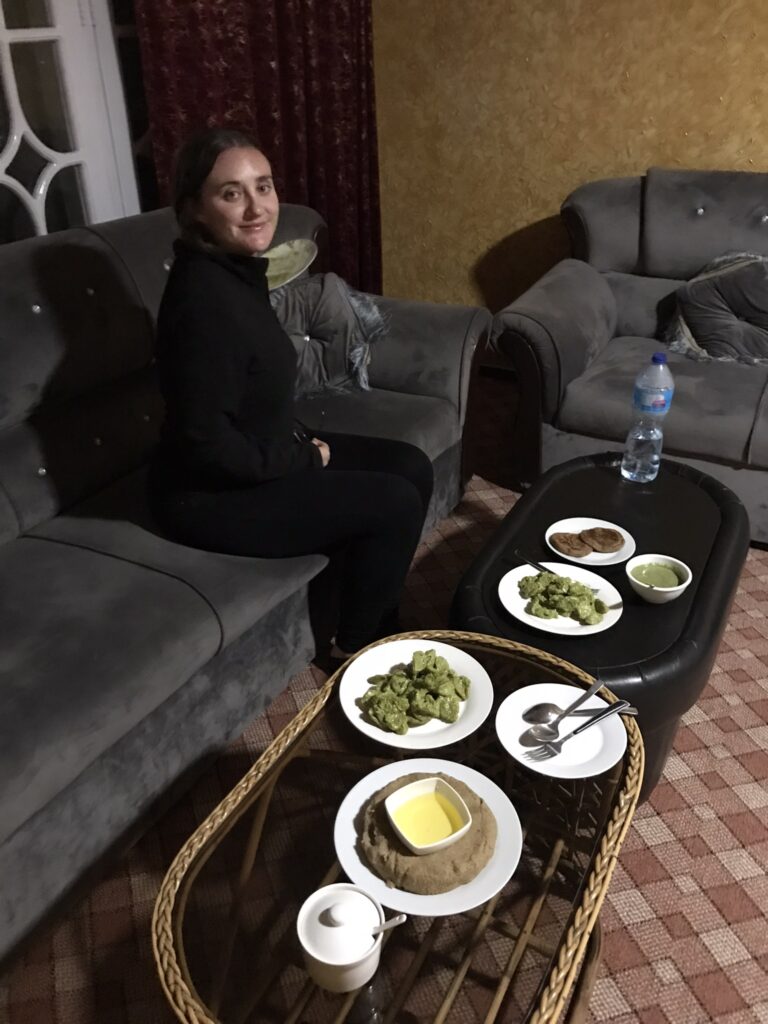
We enjoyed the home-cooked local food in our guesthouse
Activities
As is the case in most of Gilgit-Baltistan, the best places to visit are outside the urban areas. We organised tours through our guesthouse rather than using an outside agency. Within walking distance of Skardu city, the main sites to see are the Buddha Rock and Kharphocho Fort.
Manthal Buddha Rock – a manageable walk from the centre of Skardu, this is a 9th century carving on a large boulder depicting a meditating Buddha surrounded by seated bodhisattvas (Buddhist saints). Don’t miss the carved stupa on the rear of the rock and barely visible inscriptions. Buddhism was the main religion in this region before the arrival of Islam and this is one of the few notable relics from that time. It’s a tiny site and you have to pay an entrance fee, which is a little annoying given that there isn’t really much to see inside – literally just the rock. However it is still worth a visit in my opinion. The location itself is also quite dramatic and there are some lovely mountain views along the route from the city. Walking to the rock is a gentle activity ideal after you first arrive in Skardu, especially if you’re still acclimatising to the altitude/tired from an early-morning flight.
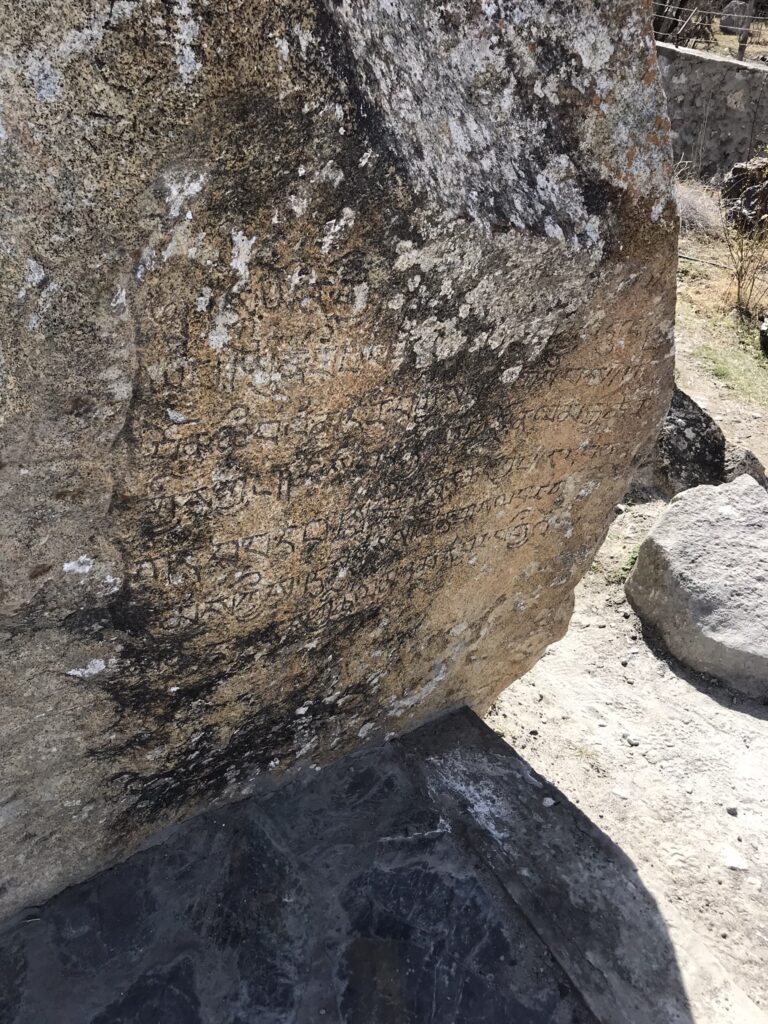
The Buddha rock is not the most spectacular site but it is interesting – behind the rock you can find ancient inscriptions
Kharphocho Fort – first established in the 14th century CE by the local Maqpoon ruler Bokha Khan and then later turned into a nine-story palace-cum-fort by the great conqueror Ali Sher Khan Anchan in the 16th century. This fort sits perched high above the confluence of the Indus and Shigar Rivers, overlooking the city of Skardu. The fort’s claim to fame is that it wasn’t conquered until the invention of modern military weapons and artillery in the 19th century, when the rampaging Sikhs from Jammu sacked the fort and razed it to the ground.
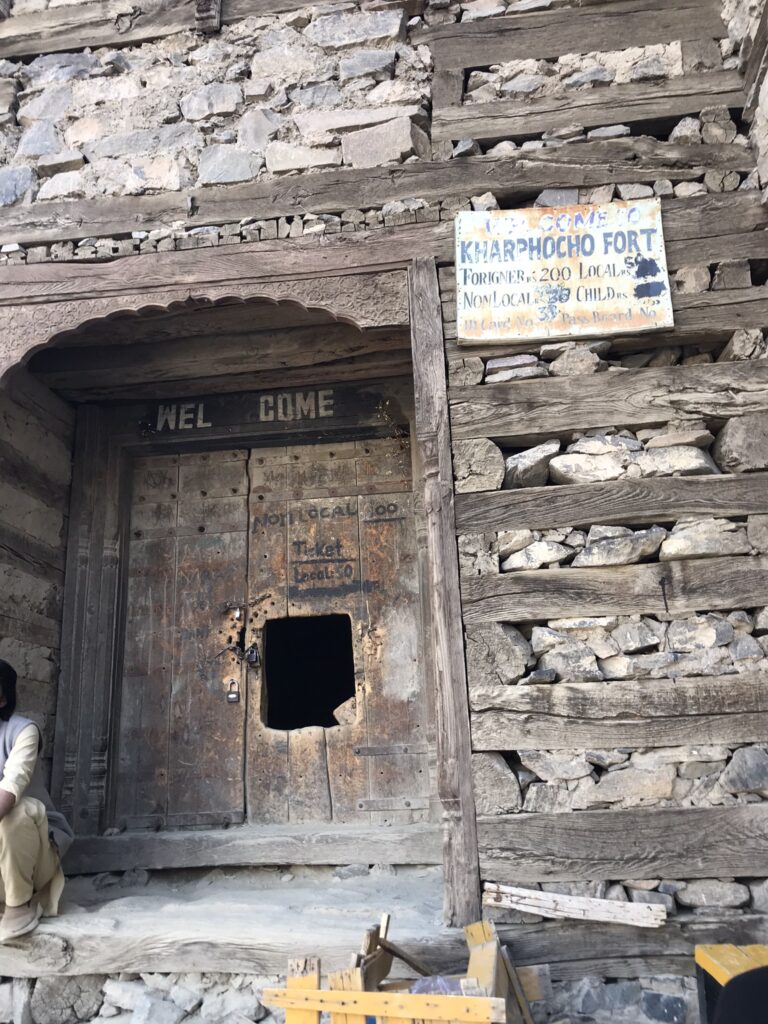

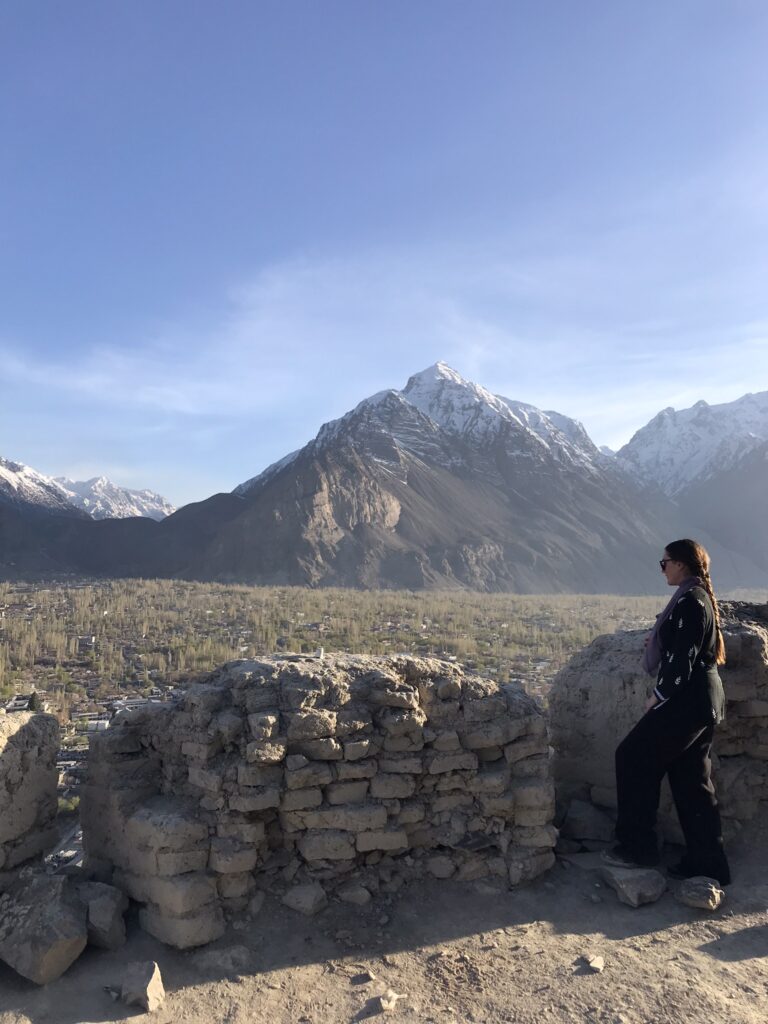
The walk up to Kharphocho Fort is a little gruelling but worth it for the views
Kharphocho is walkable from the city of Skardu but it’s definitely a more challenging hike than the Manthal Buddha Rock due to the steep elevation. I couldn’t find the exact elevation gain from the city, but it’s high. All I can say is that unless you’re an experienced uphill trekker (I for one am not) then expect some puffing and panting and factor in some rest stops along the way to catch your breath. The route up is essentially a zig-zag uphill track with lots of loose rocks. The inside of the fort is unrestored and quite neglected with mostly just rubble and the remnants of destroyed buildings, there isn’t much of historical value left to see. The upside to dragging yourself up there is the amazing panoramic view over the city, nearby cold desert and dramatic mountain peaks encircling Skardu.
When visiting the rest of the attractions in the Skardu area, it’s best to try and group them into clusters to allow you to visit multiple sites more efficiently. The following are day trips that we organised with our guest house, tried and tested by us. It’s possible to cram more into your day especially if you have your own vehicle but we decided to take it easy and have a leisurely morning wake up.
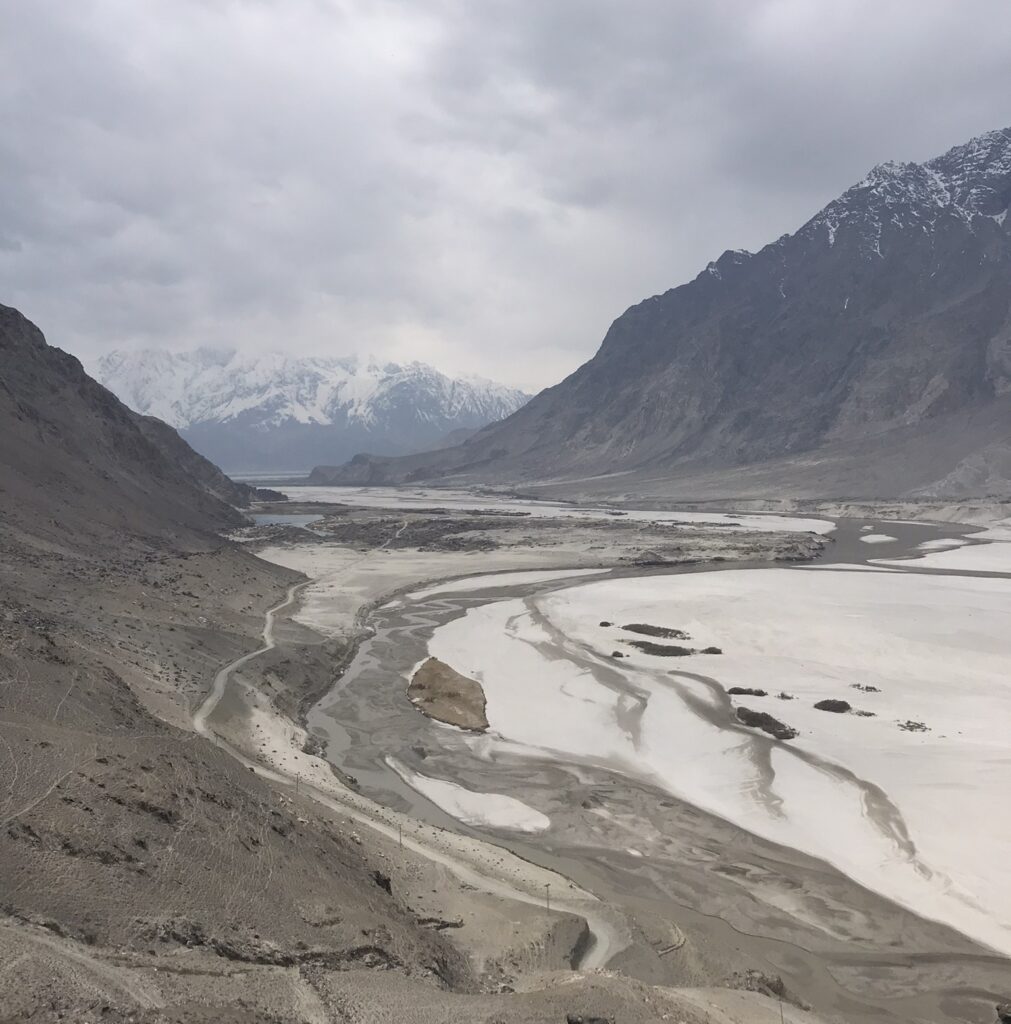
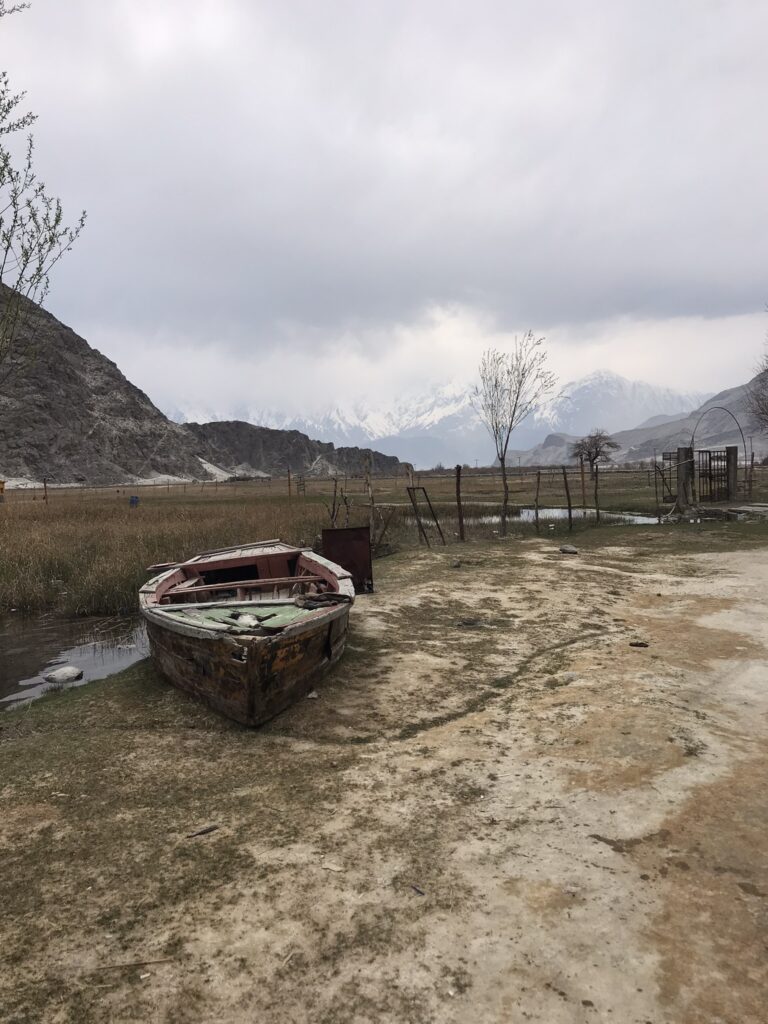
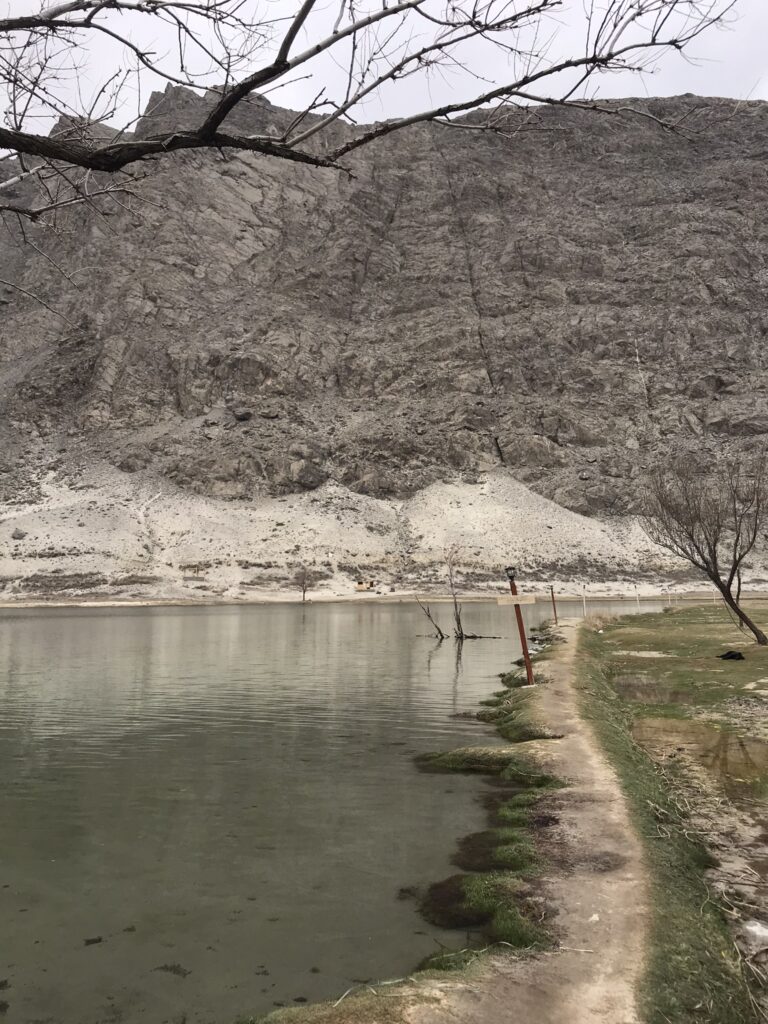
The area east of Skardu contains sites like Shigar Valley and Blind Lake
Day 1: Shigar Fort, Blind Lake and Sarfaranga Cold Desert
Shigar Fort is situated in the village of Shigar, accessed via the beautiful Shigar Valley. This palace used to belong to the royal family of Shigar (the Rajas of Shigar) who donated it to the Aga Khan Foundation for renovation and preservation. The fort has actually been built into the rock on which it stands, and is commonly referred to as Palace or Fort on the Rock.
Part of the fort now houses a heritage museum, the other part is off-limits to the public as it has been remodelled into a luxury hotel. The hotel is managed by Serena, a well-known luxury hotel chain in Pakistan – it’s possible to spend the night as long as you’re willing to pay the steep prices. When visiting the fort and museum you must first buy a ticket, an English-speaking guide will then accompany you and explain the uses of the various rooms and areas alongside some quirky demonstrations of the items on display. We were particularly enthralled by the building technique (earthquake proof layers of rock and wooden struts), and the intricate wood carving inside. Interestingly the Rajas of Shigar still own property nearby.
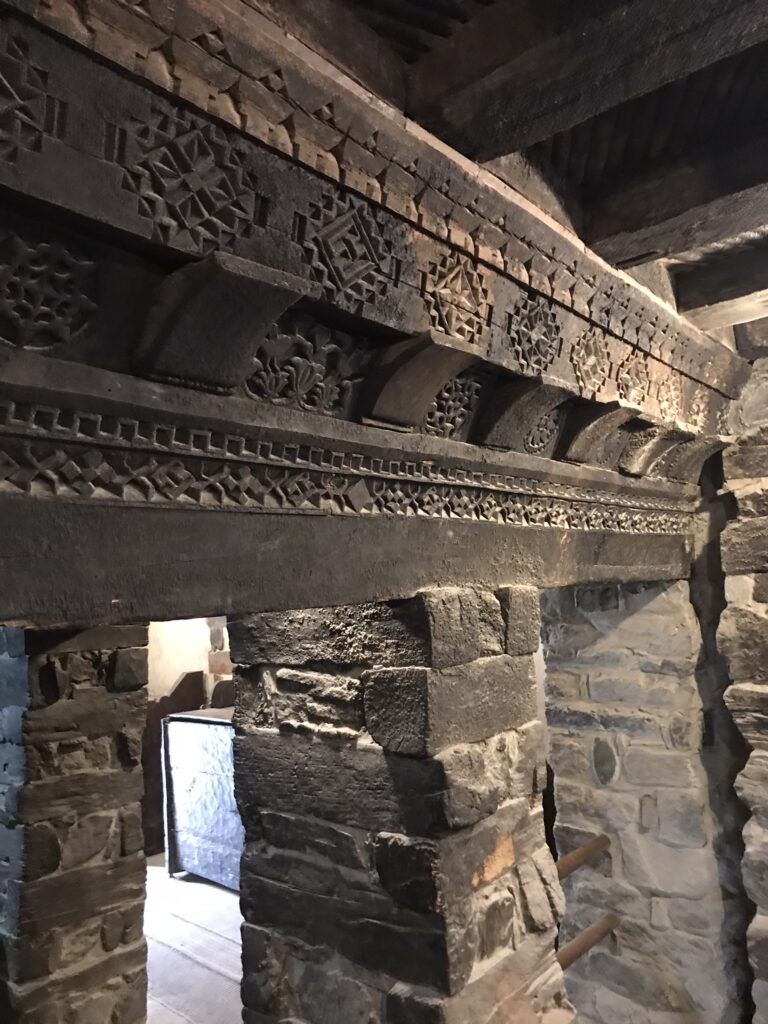
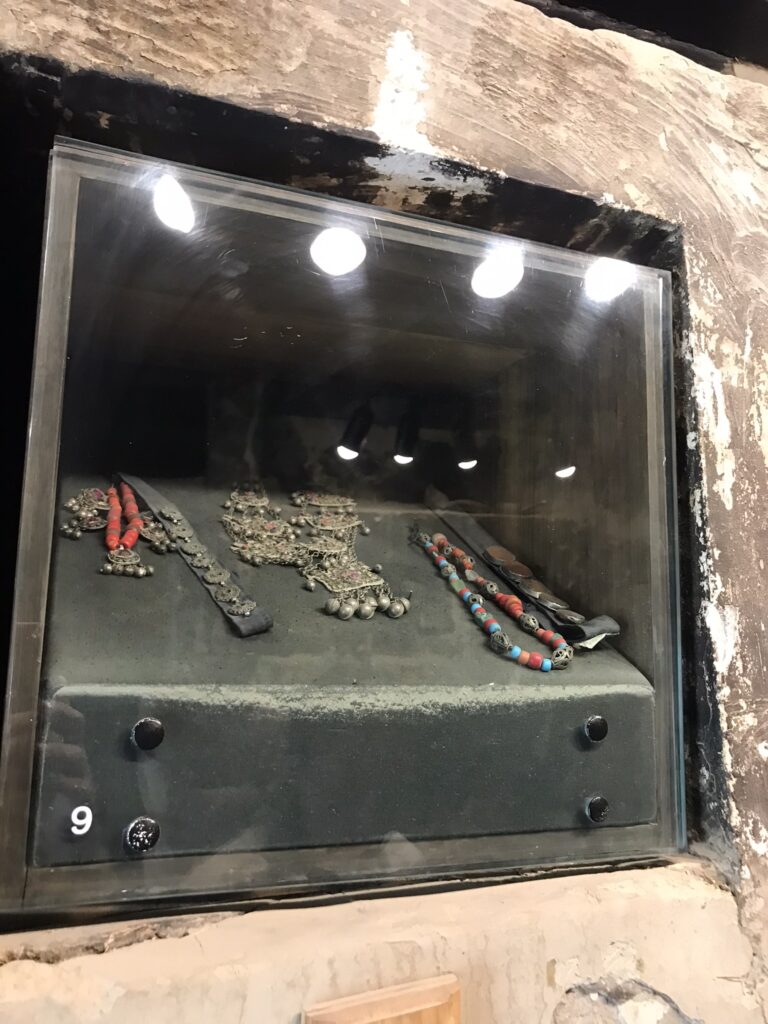

Part of Shigar Fort is open as a small museum, while the other part is now a luxury hotel
Blind Lake – sand storms are common occurrences around Blind Lake. According to our driver, it’s called Blind Lake as no-one knows where the water comes from. You have to pay a small admission fee to enter the waterside area. It’s not the most picturesque lake we’ve ever seen but nevertheless a nice picnic spot, with boats available for hire. Apparently swimming is popular here during the summer months with a separate section for ladies to swim – signs demarcating these areas are dotted around in Urdu. We saw more locals here than tourists, although that probably wouldn’t be the case during the busier summer months. It’s possible to meander around the lake for a short distance if hiring a boat or milling about with the locals isn’t your thing.
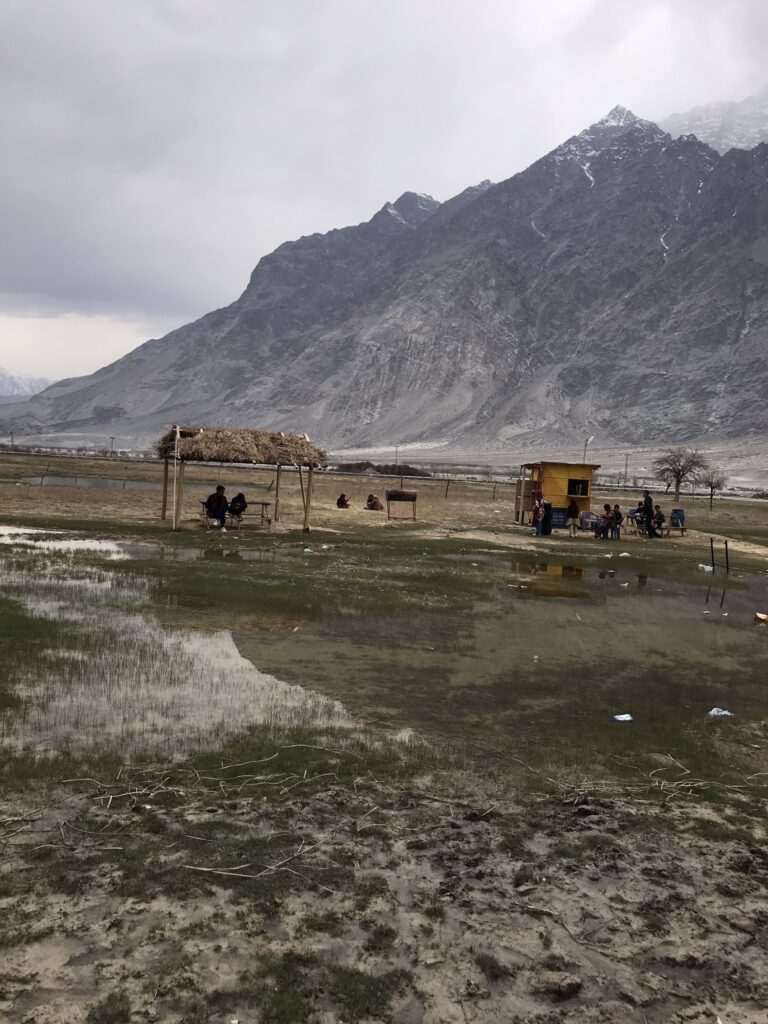
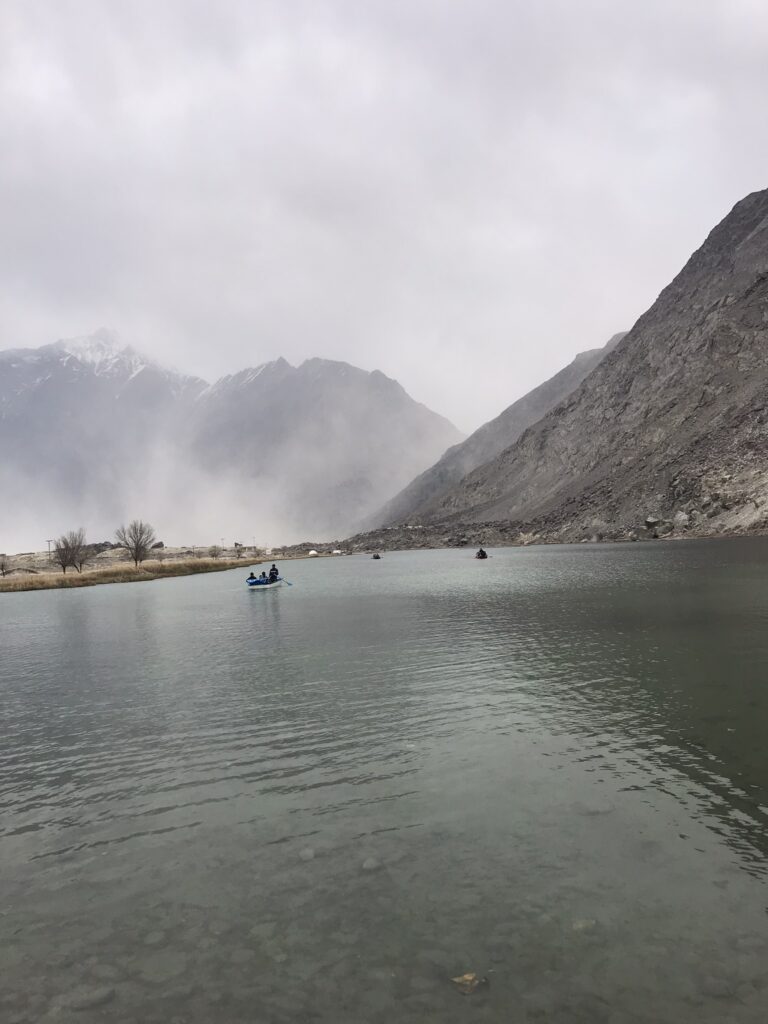
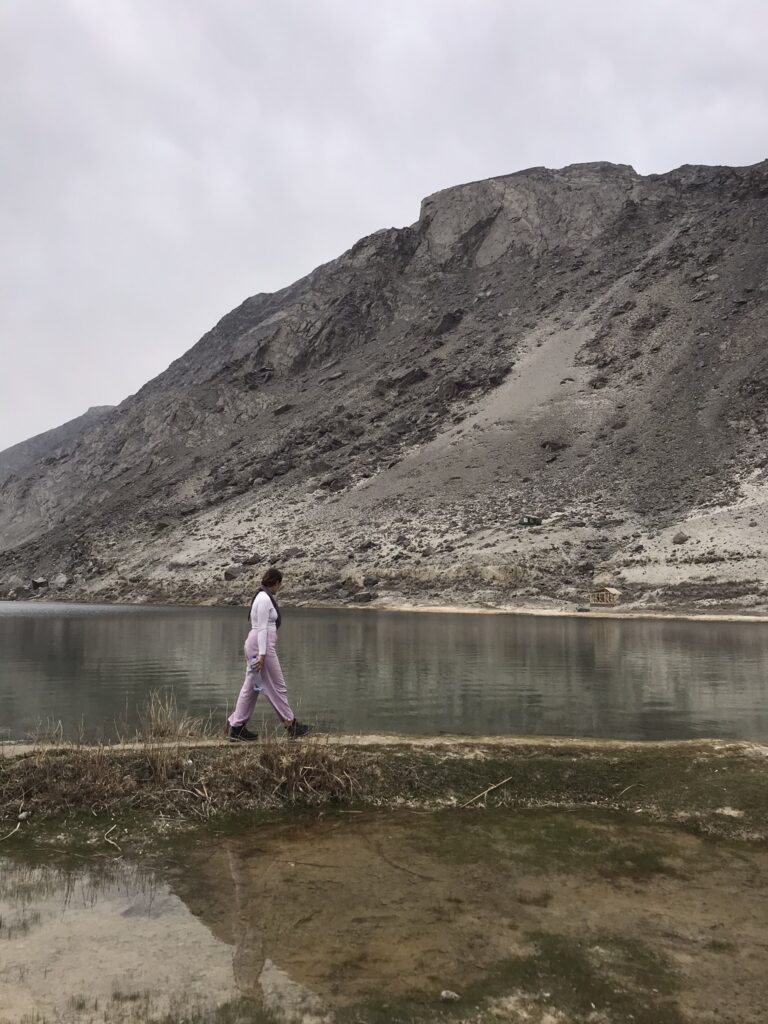
Blind Lake was quiet when we visited but it is a popular spot in the summer months
Safaranga cold desert – a myriad of adventure activities are available here such as jeep tours around the sand dunes, horse-riding, archery and quad biking. The jeep safaris include a driver as tourists are not allowed to drive the jeeps. We managed to wrangle a slightly cheaper deal for a shorter ride as the original price quoted was 12,000 rupees – way out of our budget. The horse-riding was pretty wild – I made the mistake of asking for a fast horse and ended up with a furious polo horse that didn’t respond to any rein jerking when I wanted to stop, long story short I ended up hitting the deck (literally the sandy ground). Learn from my mistake, DO NOT ask for a fast horse. I paid 1000 rupees for a quick lap, which was a pretty good price as far as horse-riding goes. I have to admit that I was quite proud when our host told us that all the local guys milling about were impressed by my riding ability (and diving ability I presume).
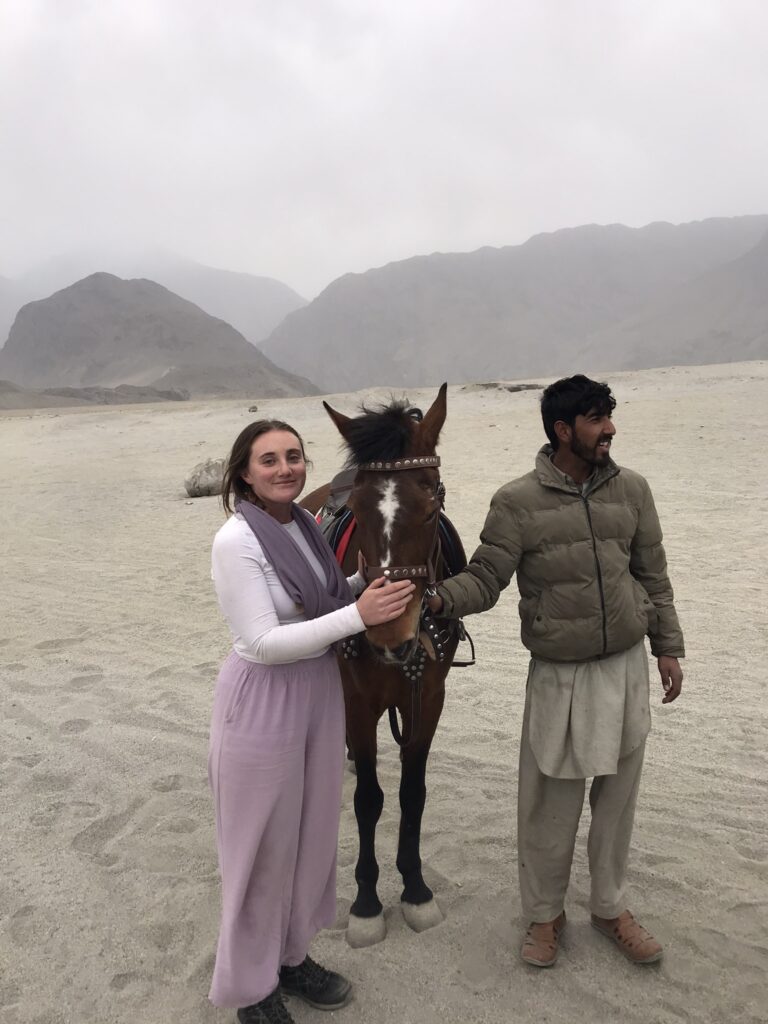
With the crazy horse…
Day 2: Chunda Valley, Sok Valley, Kachura Lake and Shangri-La Lake
Chunda Valley – after a hair-raising journey on a stony mountain track, we arrived in Chunda Valley. It’s a bumpy ride up the mountainside and there are no barriers between the edge of the road and precipice. I don’t advise anybody who is nervous or squeamish to look over the edge. There’s no need to hire a 4×4 as a regular car, if driven carefully by a knowledgeable local, can make the journey – although I wouldn’t recommend trying to drive up there yourself. A few locals tried to stop our driver to tell him that his car wouldn’t make it to the top, but he assured us that he had been up dozens of times in the car and even showed us pictures to prove it. True to his word, the car was fine.
Chunda is a serene bucolic area with small villages spread out along the valley. Most visitors head straight for the viewpoint here – it’s best not to drive the last stretch to the viewpoint if you don’t have a 4×4 vehicle as it’s very steep and rocky. The viewpoint offers stunning views over Chunda Valley and the looming mountains. We wish we could’ve spent more time to walk around the village of Chunda and interact with the locals, however we were whisked away to our next stop.
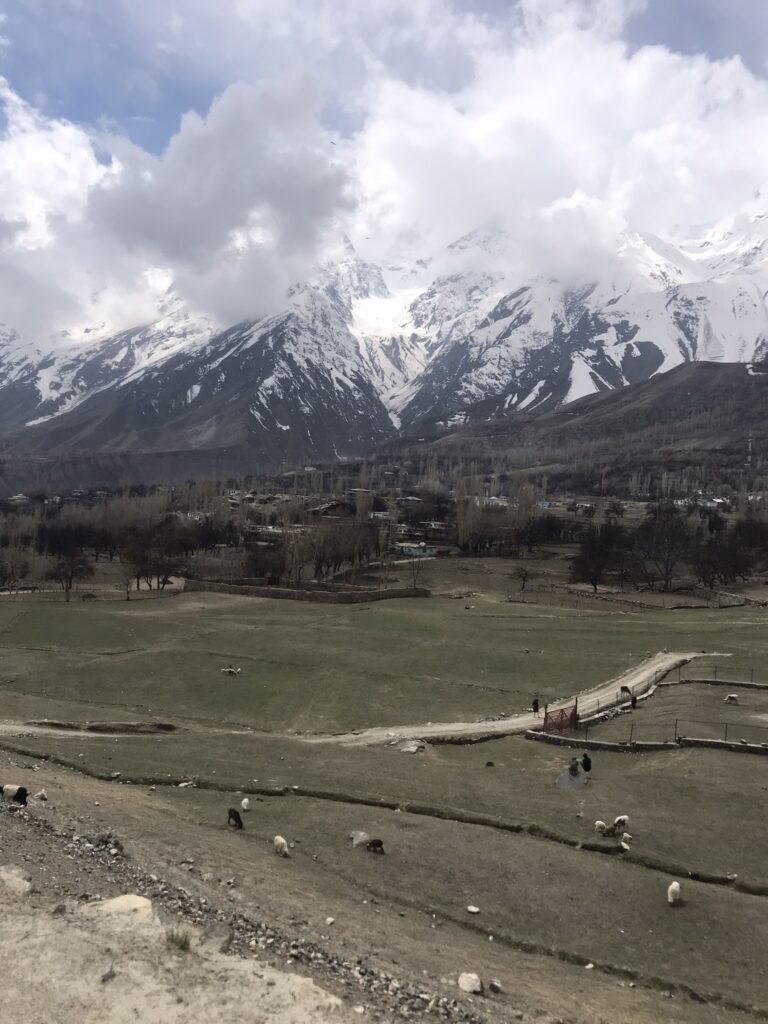
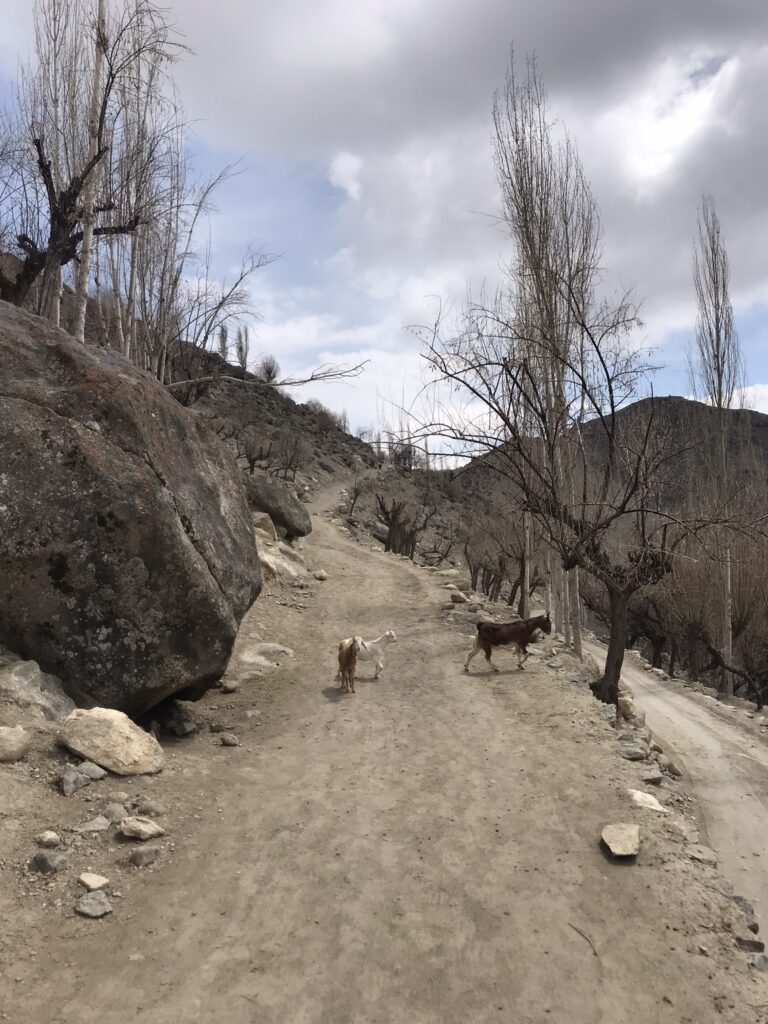
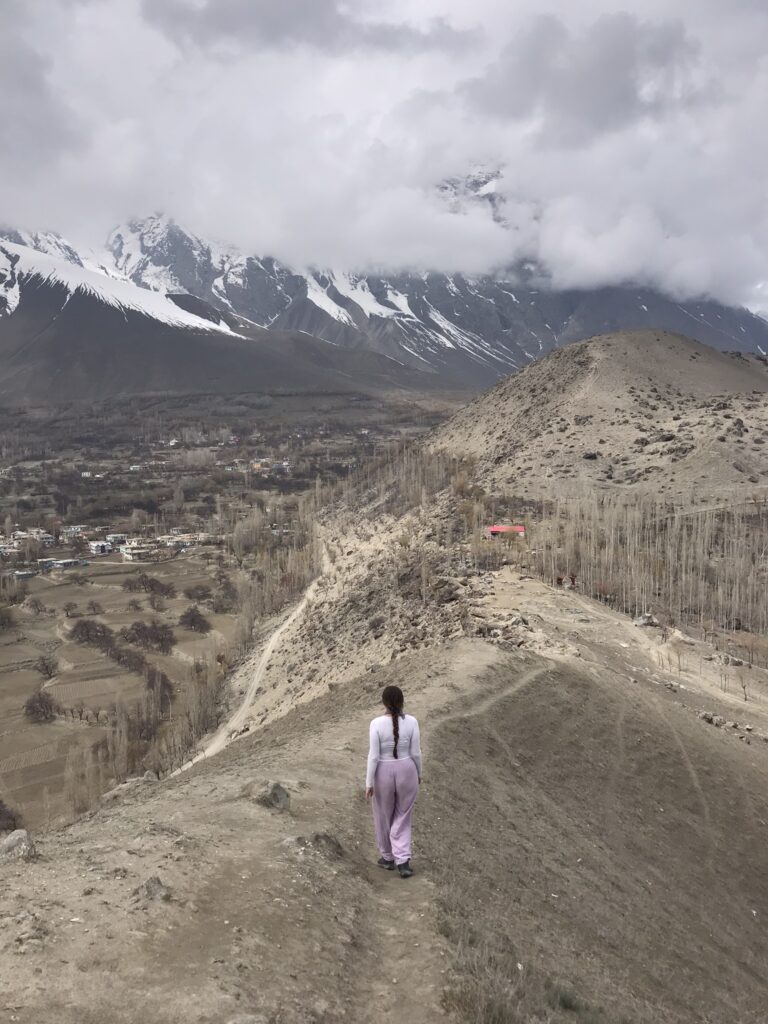
Chunda Valley is filled with mesmerizing landscapes
Sok valley – a tranquil spot for some chai or lunch. You can enjoy the view with your feet almost in the river. Riverfront establishments place tables and chairs on the river bed so visitors can soak up the calm atmosphere.
Upper Kachura Lake – an area which is almost like a mini amusement park, mainly catering to domestic tourists. Zip-lining, speedboats and jet-skis are available for visitors to enjoy. It’s safe to say you can end up spending a lot of money on all the activities if you’re not careful – the workers here are crafty and experienced salesmen. If you’re on a tight budget like us you can simply opt to follow a trail around the edge of the lake for free – just head towards the big zipline and catch the trail from there. We were the only ones on the trail so it was pretty peaceful, with great views over the lake. There are a couple of nearby restaurants serving barbequed fare – grilled fish is an especially popular choice.
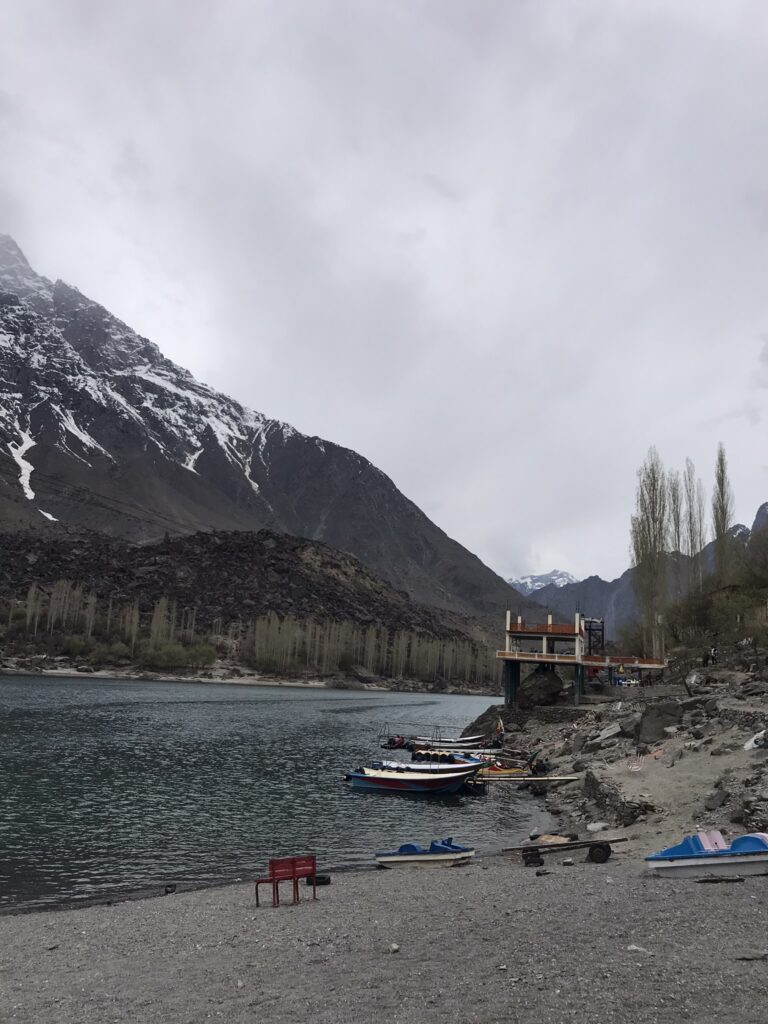
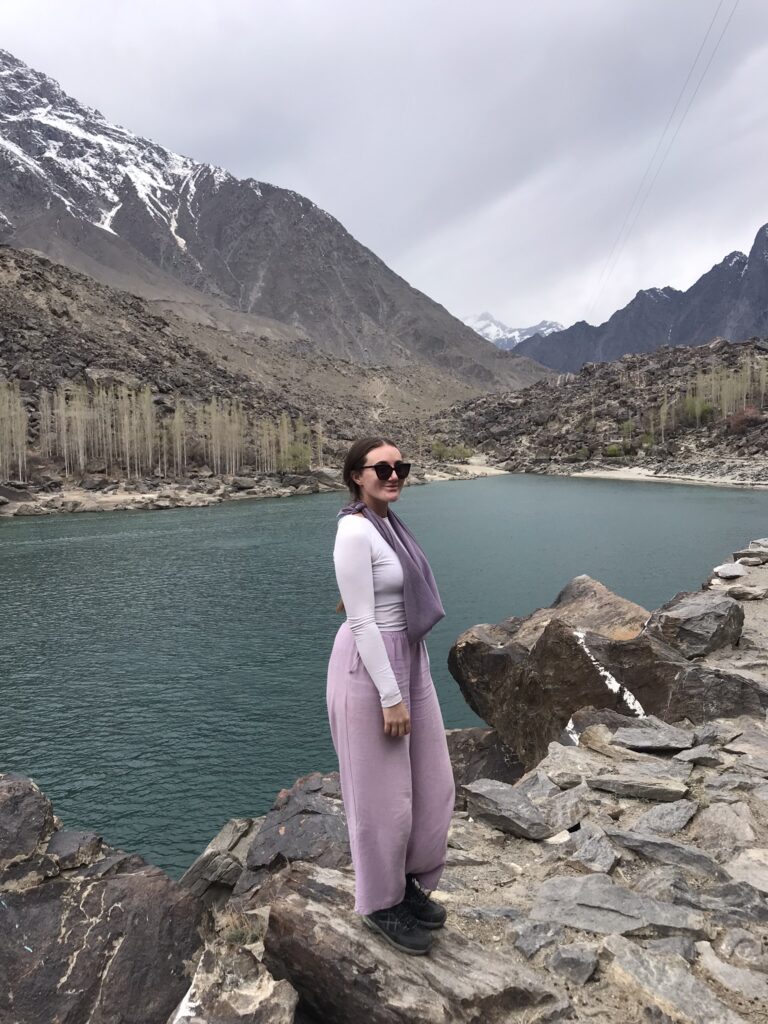
Upper Kachura lake has adventure activities and a nice walking trail
Lower Kachura Lake – most commonly referred to as Shangri-La after the pricey resort situated on its banks. You have to pay an admission fee to enter the Shangri-La grounds – within the resort you can hike up to a viewpoint for a bird’s-eye view over the lake and cold desert (takes about 20 minutes) and visit the two resident ibex, who may or may not be fighting. The resort also contains a gimmicky aeroplane cafe and cutesy Tibetan-style waterfront cafe. It’s a shame to say that we thought the place was a money-making scheme that wasn’t really worth the entry fee for nature enthusiasts. It’s more of a gimmicky, touristy place – fine if you’re into that kind of thing.
The above four sites are all to the west of Skardu city and can easily be visited in a single day. We also wanted to visit Basho Valley which is a little further out but, aside from the possibility of snow, we were also advised that this would require paying additional money for a 4×4 jeep. Apparently local jeep drivers have a monopoly over the transport to the valley. We drove through the Basho region on the way from Gilgit to Skardu and it did look very picturesque and idyllic.
Gilgit
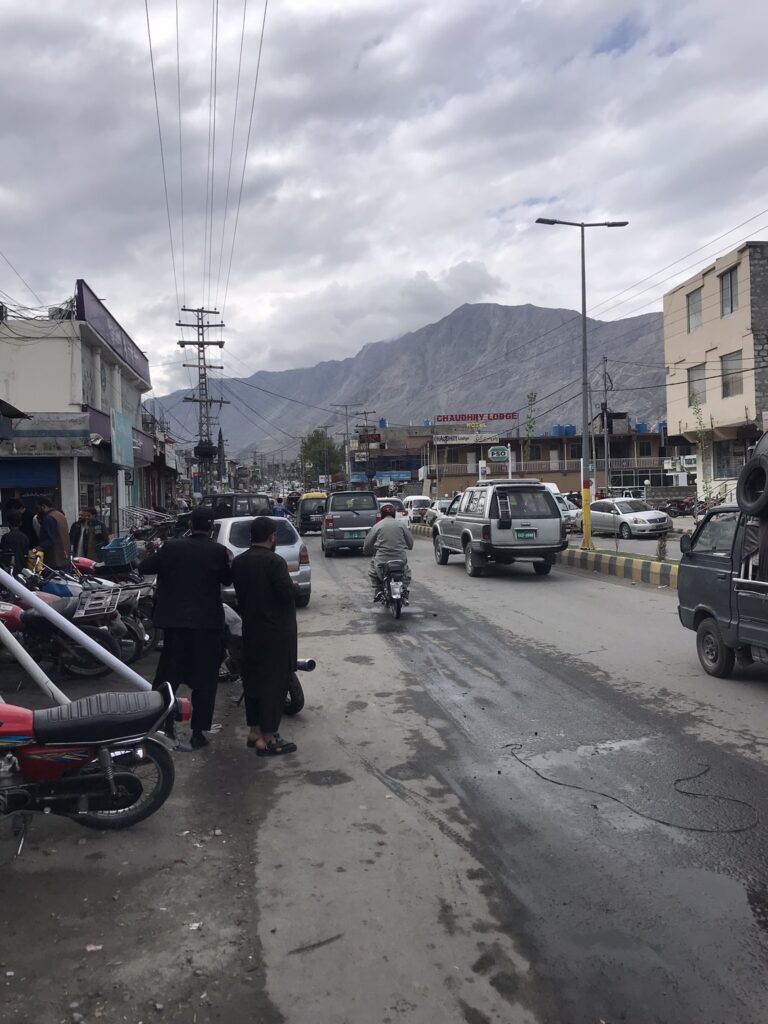
Gilgit is the regional capital, containing the government and administrative buildings of Gilgit-Baltistan. A functional city located along the Karakoram Highway, for travelers it mainly just serves as a transit hub between Skardu and Hunza or for those traveling to Fairy Meadows. Whilst there are some nice cafes and comfortable guesthouses in Gilgit city, there isn’t much in the way of attractions, be they natural, cultural or historical. The setting itself is quite picturesque and typical of the region, bisected by a river and surrounded by mountains. It is a good place to rest for a night and stock up on cash if needed – Alfalah bank in the city has an ATM which accepts most foreign cards.
Gilgit Airport has a notoriously poor record for cancelled flights, so much so that Shakeel, owner of Bucolic guesthouse near Passu, joked that even when the weather is clear, sometimes the pilot just makes an excuse as he doesn’t feel like flying and is paid either way! We noticed that the road signs around Giglit are in Chinese, Cyrillic and Latin scripts so that the truckers of different nationalities can understand them while passing along the Karakoram Highway.
In Gilgit there is a roughly 50:50 split between Sunni and Shia Muslims. A religious leader was killed in Gilgit several years ago which sparked some religious clashes in the city, but we were told that there are no problems now.
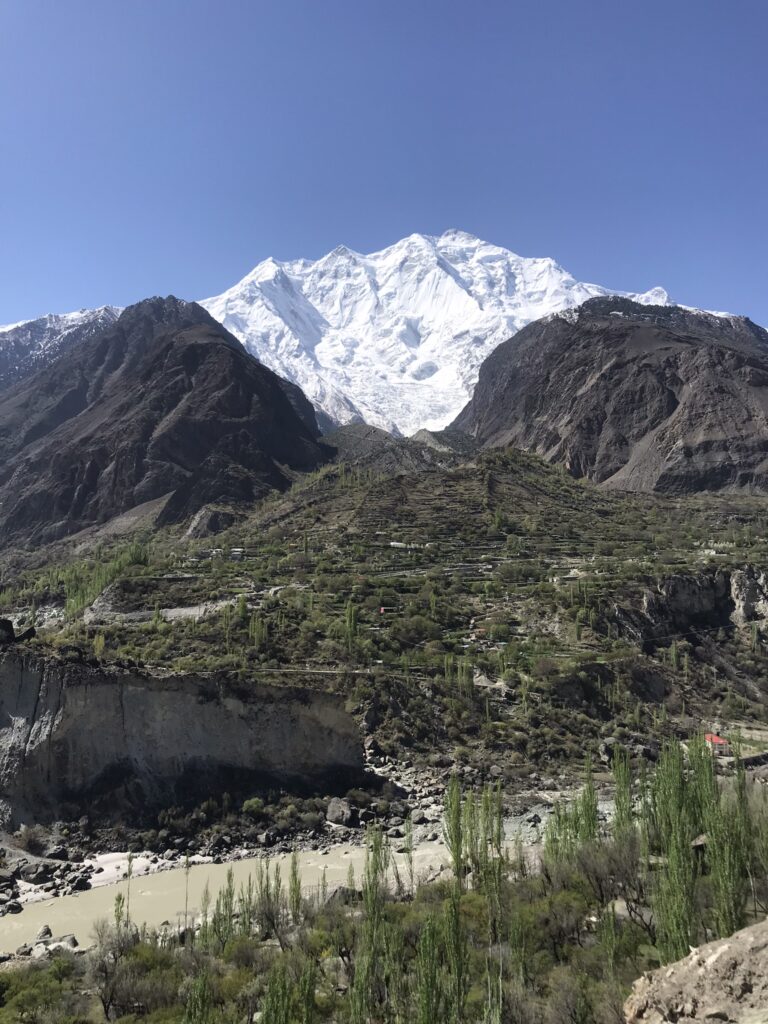
The small town of Minapin, with its fantastic views of Rakaposhi (the world’s 27th tallest mountain), is around 90 minutes drive from Gilgit along the Karakoram Highway
Accommodation
Oak Residency – located within a 20 minute uphill walk of the bus station, this guesthouse was a great place to rest up before heading on to the Hunza region. It was nice and quiet with tea, coffee and filter water available throughout the day and night free of charge. Dinner was also offered at the guesthouse. Overall, a very pleasant stay.
Foodie Places
The CherryTree Café – an adorable cafe positioned just off the main road in the centre of Gilgit. The walls were covered with upbeat quotes, drawings of dogs and creative works of art. A quirky and inviting place for locals and tourists alike with dapper waiters serving sweet treats, savoury meals and an array of typical cafe drinks such as coffee, chai and milkshakes. We saw two serious-looking local guys tucking into dainty milkshakes.
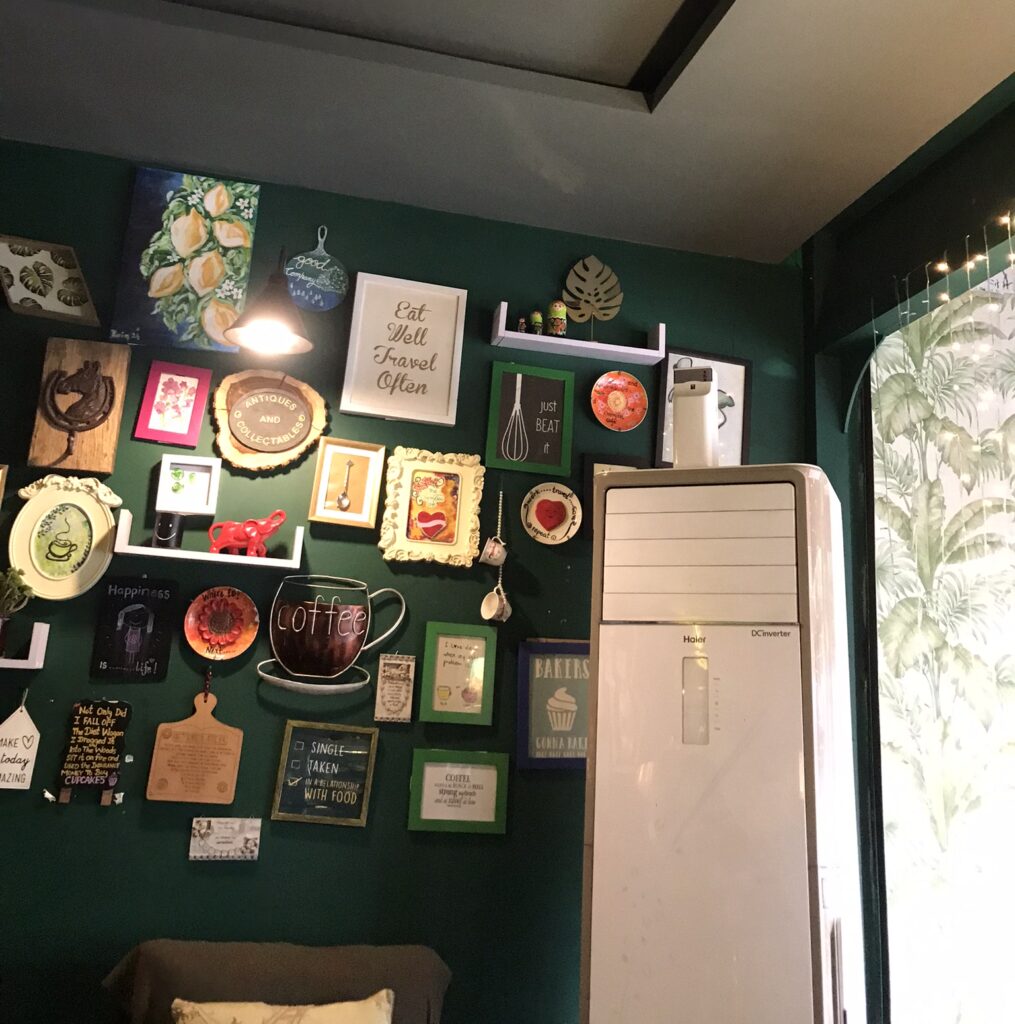
Kitschy decor in CherryTree Cafe
Activities
Unfortunately there isn’t a whole lot to see in the city itself – you can have a peek at the Gilgit-Baltistan Assembly from the outside if you’re interested in government buildings like us. Our host at Oak Residency recommended walking to the river as a pleasant way to spend the afternoon – we decided to rest up instead.
Hunza (Karimabad)
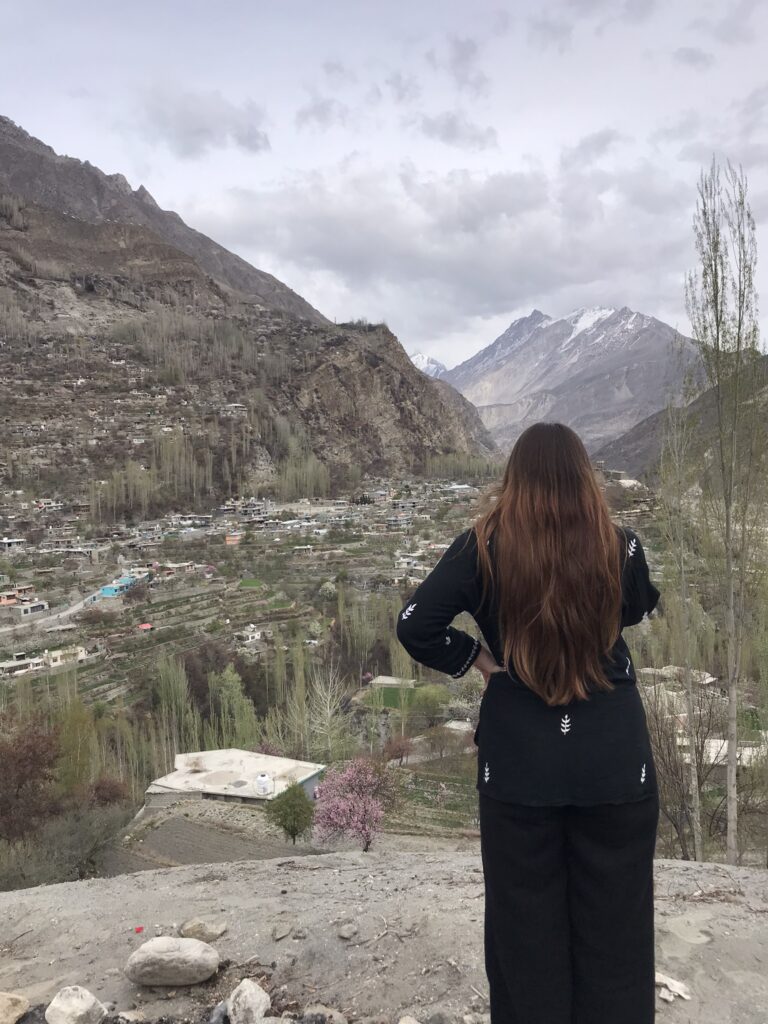
Karimabad is the capital of the Hunza region within the state of Gilgit-Baltistan, and one of a number of interlinked villages along the steep sloping northern side of the Hunza Valley. The Hunza Valley is very popular with domestic and foreign tourists alike. It’s known for its high literacy rate, predominantly Ismaili Shia community, unique culture and soaring views across the enormous valley. Karimabad is in the vicinity of the towering snow-capped peaks of Rakaposhi (27th tallest in the world), Golden Peak and Ultar, all of which are visible from the town.
Karimabad, formerly known as Baltit, is home to the Burusho people and was once the seat of the kings of the Hunza region (known as the Mirs of Hunza), who historically ruled from Baltit Fort. The town’s name was changed from Baltit to Karimabad in the 20th century in honour of the 4th Aga Khan. Baltit Fort remains a major landmark, dominating the town from above. The area around the fort consists of very steep, narrow streets with cobblestone paving and buildings neatly stacked into the hillside. It can be quite atmospheric when you aren’t puffing and panting to catch your breath due to the steep uphill walk. Karimabad is a popular tourist spot and there are plenty of restaurants, cafes and tourist shops in the town – we heard from locals that the town can get uncomfortably crowded with domestic tourists in the busy summer months, although when we visited in April it was fairly quiet. It’s important to note that there are no ATMs in Karimabad itself, although Alfalah bank worked for us in Aliabad. Make sure you bring enough cash to last you for your entire stay and a buffer for any unexpected expenses – we almost ran out.

The winding streets of Karimabad near Baltit Fort
Another important settlement, Altit, is located a few miles from Karimabad. Altit is best known for Altit Fort, which towers over the modest settlement. We were told that ‘Baltit’ means high and ‘Altit’ means low in the local language, although I’m not sure how true that is or whether it has developed that way because of the respective forts. It’s possible to walk from Karimabad to Altit and back along the Sultan Abad road – we did this multiple times in the end, just take the path near Cafe de Hunza in Karimabad.
Altit is much less touristy than Karimabad and felt like much more of an authentic local place – on a Friday evening we saw dozens of locals gathered to socialise in the polo ground, complete with traditional drumming and dancing. High on the mountainside above Altit is another settlement, Duikar, which is also known as the Eagle’s Nest. It was amazing to see people living so high up, with houses and settlements all the way along the track up the side of the mountain.
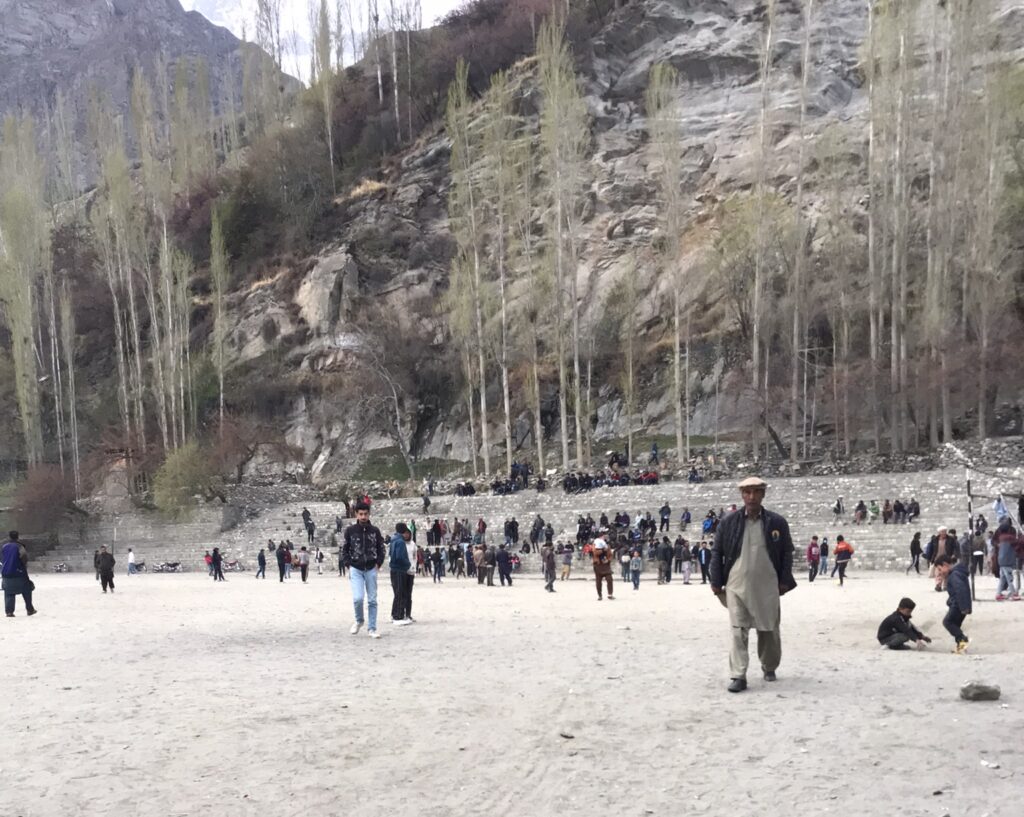
Friday evening festivities in Altit
On the other side of Karimabad, Aliabad is the larger, more modern settlement in the Hunza region and also the location of the main bus stand in the area. If you’re getting the bus from Gilgit with the aim of heading to Karimabad then make sure to either tell the driver that you want to head to Karimabad or have onward transport planned, as it isn’t walkable. We sadly found this out the hard way when our bus unexpectedly terminated in Aliabad. We had to flag down a local taxi to make it the rest of the way to Karimabad – thankfully we were only charged a pittance.
At the bottom of the hill from Karimabad, Ganish is the original walled settlement in the Hunza Valley, located along the former Silk Road caravan route. The village is over 1000 years old and has won the UNESCO Asia Pacific Heritage Award – it has been preserved as a cultural monument to the old way of life in the Hunza Valley. There is still a community of mainly seasonal workers living within the fortified village of Ganish, although most of the original villagers now live in Karimabad or Altit.
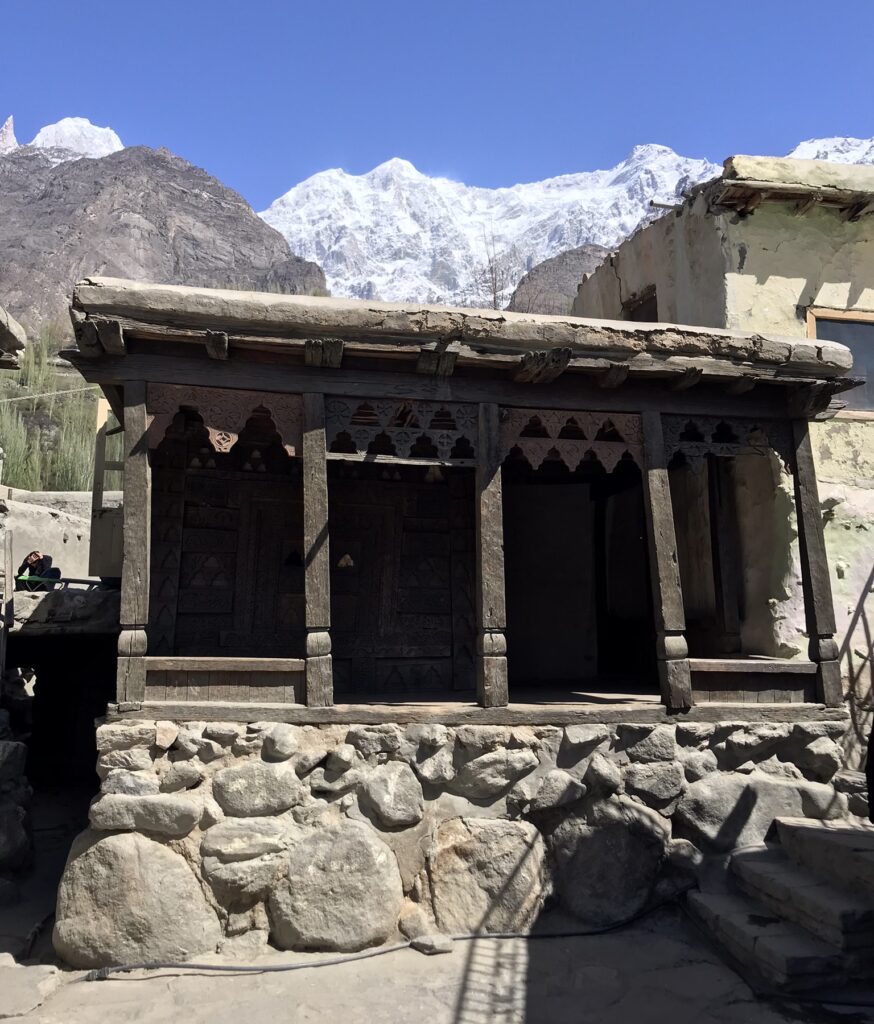
Ganish village is known for its intricately-carved wooden mosques
It’s interesting to note that Ismaili Shia Muslims form almost 100% of the community in Karimabad, unlike other parts of Pakistan. The Ismaili are reputed to be more liberal and progressive. In the Hunza region you’ll spot many women walking around with their hair uncovered, a sharp contrast with the rest of Pakistan.
‘Welcome Imam Hazir’ read the eye-catching signs painted on the side of the mountains throughout the area. This is the heartland of the Aga Khan, spiritual leader of the Ismaili Shia Muslims. You can find numerous healthcare and education centers in the region with placards stating that they are funded by the Aga Khan Foundation. From what we observed, the Aga Khan Foundation is a force for good in the region, promoting education and expanding access to improved healthcare and infrastructure. It wasn’t just in Ismaili areas that we spotted Aga Khan Foundation initiatives, but throughout the Gilgit-Baltistan region and even in other parts of Pakistan. In Lahore, we saw that the Aga Khan Foundation was responsible for some of the renovations of Lahore Fort, a UNESCO World Heritage site.
Hunza has a unique culture, with many folk superstitions which are still very much alive in the region. According to the Burusho people, if you hear a magpie singing you will soon receive good news. Locals also say that it’s bad luck to travel on a Tuesday or a Friday. Hunza is also home to some very interesting local cuisine. Yak meat is all the rage here! Although you are unlikely to spot any living yak as they tend to graze at high altitudes in the mountains and only come down to lower pastures in the freezing winters. Apricot juice is also everywhere in the region and is a must-try. We couldn’t get enough of it.
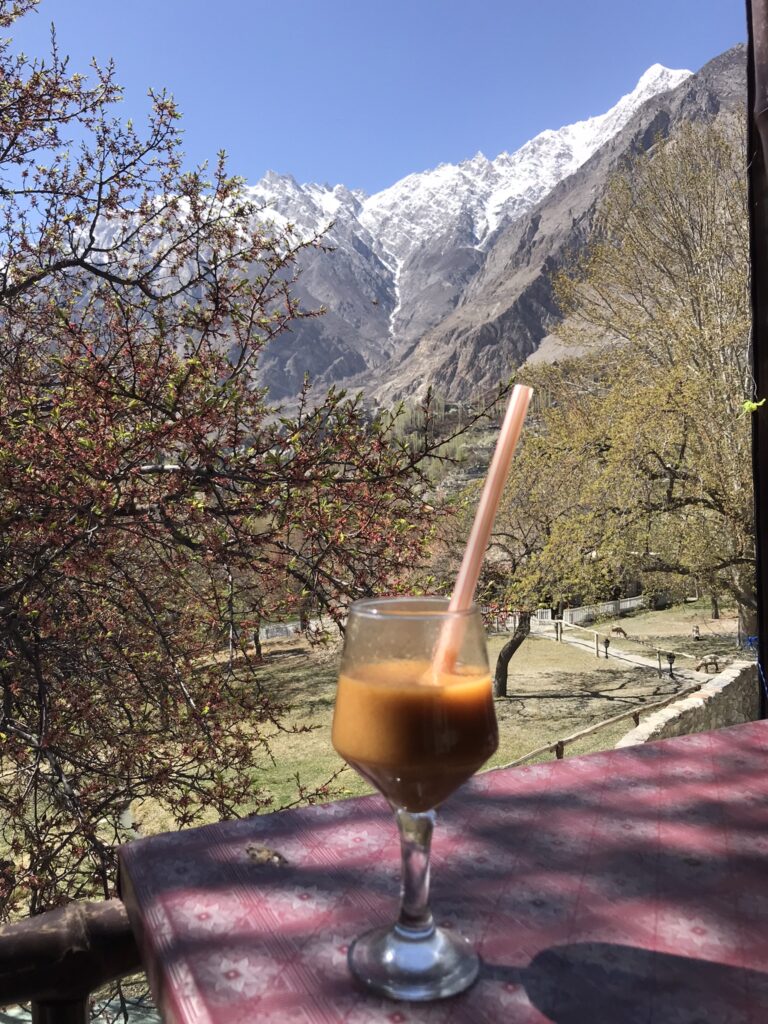
Nothing beats a refreshing glass of Hunza apricot juice
Paragliding is a popular activity during the warmer summer months around Karimabad. We even spotted a lone paraglider in April. Some tourists visit with the sole aim of gliding around the mountains surrounding Karimabad. We were told that the creator of the famous Japanese anime Nausicaä of the Valley of the Wind (Studio Ghibli) was inspired by the Hunza Valley around Karimabad.
Karimabad is also a gateway to the northeastern parts of the Karakoram Highway, with its many wonders such as the Passu Cones, and on to China. You can see Chinese mining operations in action just outside of Karimabad, as heavy machinery carves out huge slices of white marble from the mountainside. It’s possible to explore the wider Hunza Valley and the northern parts of the Karakoram Highway using Karimabad as a base. Our host in Karimabad, Noushad, drove us around the whole region over a couple of days for a pretty good price.

Karimabad makes a great base to visit nearby sites like Hopper Glacier
Accommodation
Hunza Lounge – a clean and modern property, we had a room with a balcony offering great views of Golden Peak and Rakaposhi on a clear day. Wifi and warm showers can be a bit patchy which is the same everywhere in the region, other than that the rooms were very comfortable and well-maintained. What set this place apart though was the staff. Very friendly, enthusiastic team of local guys who even invited us to join them for dinner. Noushad, the owner, was such an informative, open and socially aware guide – having him as a local contact was worth the weight in gold. Noushad personally drove us around and tailored our day according to what we wanted to see in the area and our budget, using his local knowledge about where was best to visit at that time of year. By the end of our stay he’d become a friend and companion.
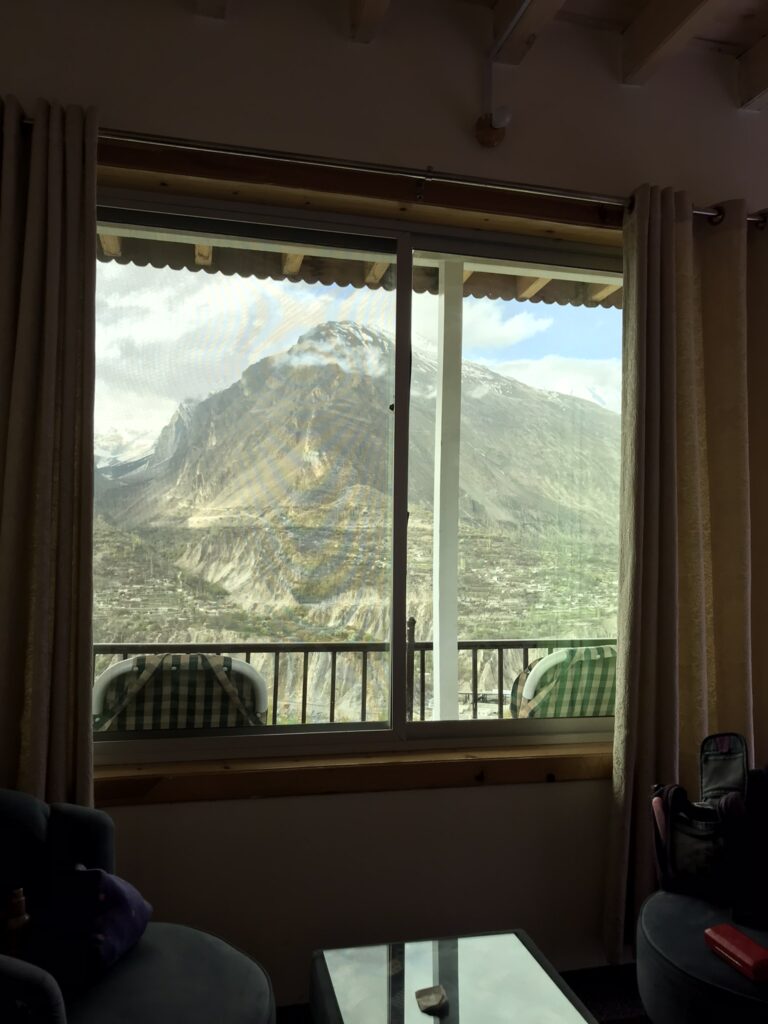
The view from our room at Hunza Lounge
Foodie Places
Café De Hunza – by far the most popular cafe in Karimabad – just check the number of reviews on Google. It’s well worth a visit to indulge in their fantastically cheesy toasties, the perfect snack at any time of the day. The other draws are that they have card machines for payment and stable wifi connection for all those digital nomads and social media junkies. The cafe itself is a self-service type place with payment after you receive your food. Make sure you pay attention as they call out your order once it’s ready for collection. There’s also an upstairs seating area if the downstairs area becomes too busy with customers.
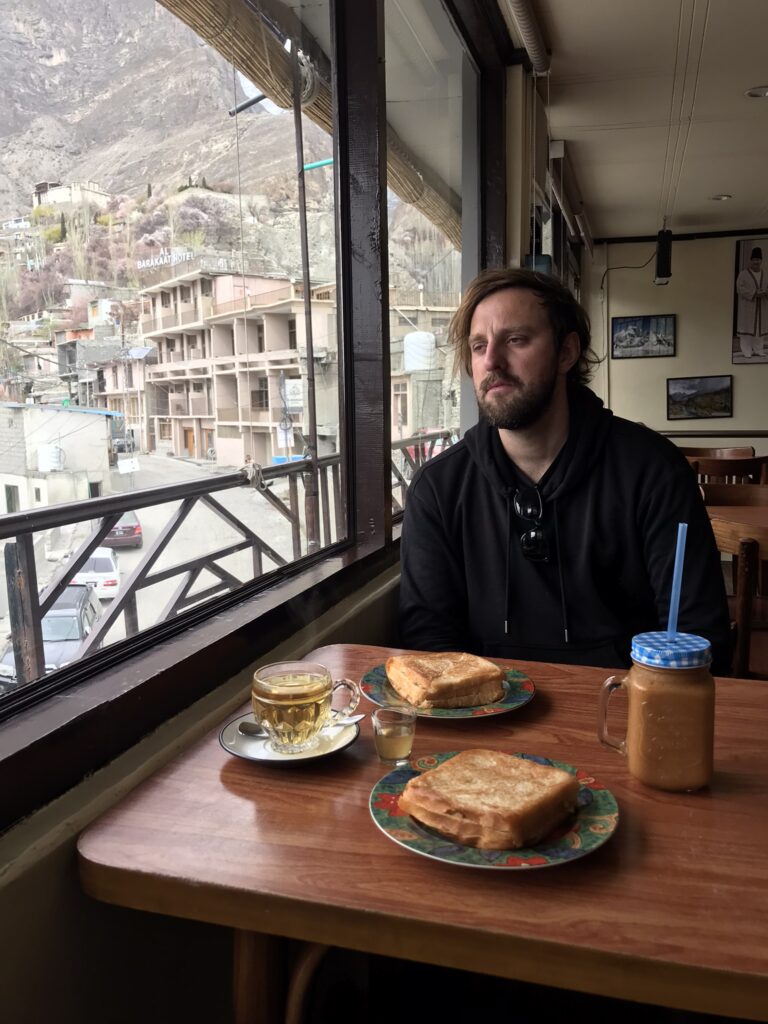
Toasties, apricot juice and chai at Cafe de Hunza is a winner with us
Hidden Paradise (Altit Branch) – located right next to the entrance to Altit Fort, we were recommended this place by our host Noushad and weren’t disappointed. An excellent choice if you’re looking for filling and delicious local Hunza food. Try the yak Chapshuro, Dawodo soup and Tzamik potatoes – you won’t be disappointed. The view from the upper terrace over the mountains and blossom trees was great, service was friendly and card payments were possible too which was the icing on the cake. Strangely, this place was completely empty both times we visited. I’m not sure why as this was probably the best restaurant we visited in Pakistan.

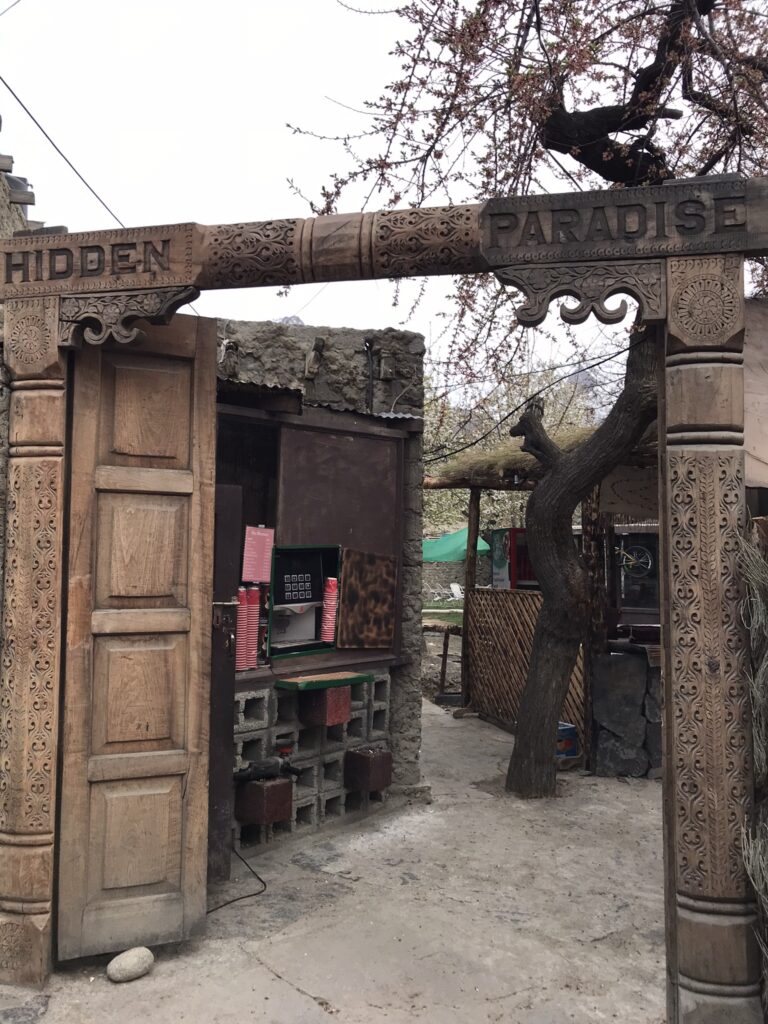
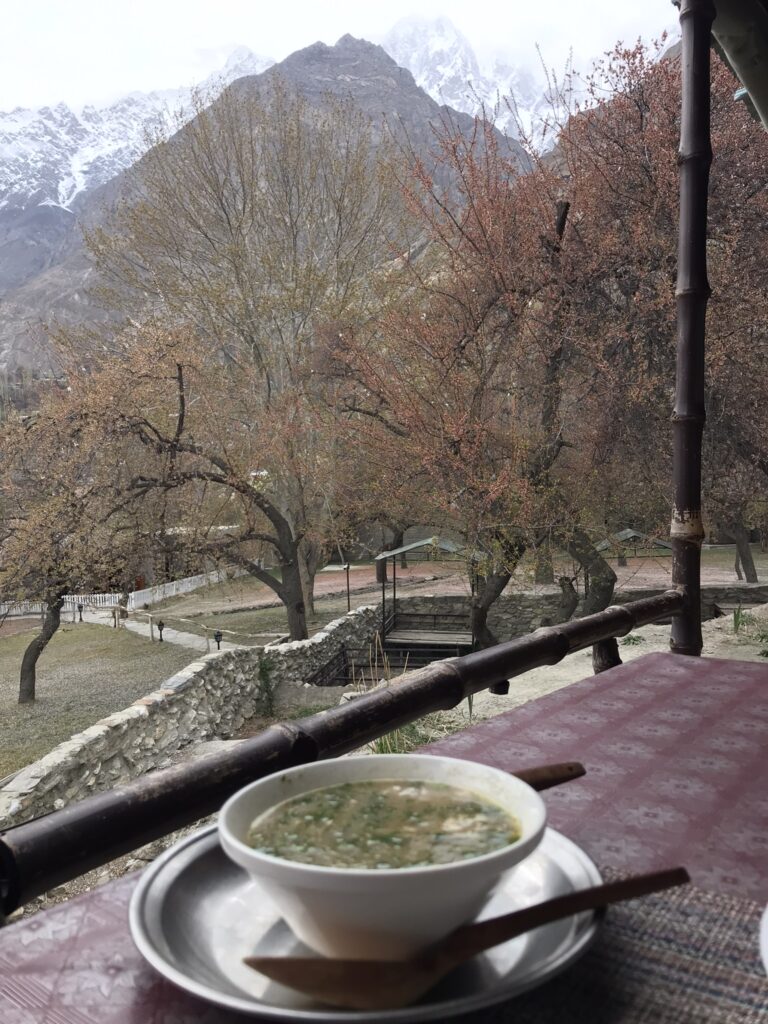
Dawodo soup and yak Chapshuro at Hidden Paradise
Pizza Pamir – ‘the’ place in Karimabad for all things pizza related – don’t miss trying their speciality, yak pizza! It’s a large, snazzy restaurant offering both eat-in and takeaway. We were able to sit down and wait inside the restaurant while waiting for our takeaway pizza to be cooked, which was a nice touch.
Activities
Baltit Fort and Altit Fort are both walkable from Karimabad. For all the other attractions in the region you will need access to a vehicle. As with Skardu, I recommend asking at your guest house as a first port of call. We were able to arrange transport with our guest house owner, Noushad, which worked out great.
We spent 3 days in Karimabad and structured our time as follows: Day 1: Baltit Fort and Altit Fort (walking), day 2: Passu and surroundings, day 3: Ganish, Hopper Valley and Eagle’s Nest
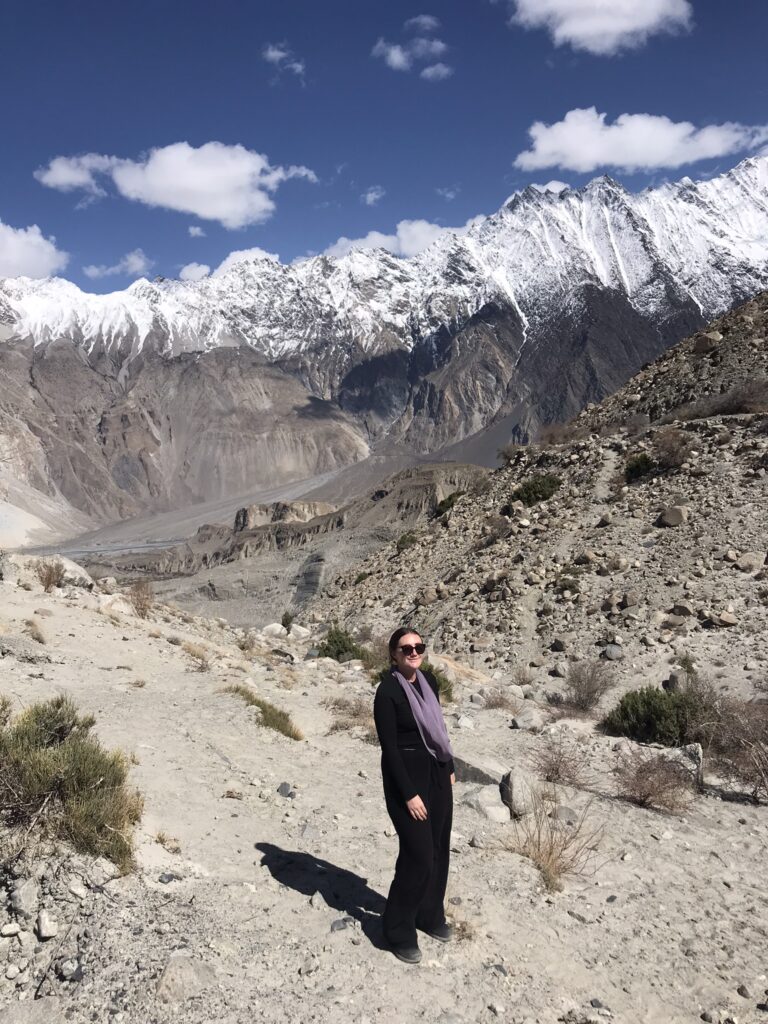
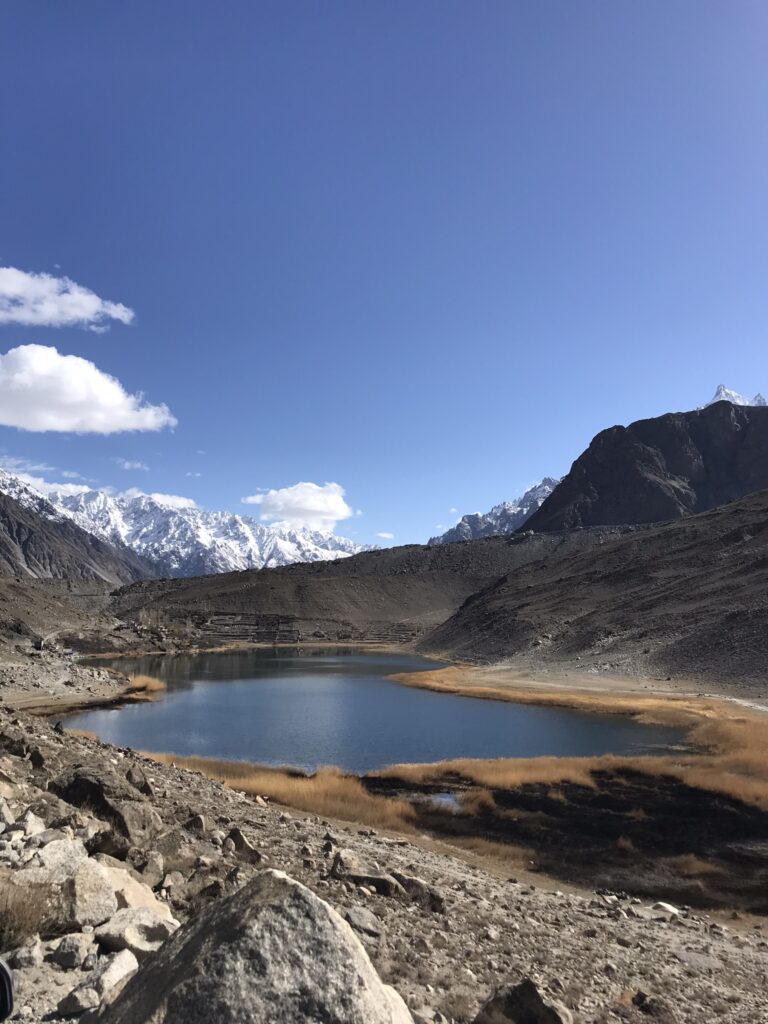
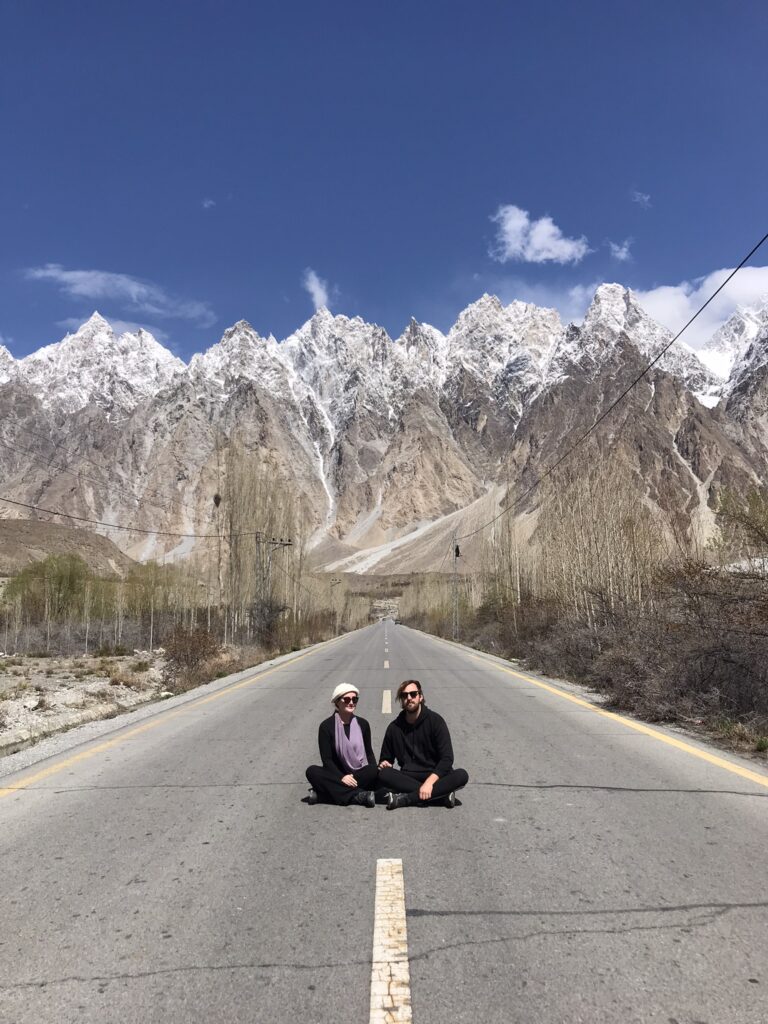
The Passu area makes for a great day trip from Karimabad
Karimabad & surroundings
Baltit Fort and Altit Fort are both on the tentative UNESCO list and offer a glimpse into the Hunza region’s royal past. Both forts can be reached by foot from the center of Karimabad. Baltit Fort is located within Karimabad itself while Altit Fort requires a walk to the nearby town of Altit. It took us about 45 minutes to walk from Baltit Fort to Altit Fort at a leisurely pace, with some spectacular views along the way. As Baltit is the higher of the two forts I recommend visiting that one first and then walking downhill to Altit. Tickets for both forts are a tad on the expensive side at 2000 rupees for Baltit and 1650 for Altit.
The route up to Baltit is paved but extremely steep so you may need to take a rest break at one of the numerous stalls along the way. Inside there are ample information plaques explaining the functions of the different rooms, which are replete with odd bits of furniture and cooking utensils. Beware of the uneven floor and low wooden doorways. Of particular interest inside are a family tree of the Aga Khan, a gallery of the Mirs of Hunza (the local ruling family) who up until 1945 lived in the fort, royal attire, Russian rifles which were acquired by the Mirs and at times used to defend the fort, and various treaties with China (written in Chinese script) establishing that the Hunza region had diplomatic ties with China well before the arrival of the British in the Karakoram mountain range.
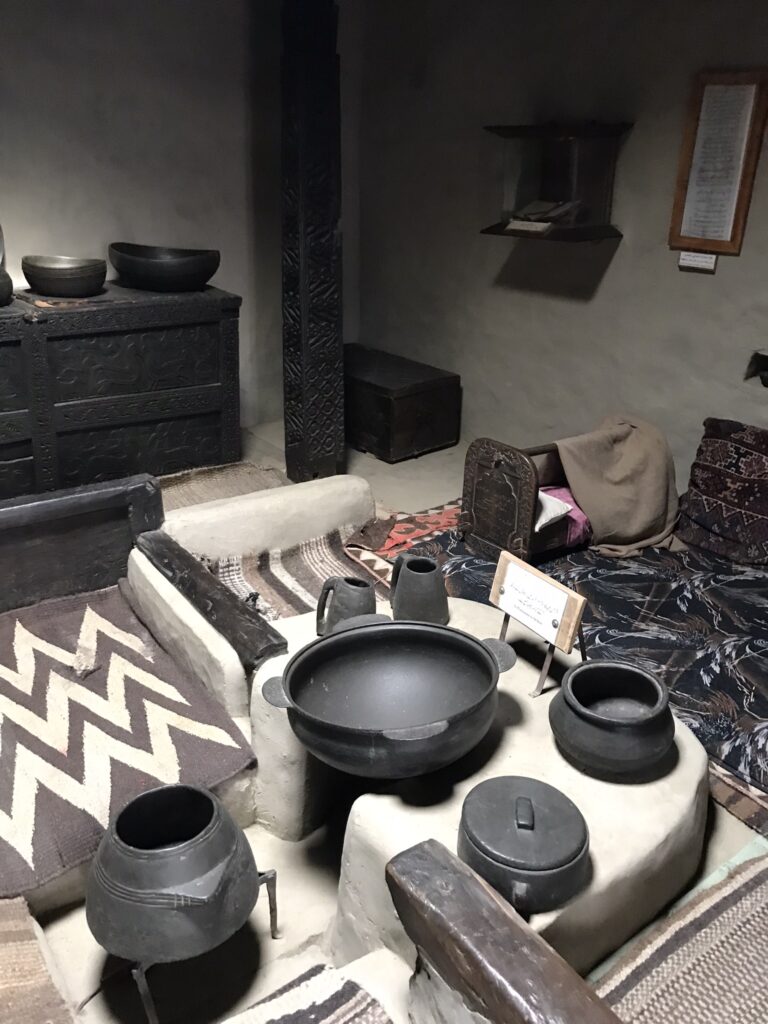
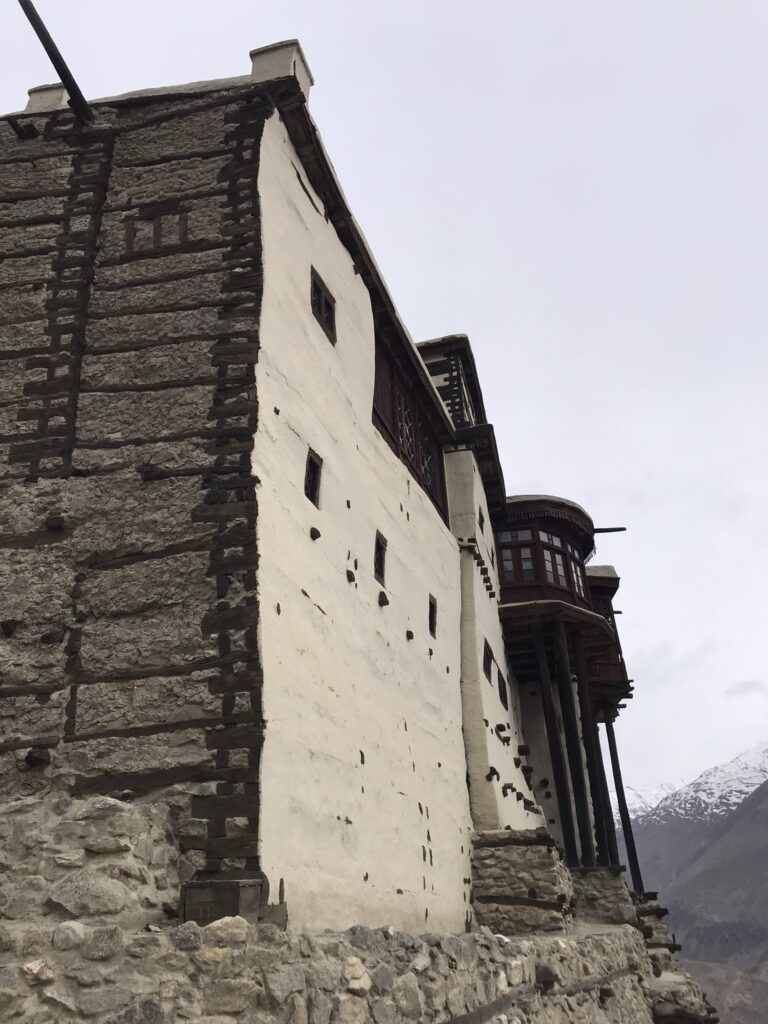
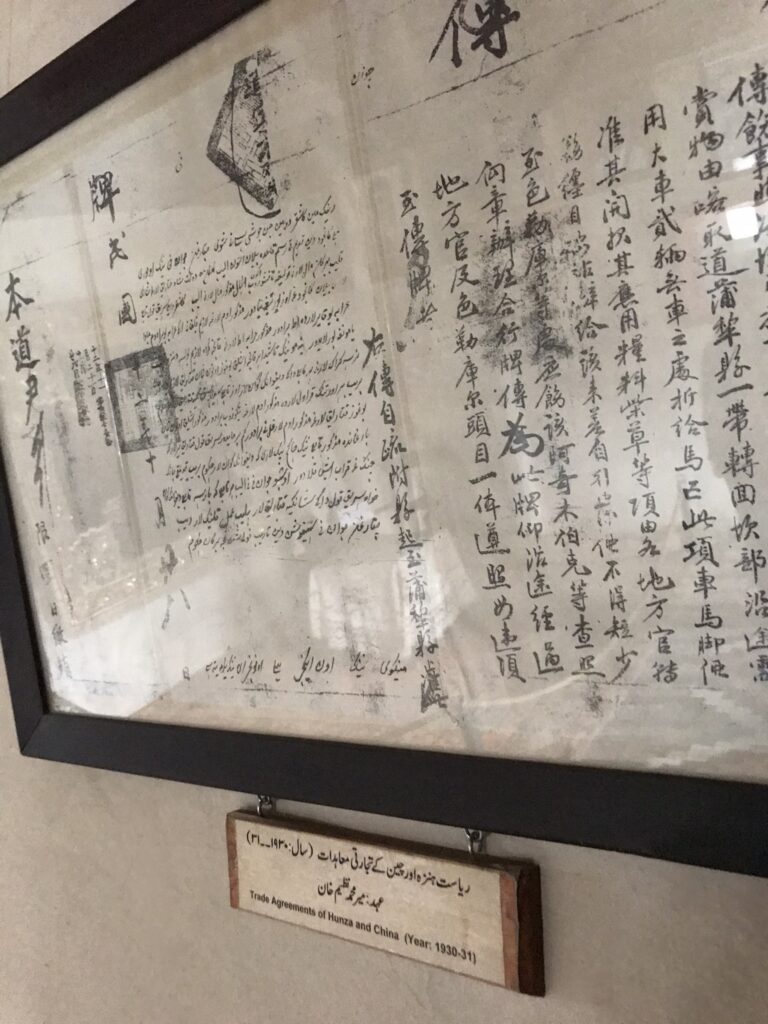
Architecture and artefacts at Baltit Fort
From Baltit Fort, head down the hill and take the Sultan Abad road located next to Cafe de Hunza to Altit, crossing over the only bridge which links Karimabad and Altit. Altit Fort is situated inside an old citadel that is now a little self-enclosed neighbourhood of Altit town, complete with a smattering of souvenir shops, cafes and separate residential area (which includes a sign instructing tourists not to take pictures or enter the residential area).
Altit Fort predates Baltit Fort by a few hundred years. It is said to have been built by craftsmen from Baltistan who accompanied a Baltistan princess as part of the dowry when she married the crown prince of Hunza. The fort’s tower is reported to be the oldest surviving standing structure in Gilgit-Baltistan at over 1000 years old. It’s constructed in the traditional wooden cribbage and cator style (almost like a jenga set with a wooden layer and then a layer of stone) to withstand seismic activity.
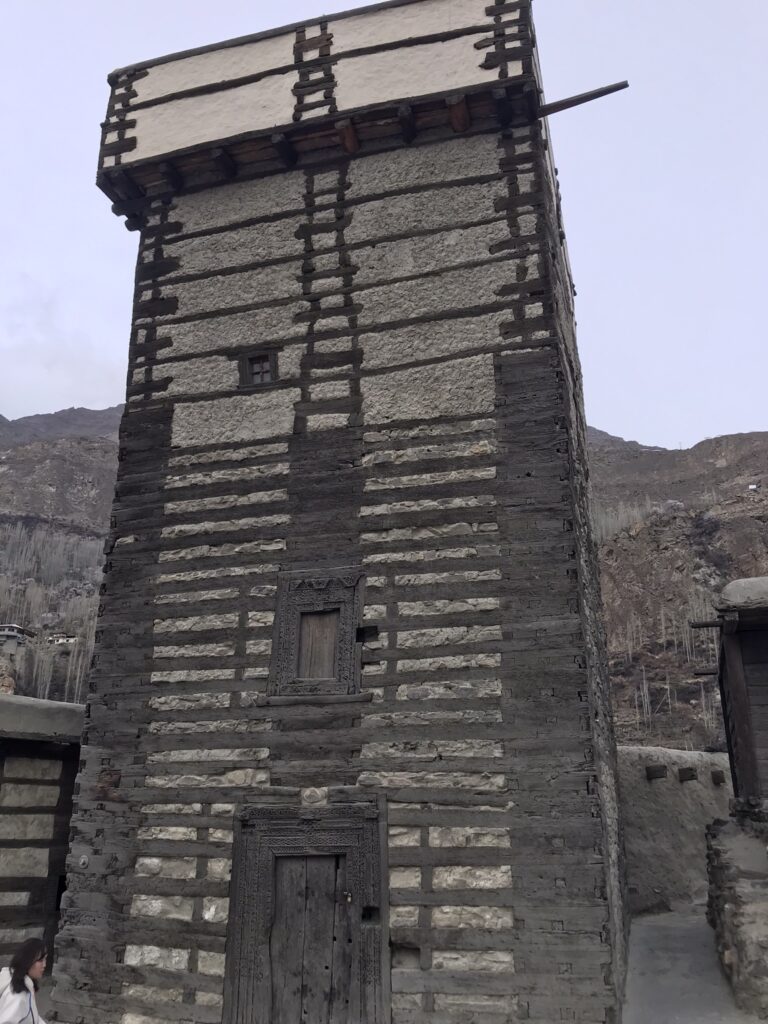
The ‘Shikari’ tower at Altit Fort
The fort was used to control access to this portion of the Silk Road, which ran along the route of the modern Karakoram Highway. Although it is at a lower altitude than Baltit Fort, Altit is built atop a 200-meter high sheer cliff face facing the Hunza Valley and river, making it arguably an even better vantage point. Following the construction of Baltit Fort, Altit was used as a lookout point and defence garrison.
The entrance path to the fort takes you through a stunning apricot orchard which offers picture perfect views during the blossom season. There are noticeably less information plaques in Altit Fort so it’s best to join a group tour if offered as they’re fun, informative and best of all, included in the ticket price! We certainly had a lot of fun tagging along with a Singapore tour group! Don’t skip the photo gallery towards the end of the tour as these fascinating black-and-white photos show a glimpse of local life in the 1930s. If you’re feeling hungry after the visit and want to try some local food you can stop by Hidden Paradise restaurant, which is just next to the entrance of the fort.
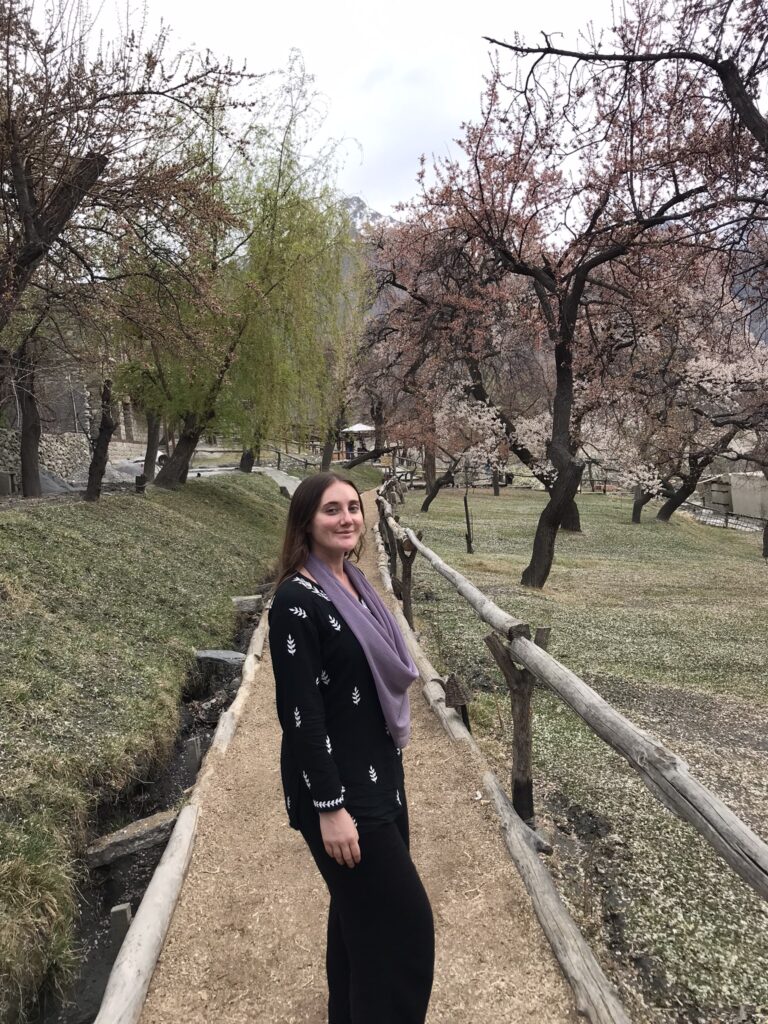
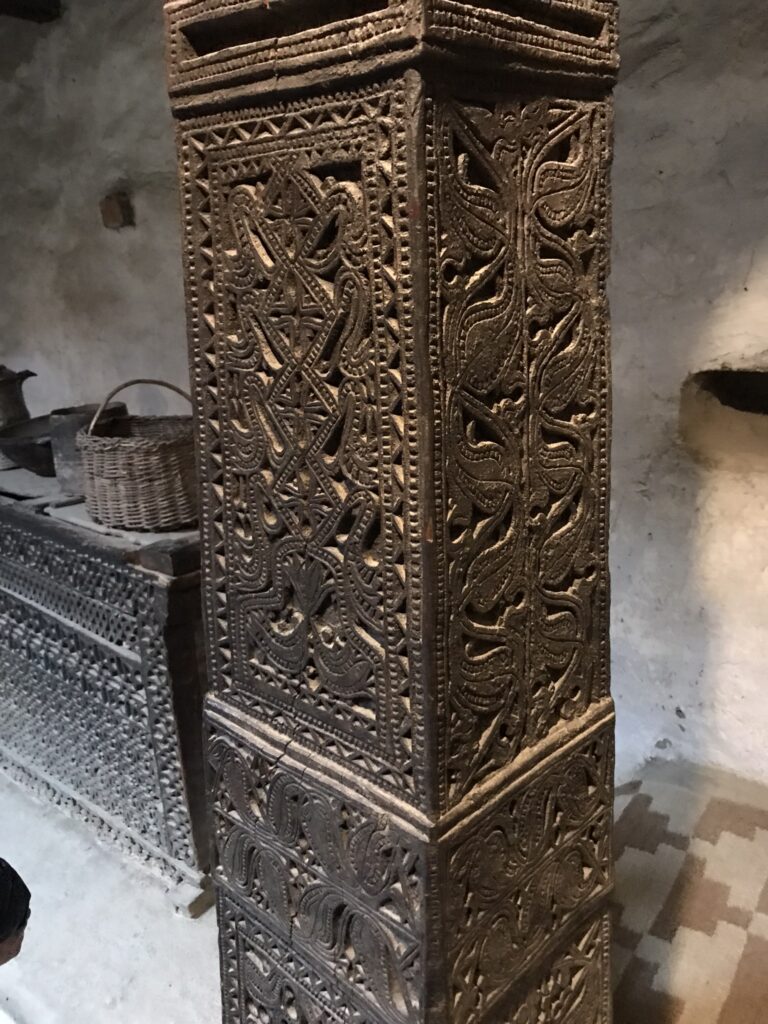
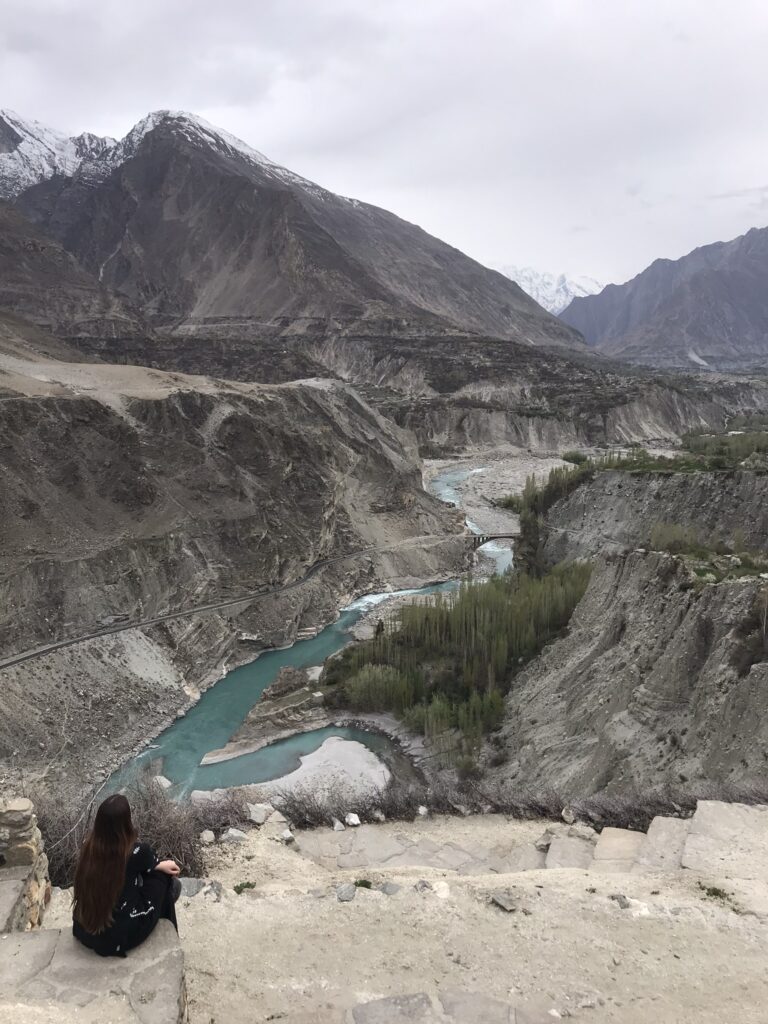
Views from inside and outside Altit Fort
Eagle’s Nest Point – high above Altit is the settlement of Duikar, also known as Eagle’s Nest. Along with a smattering of guesthouses, restaurants and an area containing a solar power project, this area contains one of the best viewpoints in the region. This spot provides breathtaking views over the Hunza Valley and is a popular place to catch the sunset. We saw crowds of East Asian tourists jostling for space to set up their expensive-looking camera tripods, ready to capture the last rays of the sun over the mountaintops. Entry is free – the hardest part is getting up there as it is incredibly high up and the roads up to the viewpoint are rather narrow and treacherous, with space for one car only. We saw some tour buses transporting the East Asian groups which were struggling.
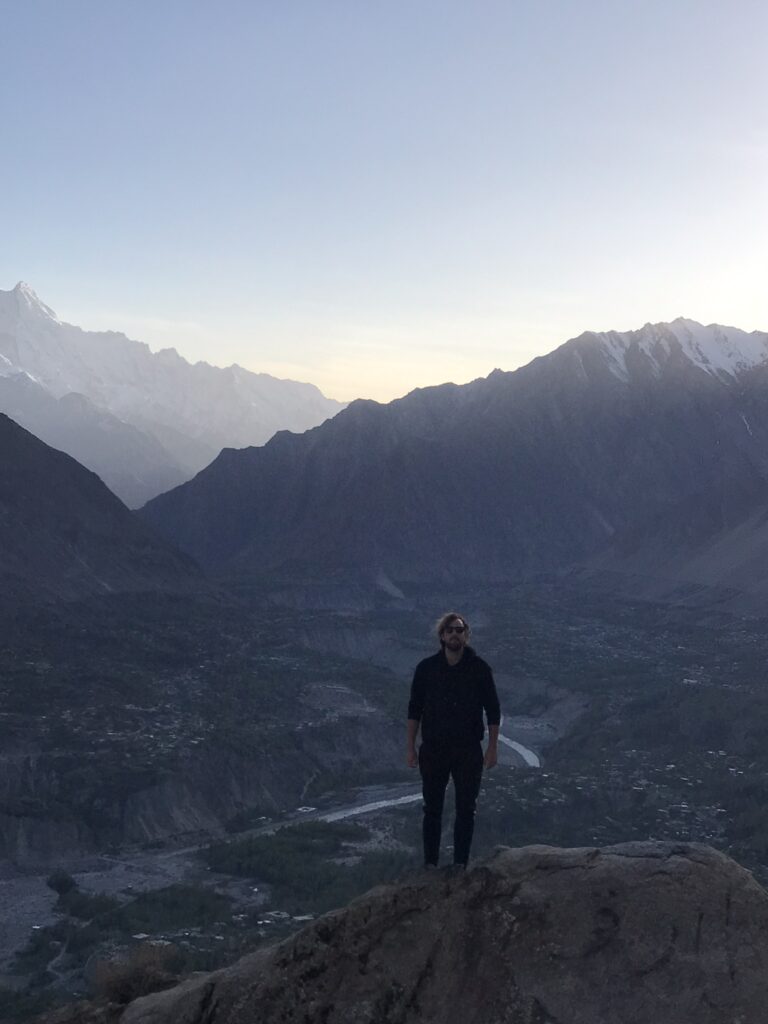
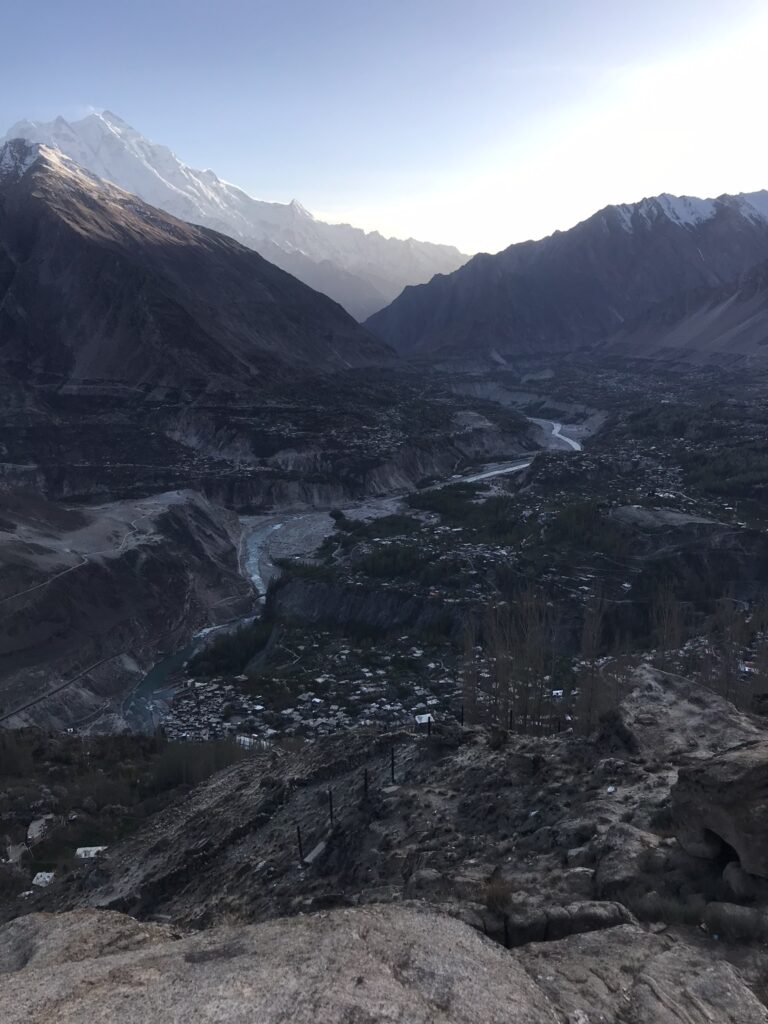
Eagle’s Nest Point really is very high up
Ganish village – downhill from the modern town of Karimabad sits Ganish, a village that contains an ancient fortified township dating back to the heydays of the Silk Road. This is said to be the earliest settlement in the Hunza region. Although the name sounds similar to the Hindu god Ganesh, it is more likely that it was taken from the local Burushaski word for gold – although interestingly there are also some Hindu elements visible in the village. The fortified town is now a tourist site with paid entry, although people still live in parts of the ancient settlement. The site isn’t as big or impressive as Baltit or Altit Forts but it does contain some of the same architectural style, and the ticket price includes a guide who pointed out many finer details that we would’ve missed.
400-year-old wooden mosques still survive to this day in Ganish despite harsh weather conditions and floods, with delicate wood-carvings on the pillars and door posts. We were intrigued to see that as well as Islamic motifs, you can also spot Hindu swastikas on the carved wood panels alongside Buddhist lotus designs. It’s clear that many religions were spread along the Silk Road by travellers.
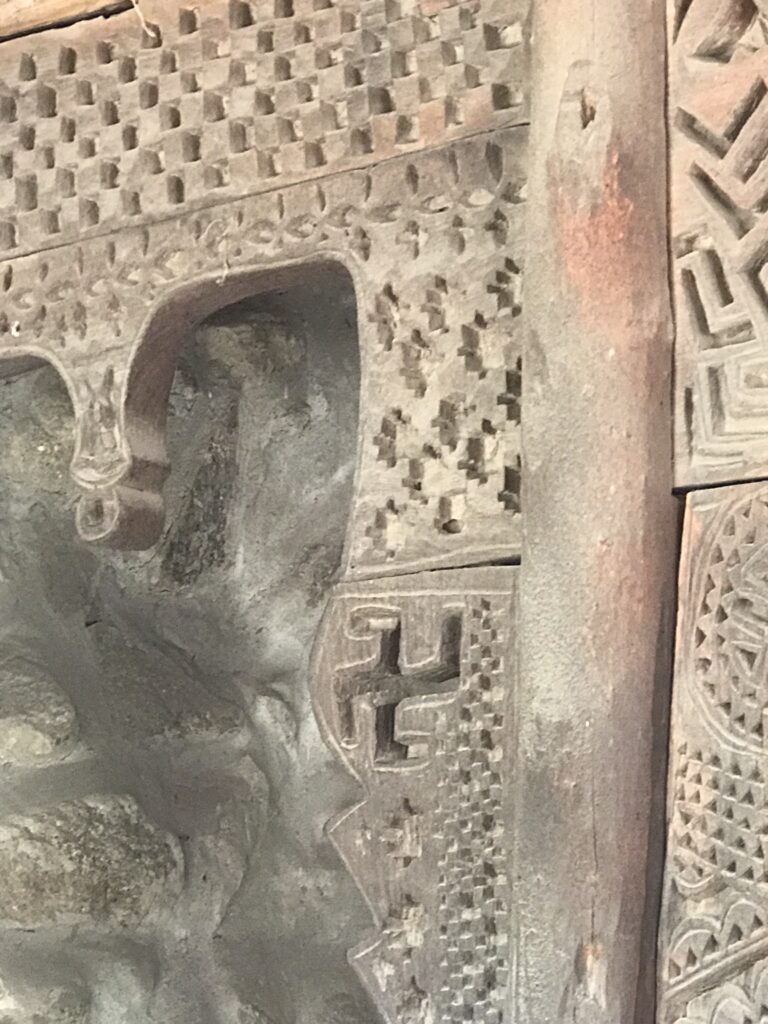
Carved Hindu swastika designs can be found in the mosques in Ganish
We stopped by Ganish en route to the Hopper Valley. It is a small site and only requires about half an hour to take the tour and see in its entirety. Ganish is literally at the bottom of the valley – I wouldn’t recommend trying to go there on foot from Karimabad unless you’re a fan of steep uphill walking to get back up once you’re finished.
Hopper Valley & Hopper Glacier – across the Hunza Valley about an hour’s drive from Karimabad, Hopper Valley is a pleasant place to explore if you have access to a car or someone to give you a ride. The drive up to this area passes through several small, undisturbed local villages – it was intriguing to observe life in these villages, relatively free from the outside influence of tourism. We also witnessed a small transient community of nomadic tent-dwellers prospecting for gold in the Hunza River – these groups (known as the ‘Sonewal’) apparently isolate themselves from the rest of society in order to follow the river in search of gold and are an accepted presence in the region.
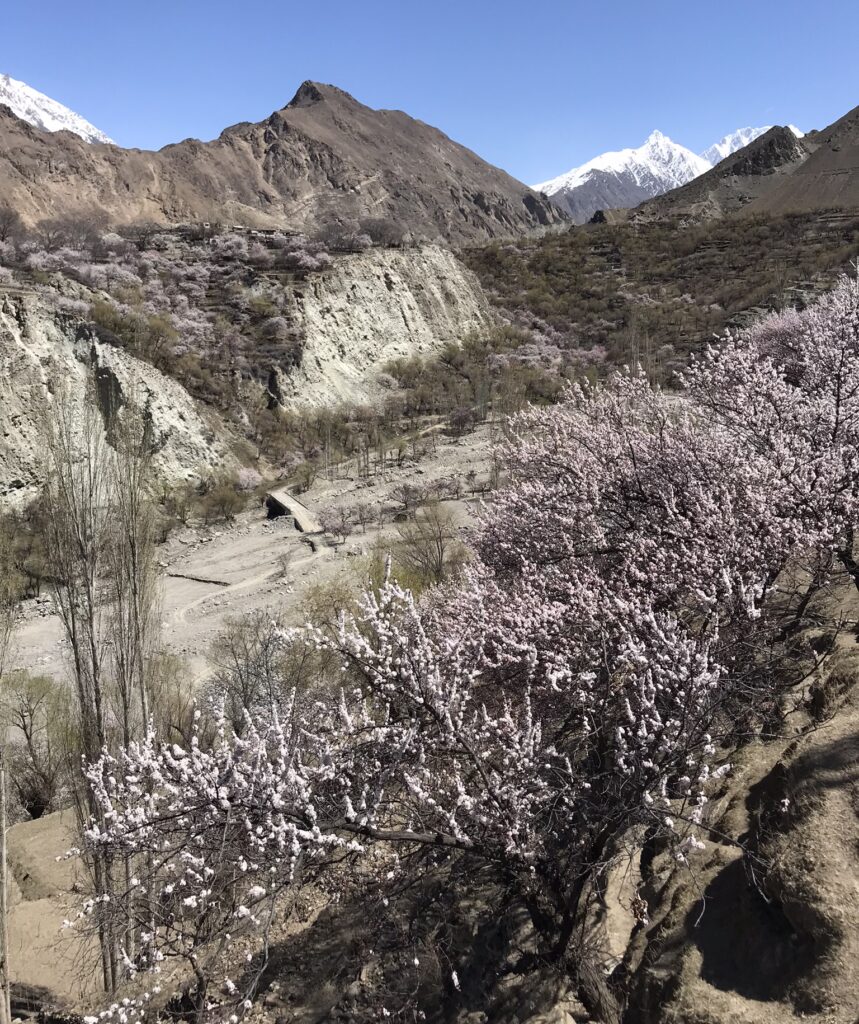
You can find different trees blossoming at different altitudes in Hopper Valley
Bursting with flowering blossom trees, the Hopper Valley is a great place to visit in April for the blossom season. The settlement sits at a different altitude to Karimabad and therefore the cherry and apricot trees blossom slightly later than the rest of the area. At the end of the road in Hopper village, the area becomes a little more touristy with a few guesthouses, chai houses and tourist restaurants as the Hopper Glacier comes into view. We spotted many gemstone dealers in Hopper along the path to the main glacier viewpoint, eagerly displaying their wares for the East Asian tourist groups.
Compared with Passu Glacier, Hopper Glacier is much darker in appearance, almost like a cooled lava field extending down the mountainside. It makes a dramatic backdrop for photos. Coloured flags line the walkway up to a viewpoint – we couldn’t help but think of the colourful prayer flags at Buddhist temples.

Life goes on undisturbed in the villages around Hopper Valley
Passu and surroundings
From Karimabad we took a day trip to the Passu Cones and some other sites north of Hunza. In a single day we were able to fit in Attabad Lake, Passu Cones, Yak Grill for lunch, Glacier Breeze for apricot cake and chai, Passu Glacier, Hussaini Suspension Bridge and sunset at Bucolic.
Attabad Lake – a breathtakingly picturesque lake with gleaming tranquil turquoise waters. Belying its peaceful appearance, this was once a site of tragedy. The village of Attabad once stood where the lake now stretches but a disastrous landslide in 2010 destroyed the village and killed some of the villagers. It’s since become a popular spot for water-based adventure activities like jet-skiing and boating, and also a holiday destination with an abundance of luxury hotels springing up along the shoreline. The lake now stands as a testament to both the awe-inspiring power of nature and the thriving tourist economy.

Attabad – a picture perfect lake with a tragic backstory
Passu Cones – an iconic row of tall snow-encrusted mountain peaks – they almost seem to pierce the sky with their sharp peaks. This is arguably the most famous landmark in Gilgit-Baltistan and along the Karakoram Highway. The cones are truly stunning. It’s impossible not to stop for photos and gawk at the extraordinary mountain vistas. At the end of the day, you’ll find it a real challenge to leave like we did.
To get the best views, try to pick a clear day as low-lying clouds often gather around the cones, spoiling the view.
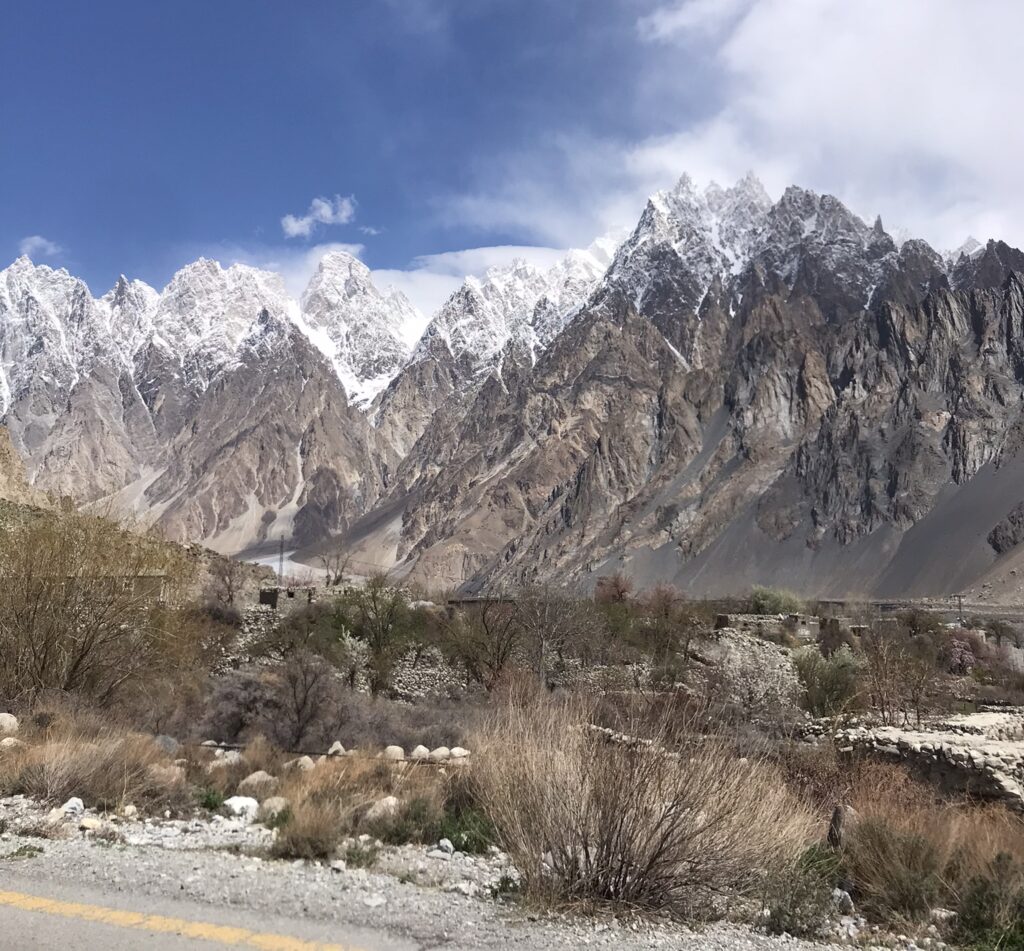
One of the most iconic sights in Pakistan – the Passu Cones
Passu Glacier – to get to the Passu Glacier you need to take the bumpy uneven road towards Borith Lake, passing through the rustic village of Borith. Most of the houses in Borith are still constructed traditionally with local rock rather than brick, driving through here was almost like stepping back in time. Passu Glacier is a short hike from the car park which is a little further on from Borith. There is a small entrance fee to gain entry to the Passu Glacier trail. The trail alone is worth the admission, as it offers stunning views over the nearby mountains before eventually arriving at the enormous, sprawling glacier.
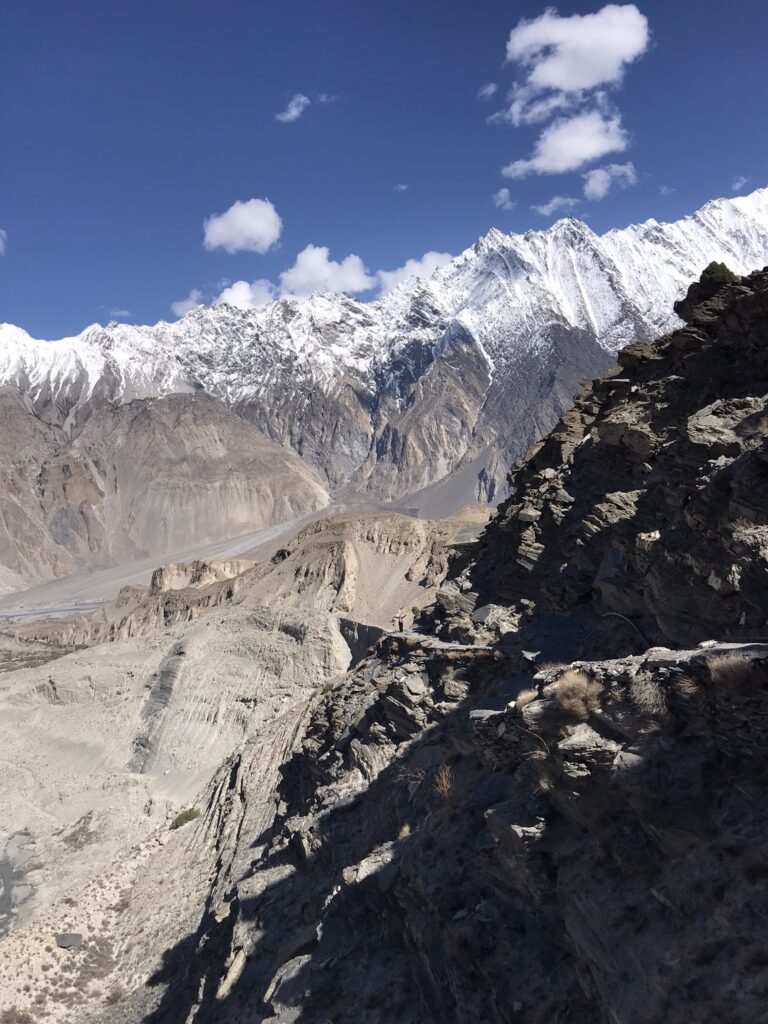
Mind-boggling views on the way to Passu Glacier
The glacier itself isn’t the archetypal ice glacier like the one in El Calafate. In fact, Passu Glacier is a rock glacier which has a bright white appearance. Whereas ice glaciers are frozen, highly pressurised water-ice liable to melt and fall off in shards, rock glaciers are composed of a mixture of ice and debris, including rocks and sediment, and their surface debris cover can give them a rocky appearance.
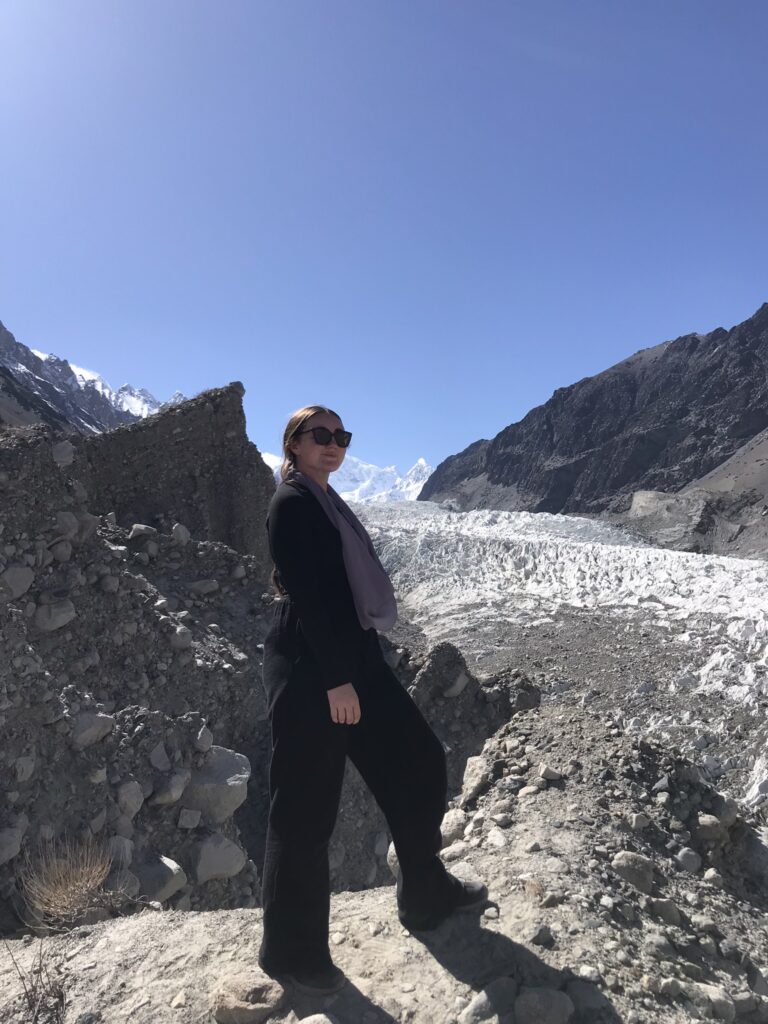

Passu Glacier is a sight to behold
Hussaini Suspension Bridge – walking over the suspension bridge across the Hunza River is a favourite activity for tourists. It’s not for the faint-hearted as there are big gaps between the wooden struts. Apparently a Pakistani tourist died when he fell through the gap and was washed away in the river. Hold onto the sides and try not to look down!
We were a little concerned as there are numerous signs advising of the maximum number of people on the bridge, which seemed to be being ignored by domestic tourists who kept entering the bridge at the same time in huge groups. There are ample cafes and shops situated on the walk to the suspension bridge from the road if you’re in need of refreshments.
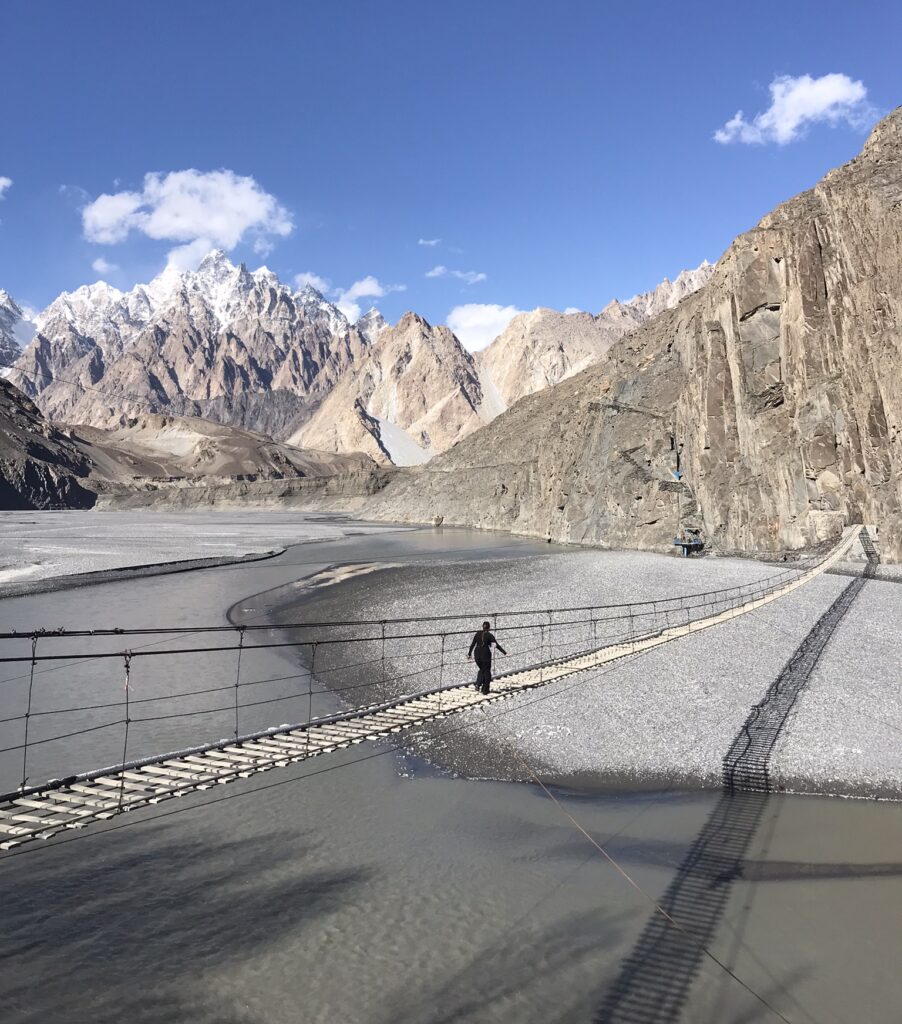
It’s not as fun as it looks!
Foodie Places
For a delicious lunch with a view near to the Passu Cones, head to Yak Grill to sink your teeth into juicy, fresh yak burgers. The owners of the restaurant pride themselves on serving fresh, high-quality yak from their own herd. The burgers were ace and the garlic mayo sauce was spot on! For dessert, you can’t miss heading up to Glacier Breeze for moist freshly baked apricot cake made by a local family and served outside, with incredible views of Passu valley and the cones. I can’t decide which was best: the cake or the phenomenal view from the terrace.
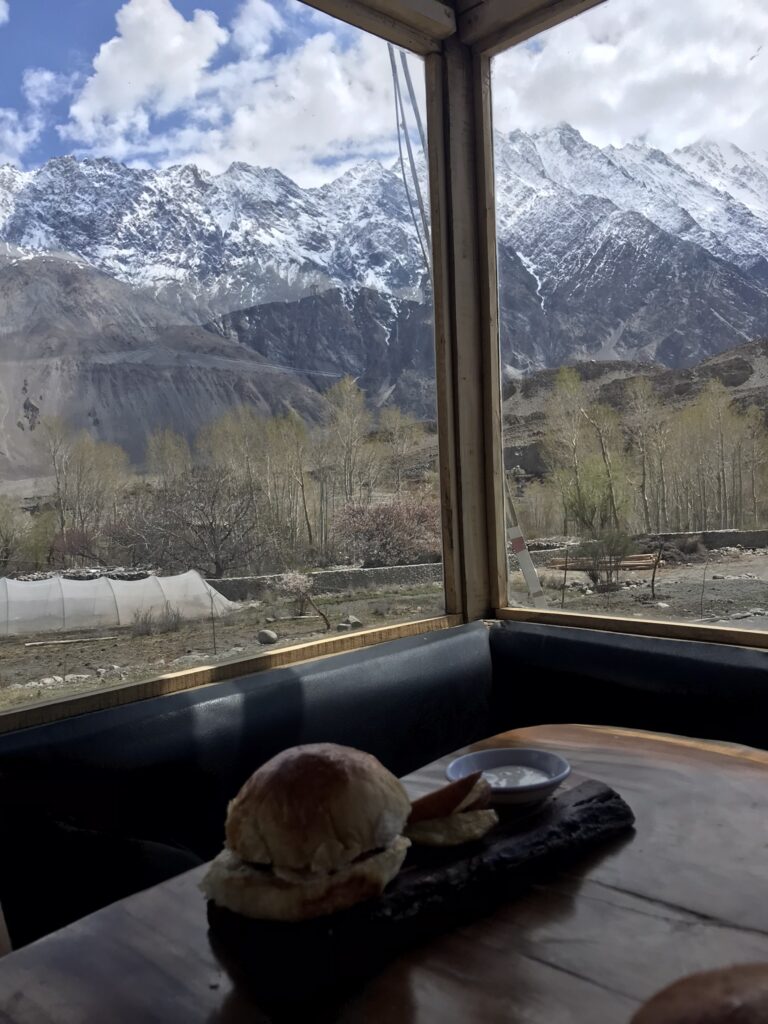
Burgers with a view at Yak Grill
Accommodation
Bucolic – located just off the Karakoram Highway near the town of Gulmit, our host/driver Noushad took us to this guesthouse at the end of the day. We didn’t stay here but I wish we had. As the name suggests, it is a tranquil and introspective place to watch the sunset over the Passu Cones. Seeing the changing light on the slopes of the Passu Cones was an unforgettable experience. If you have time, I highly recommend spending the night here for that back-to-nature feeling and to enjoy this cosy spot by the river. We met the owner, Shakeel Ahmed, an interesting conversationalist and enigmatic host who designed and built the resort himself using traditional building techniques. Shakeel is a member of the Wakhi ethnic group and it was interesting to talk to him about his culture and the differences with the Burusho.
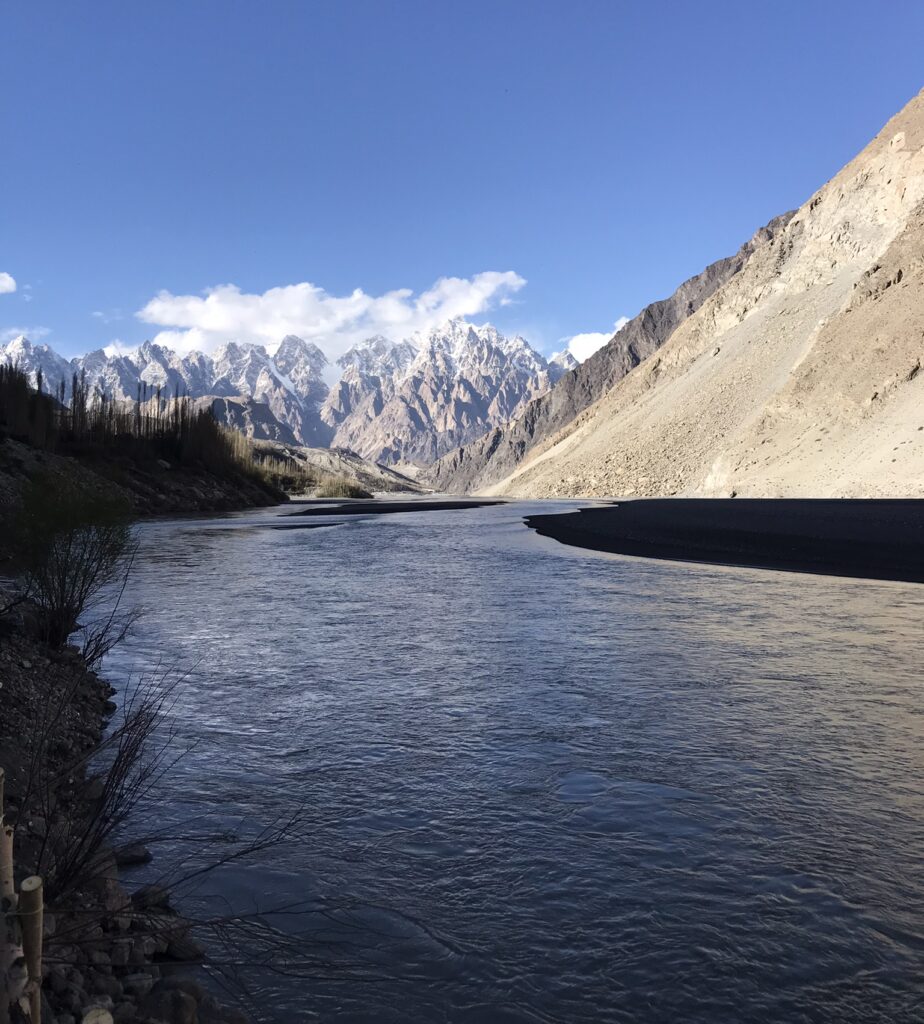
The view from Shakeel’s garden at Bucolic
For more South Asia content, check out my Destinations & Itineraries page!
